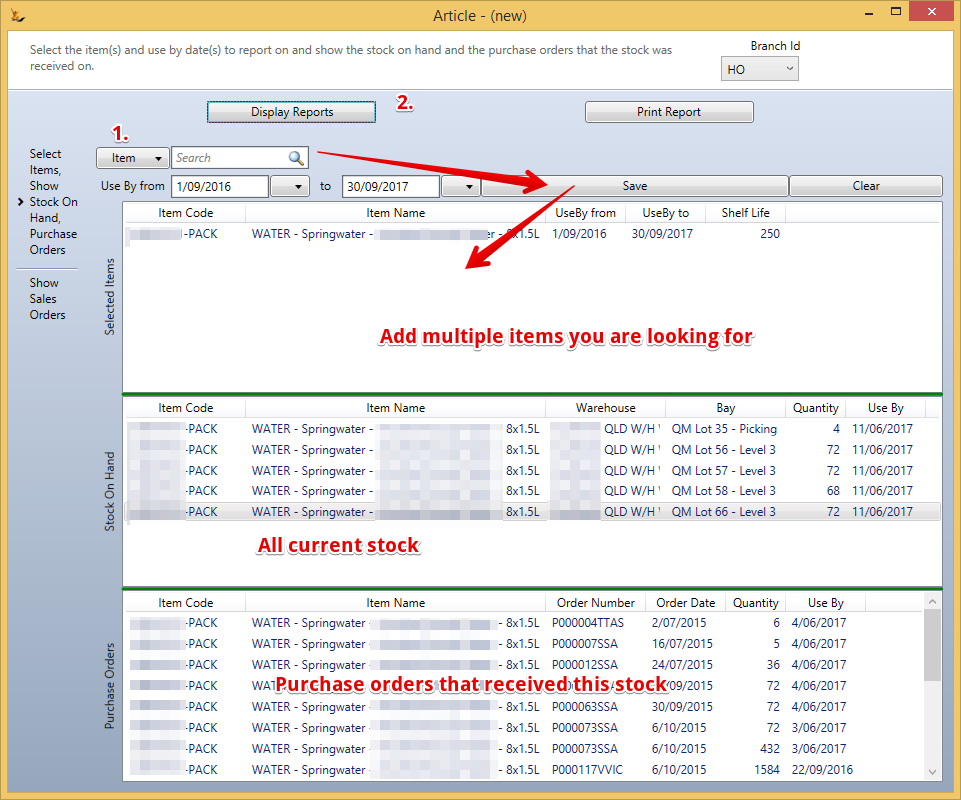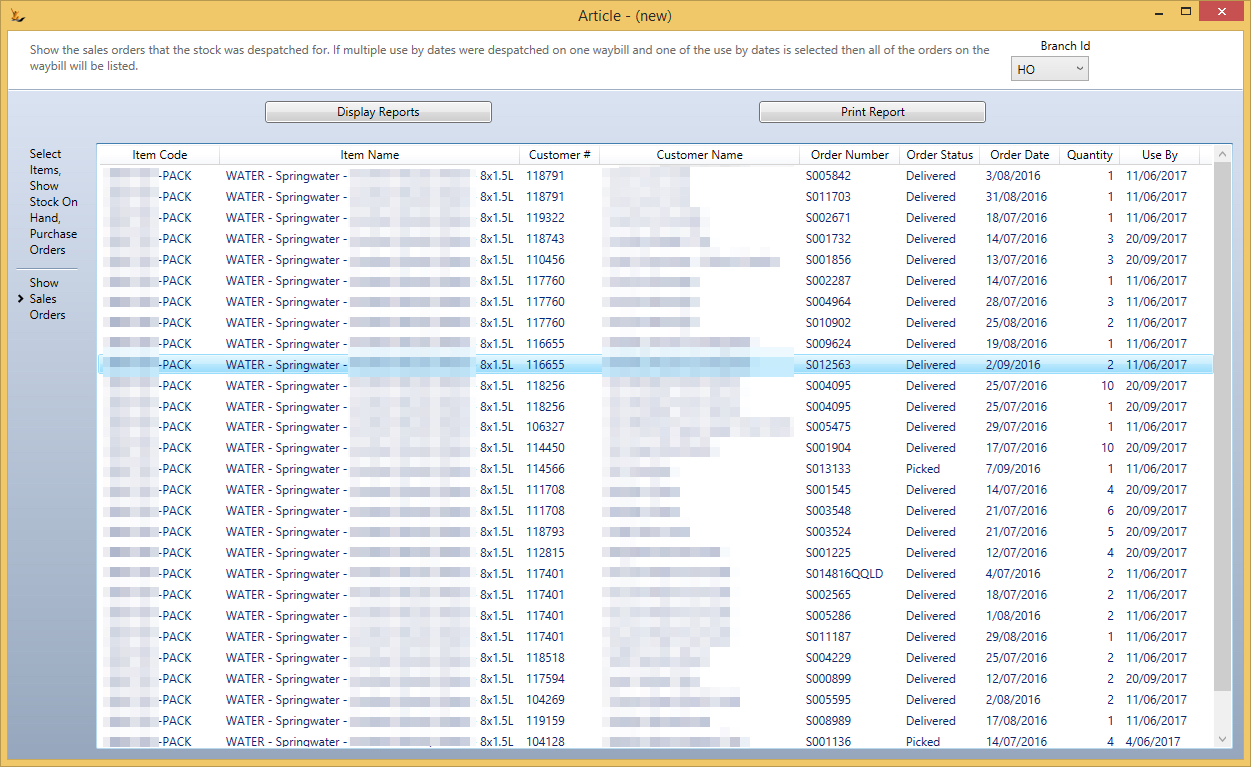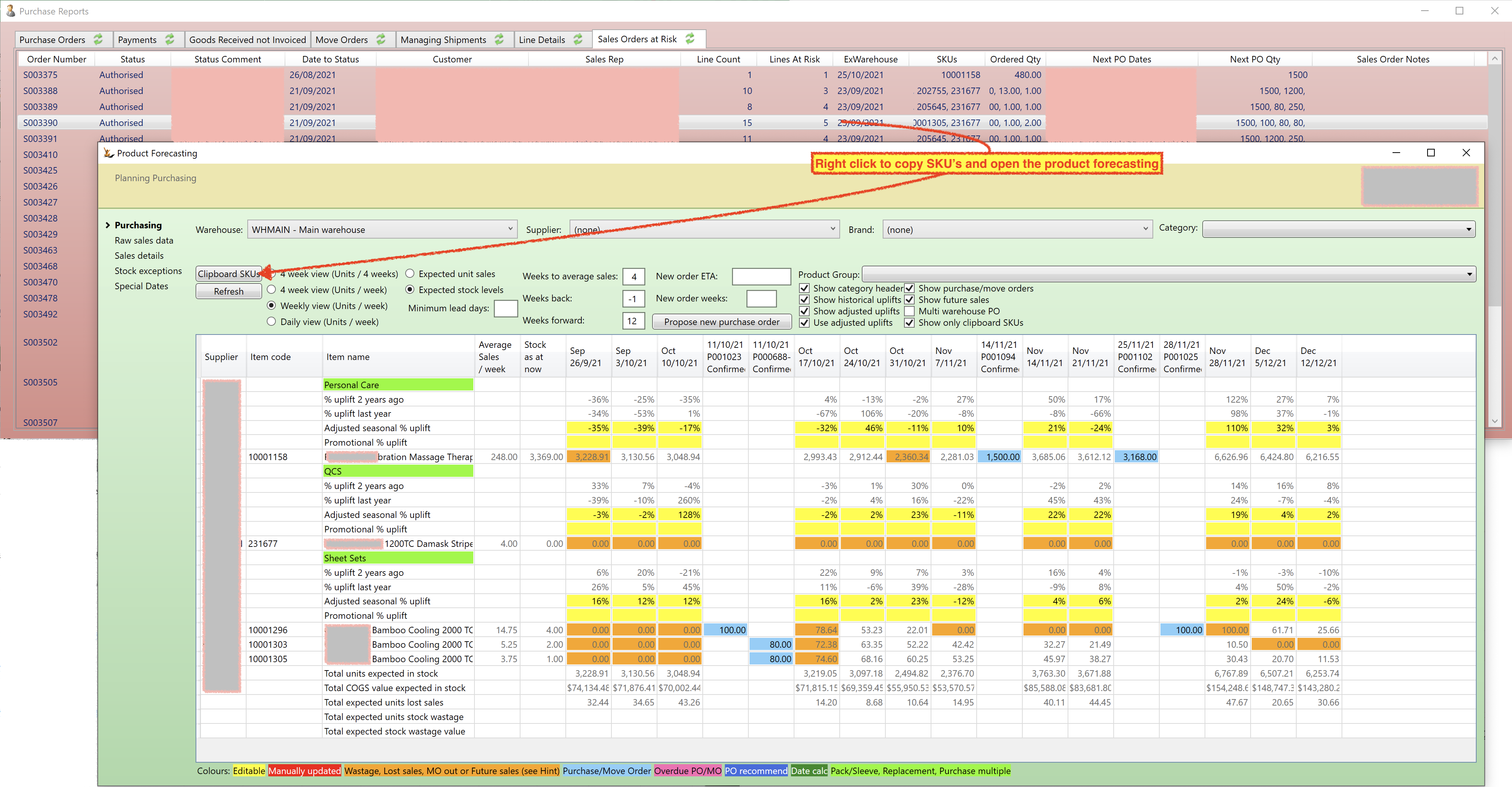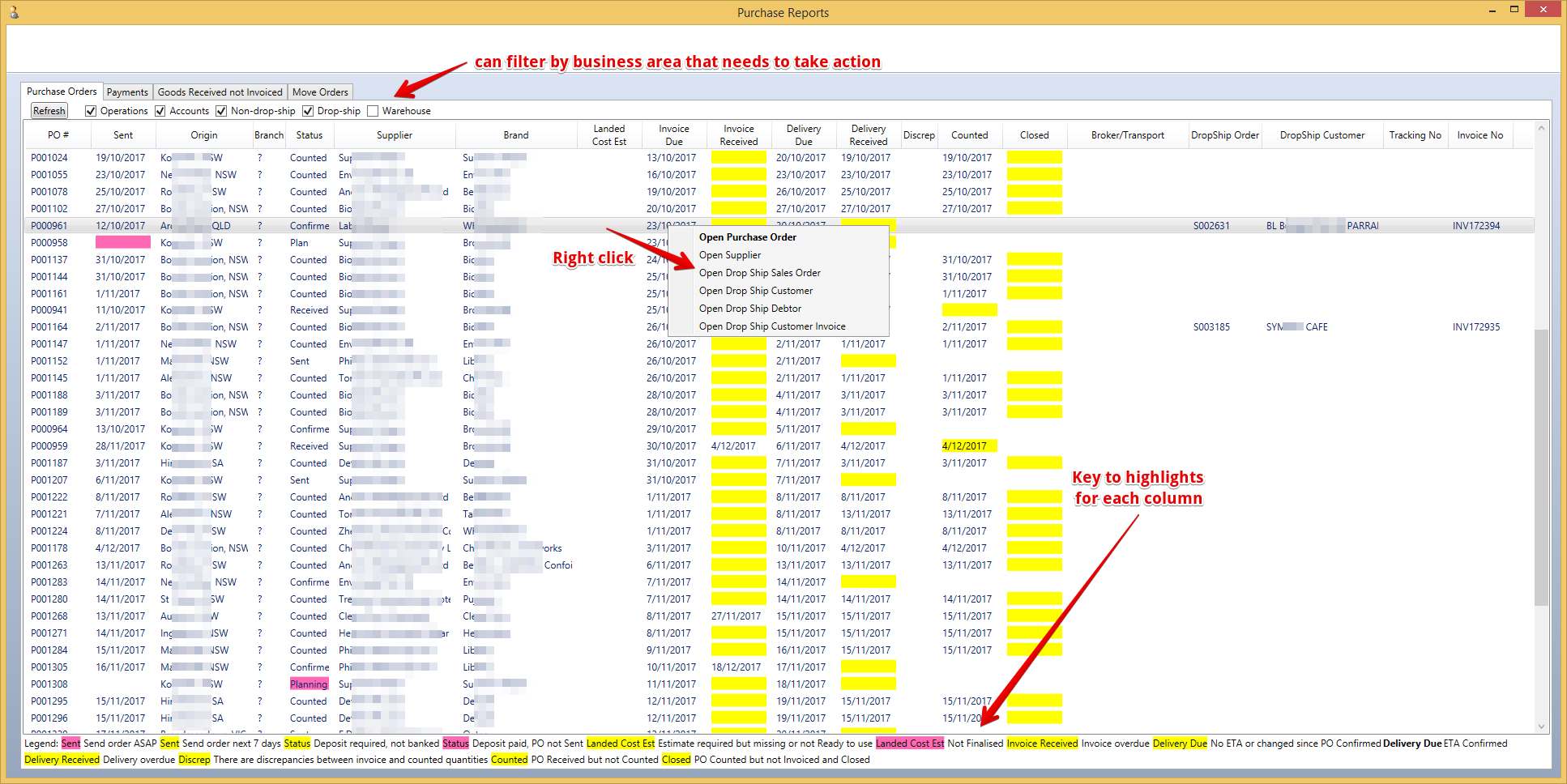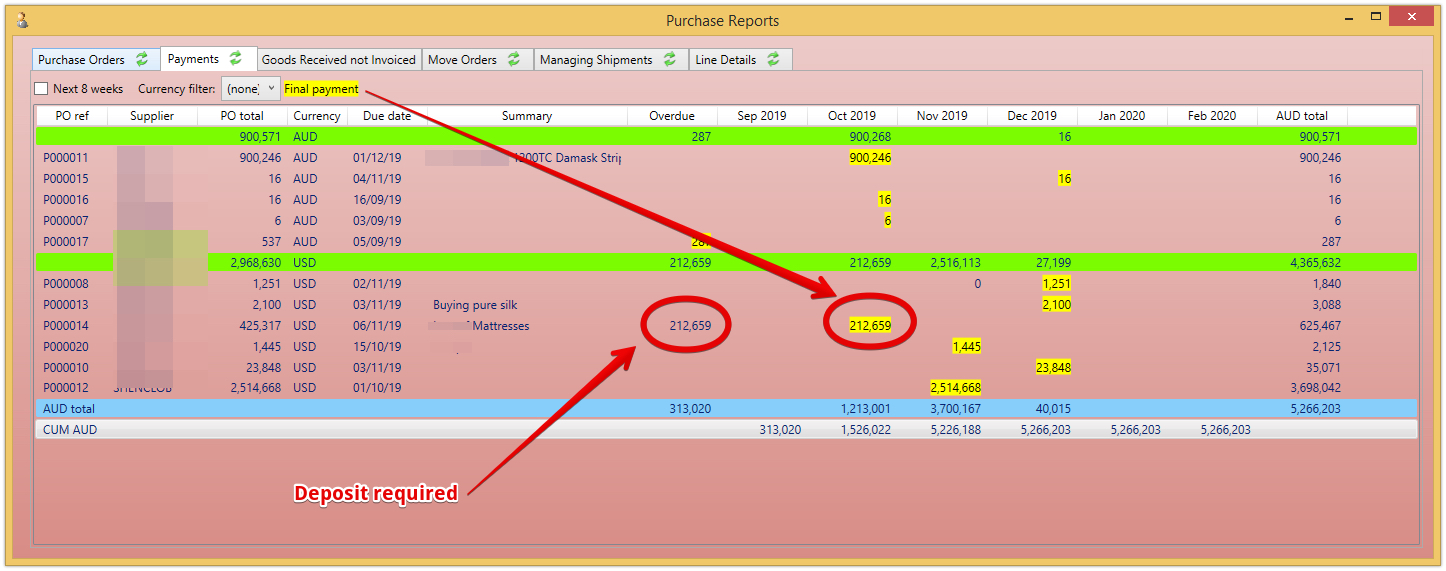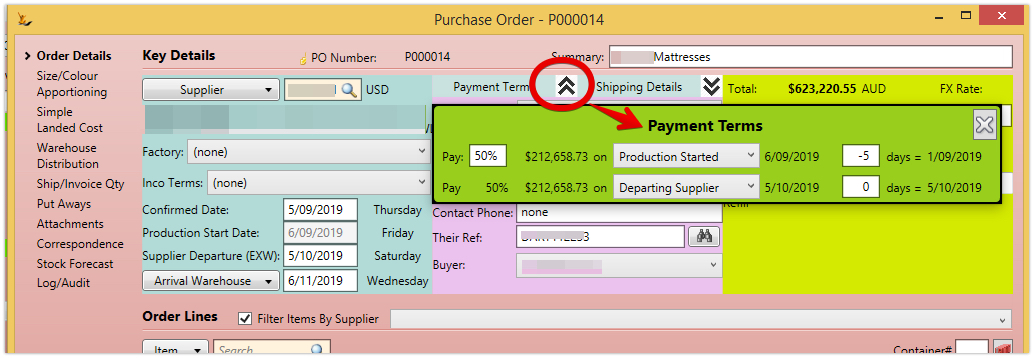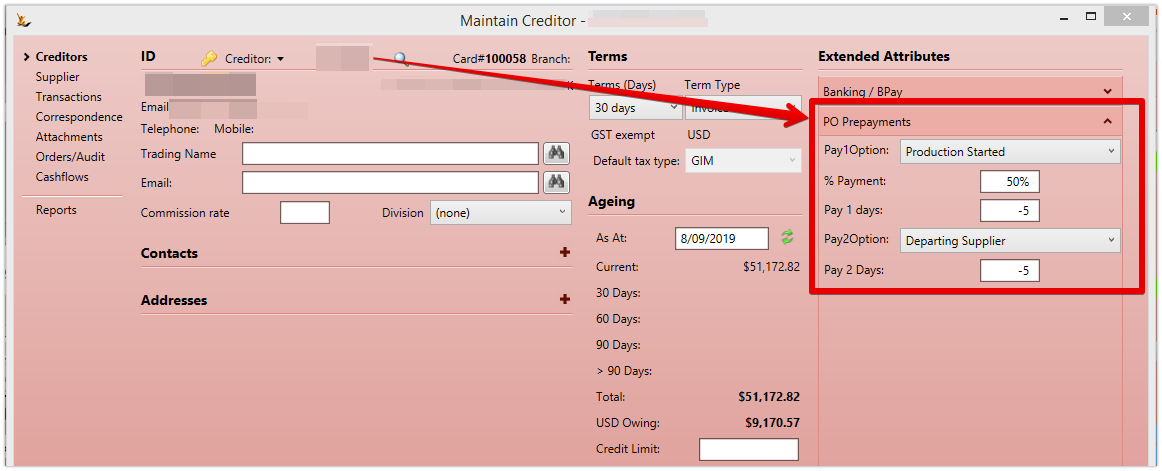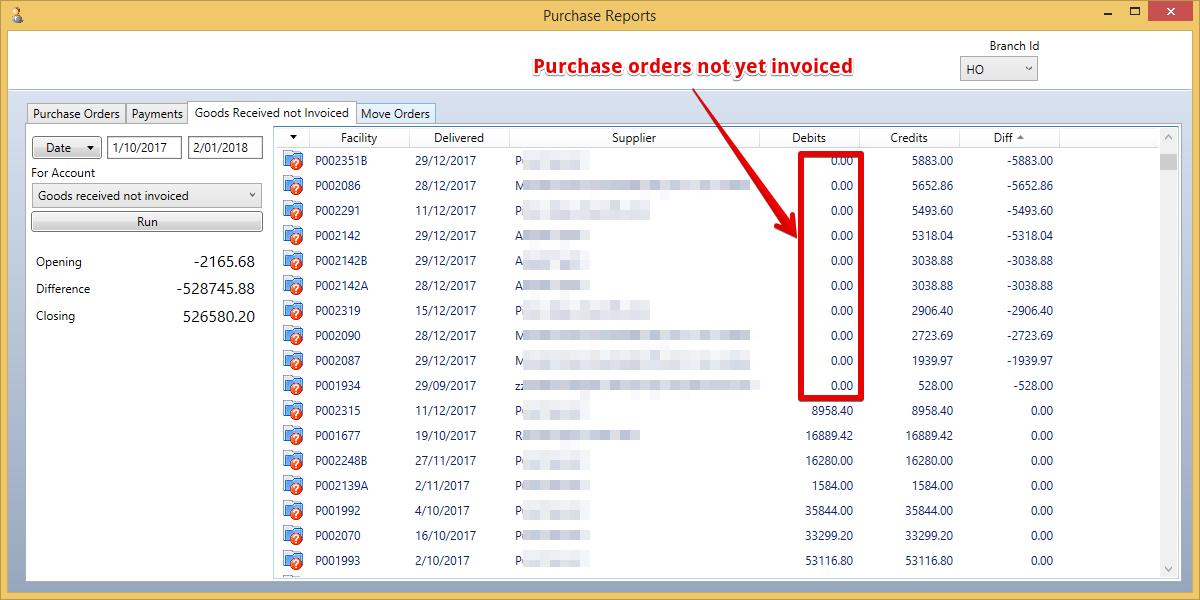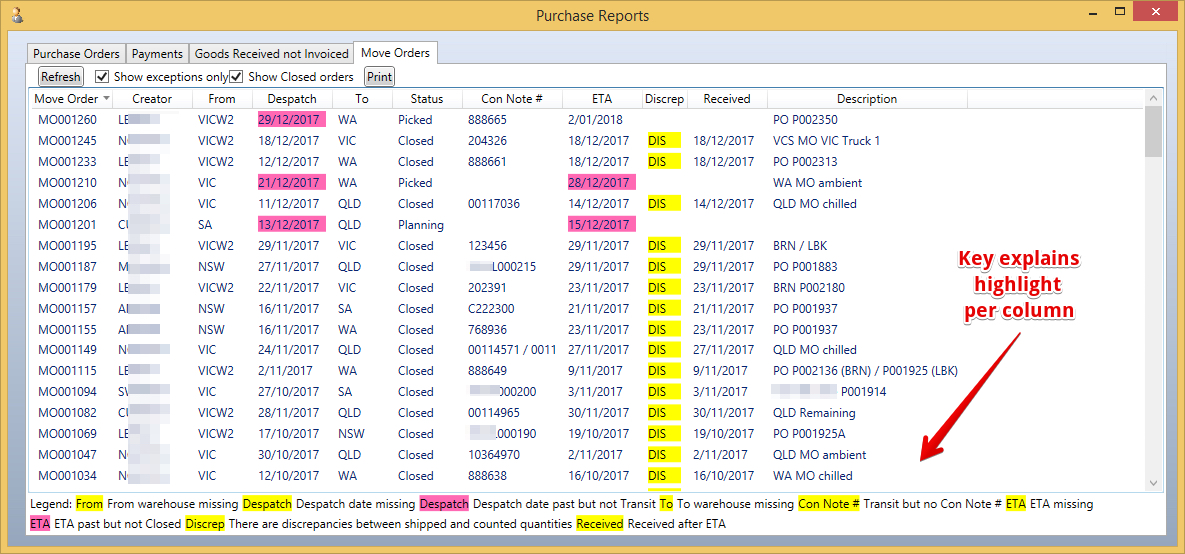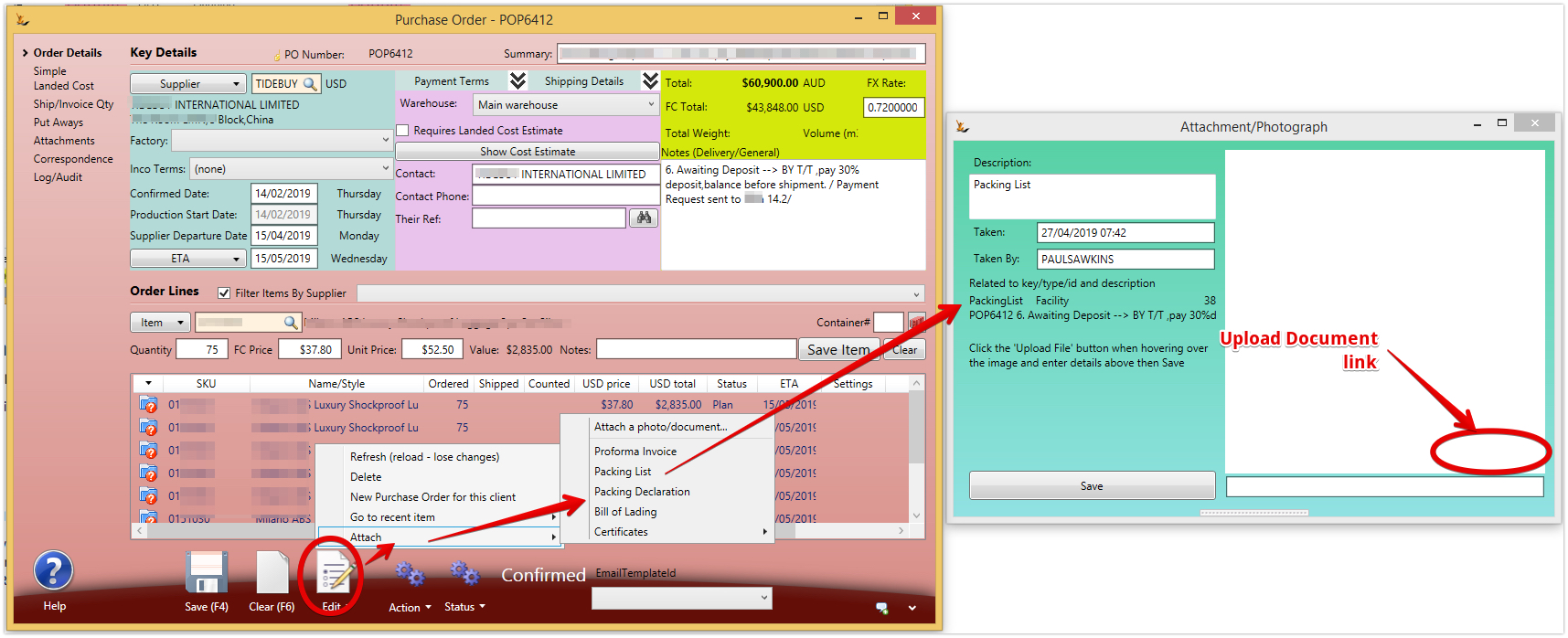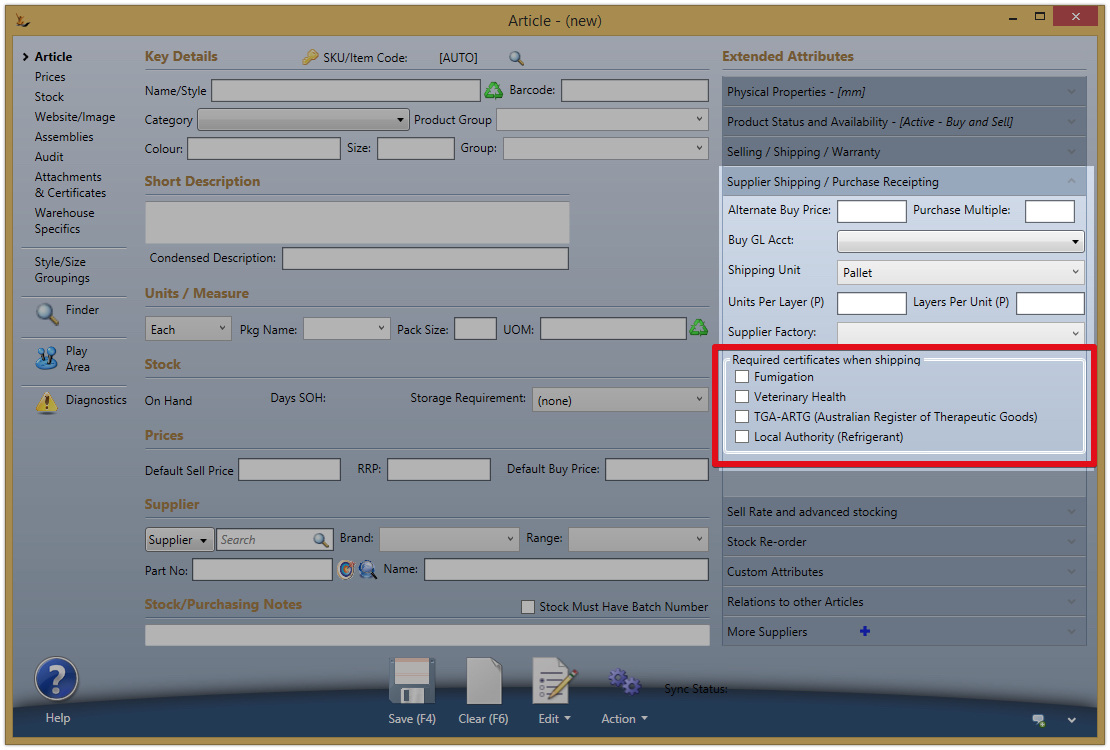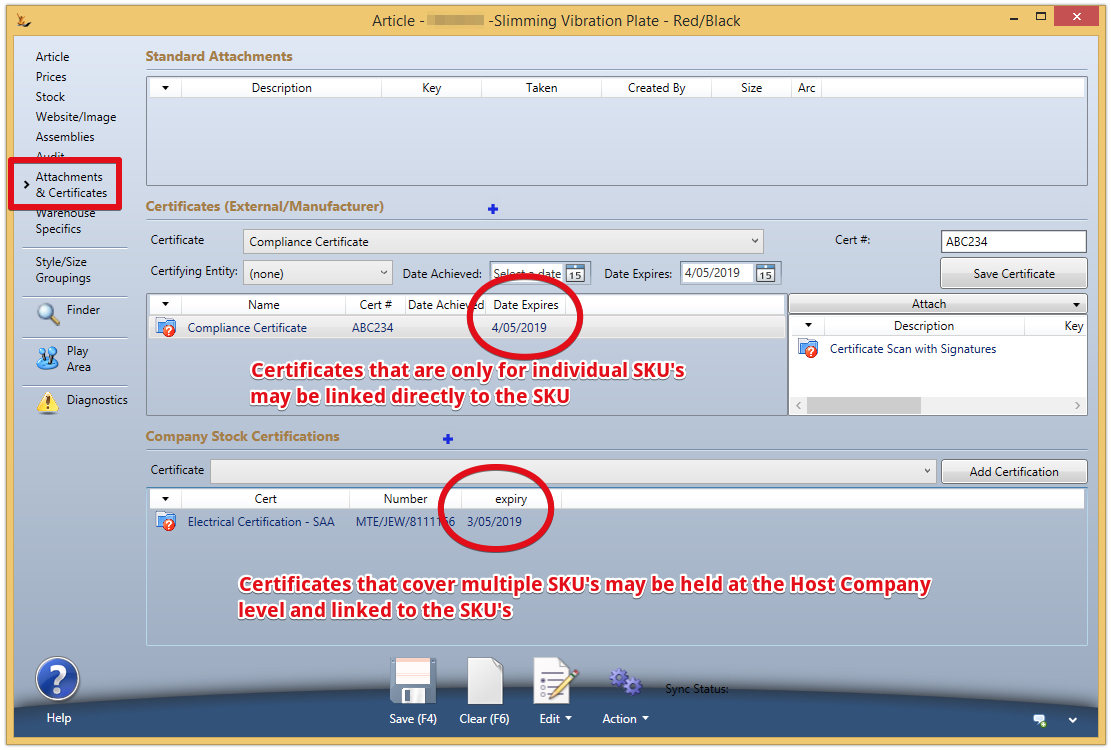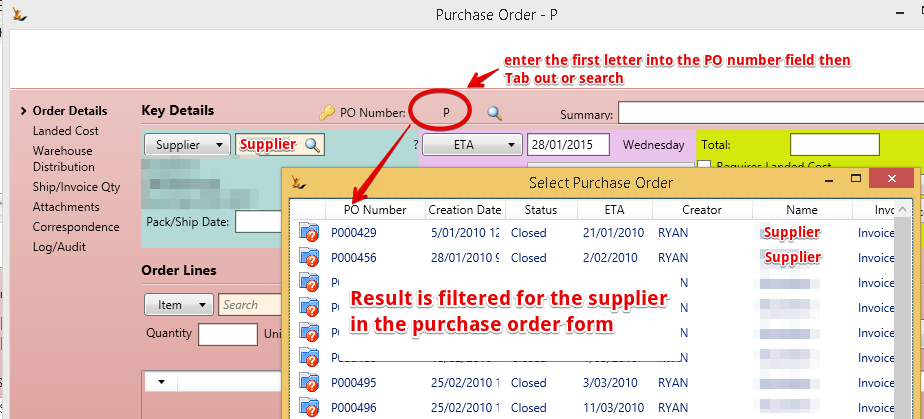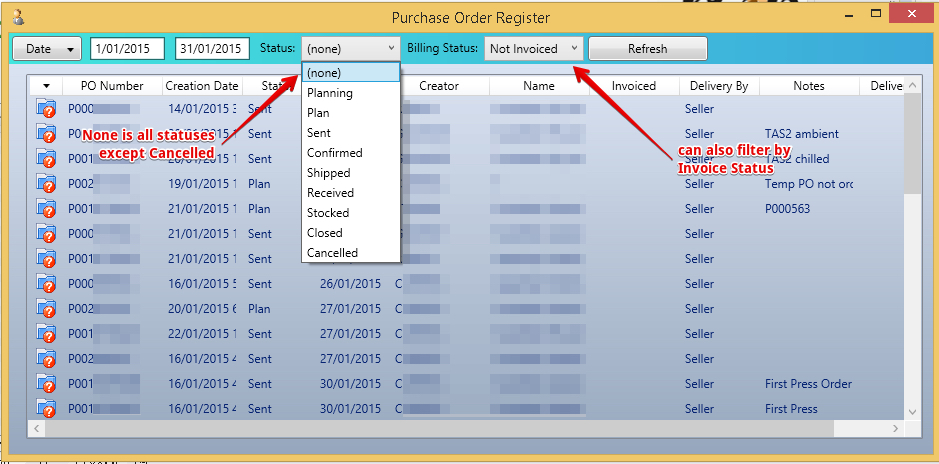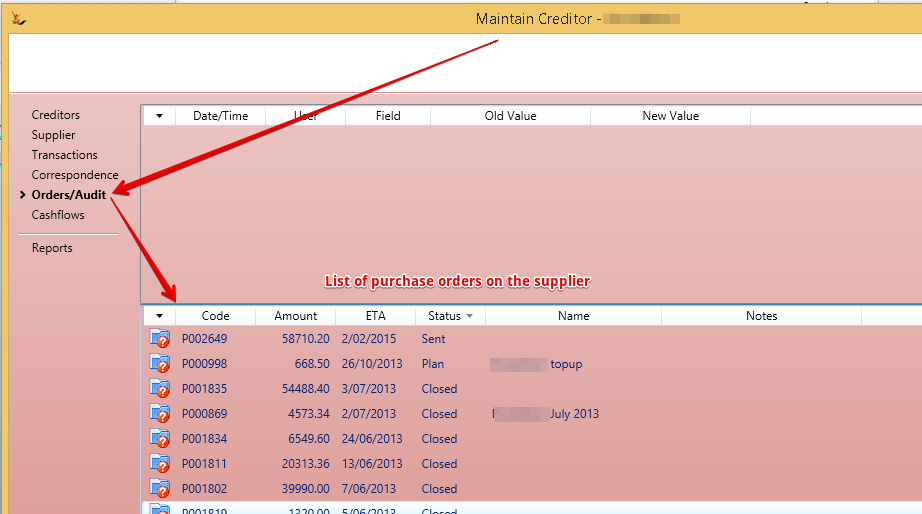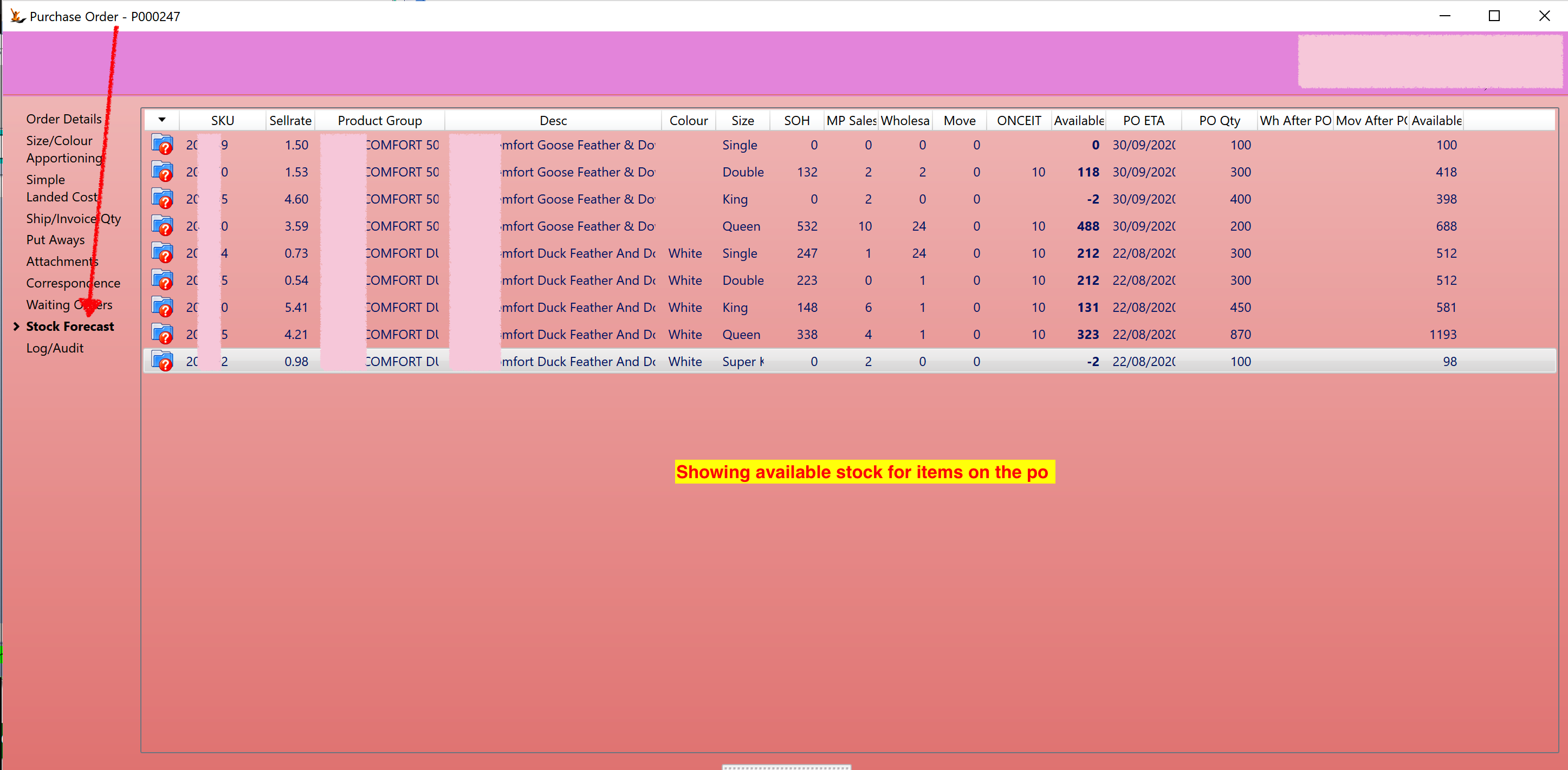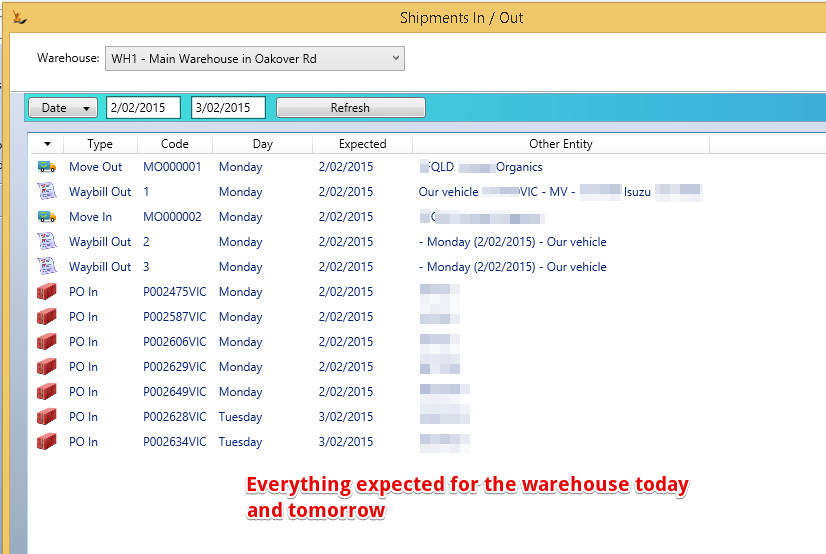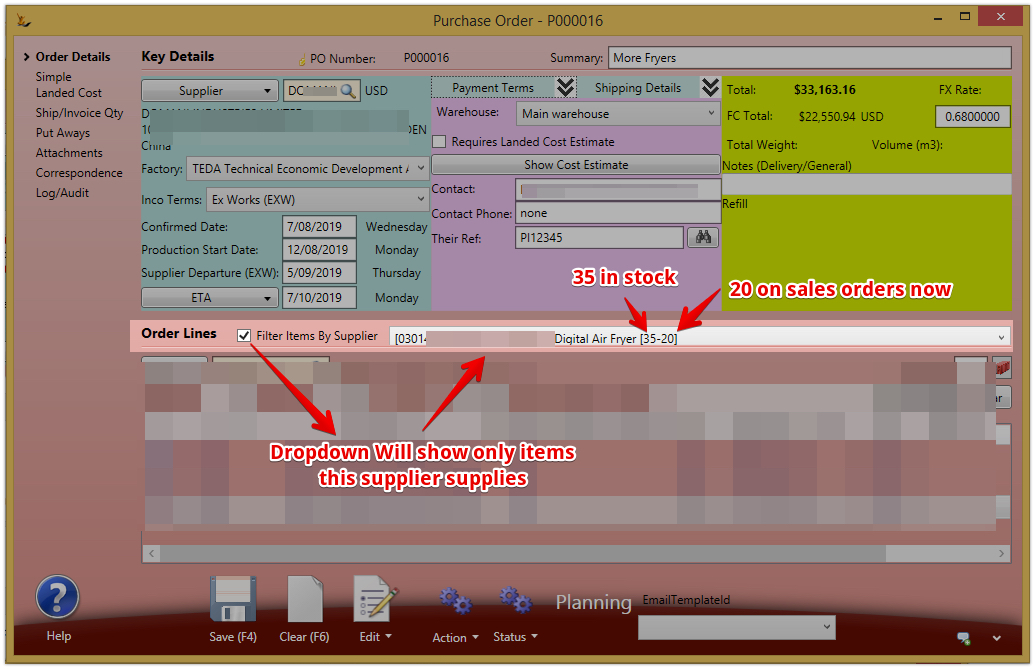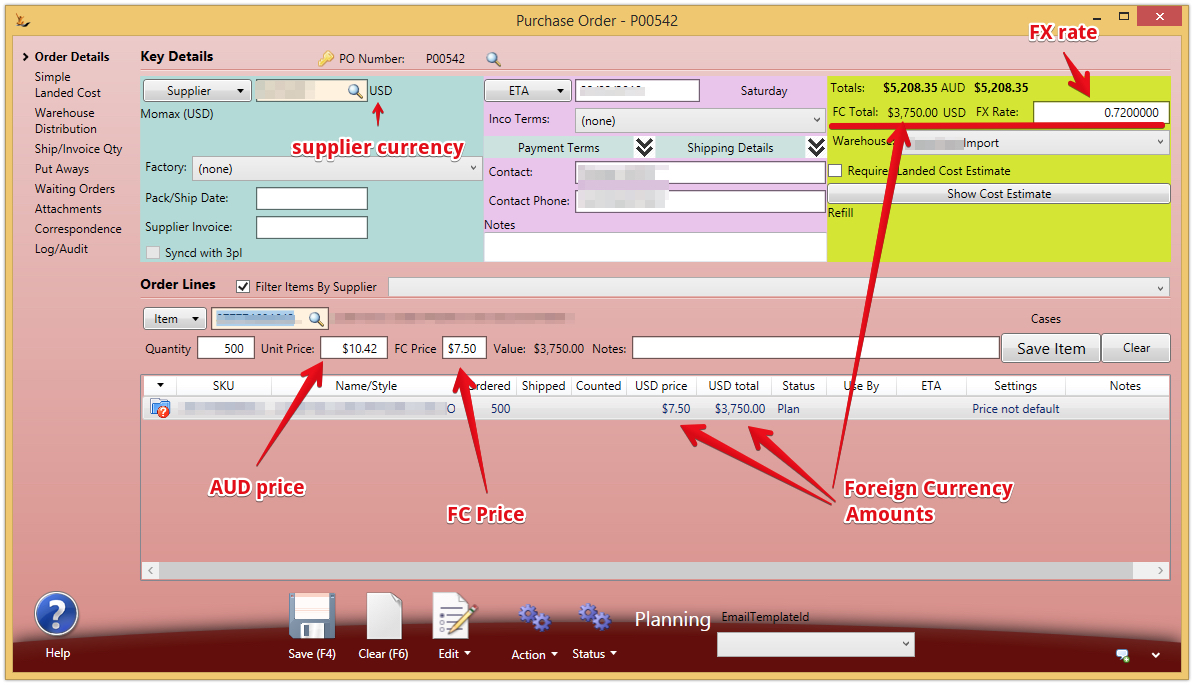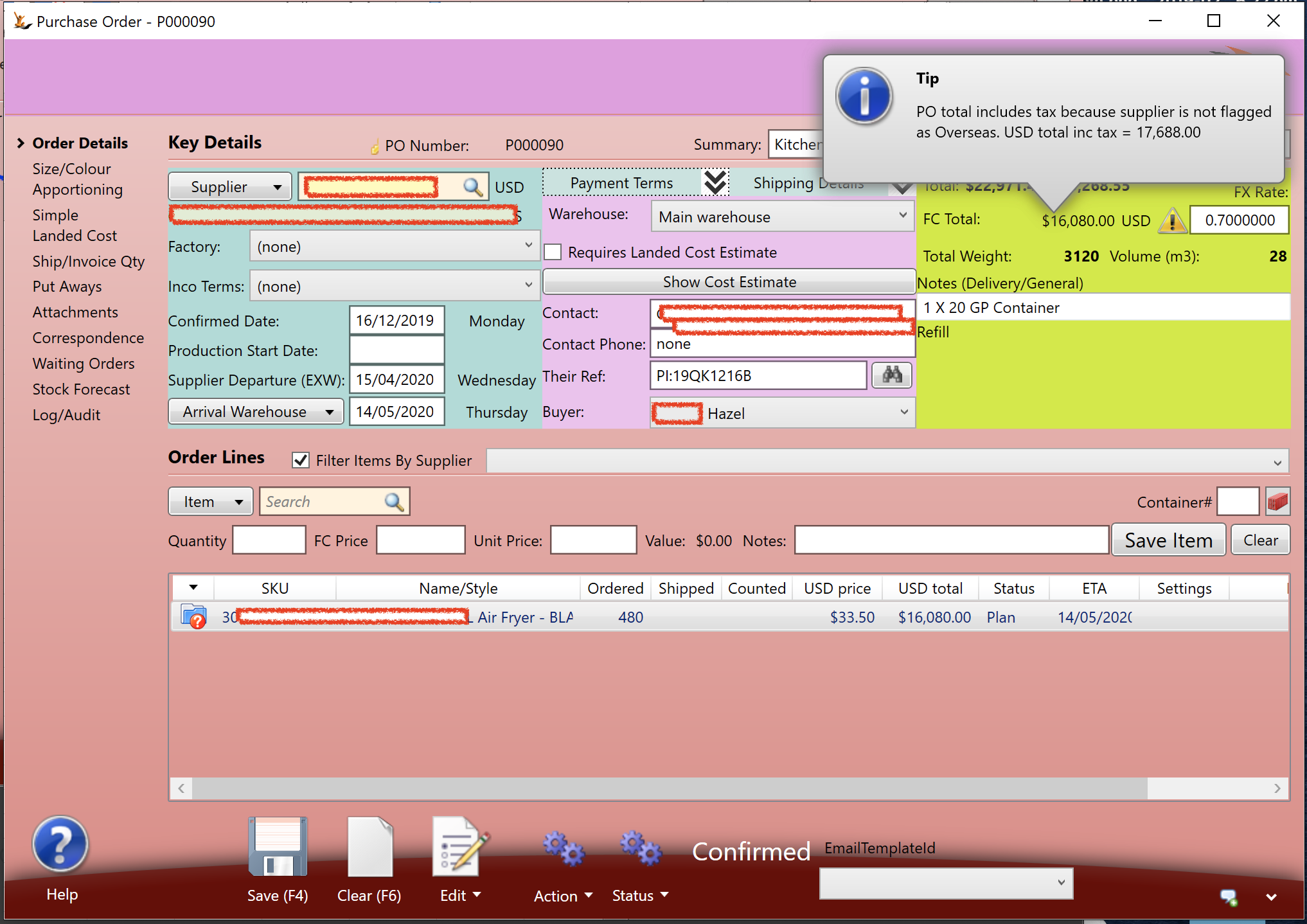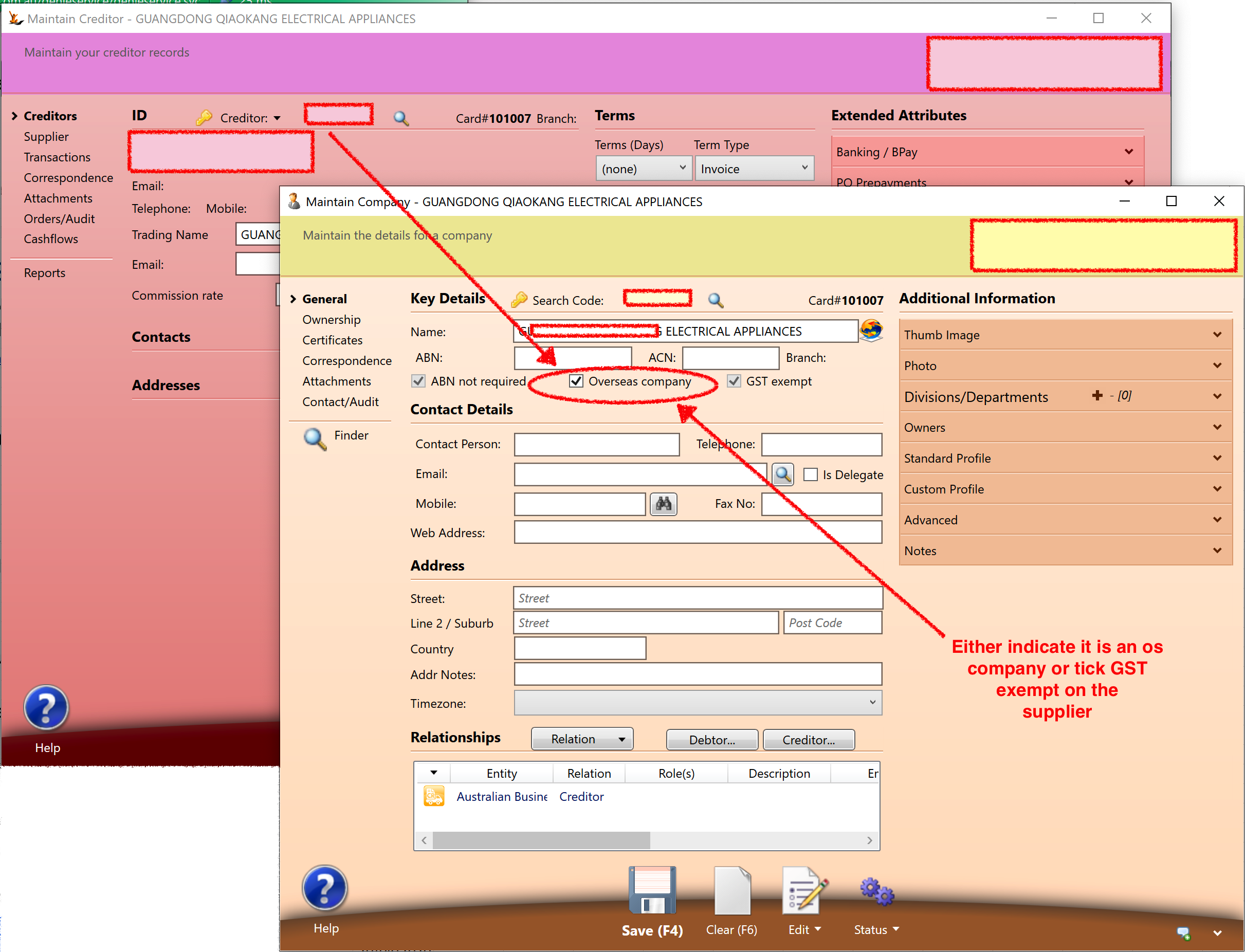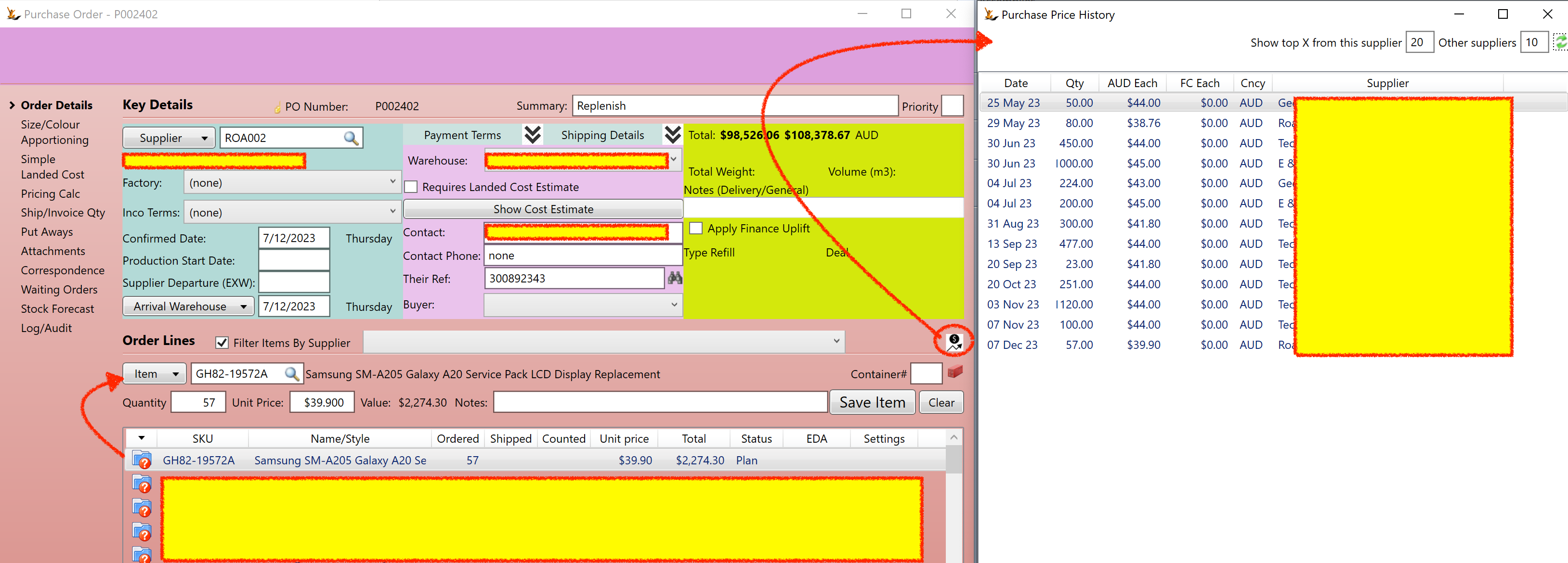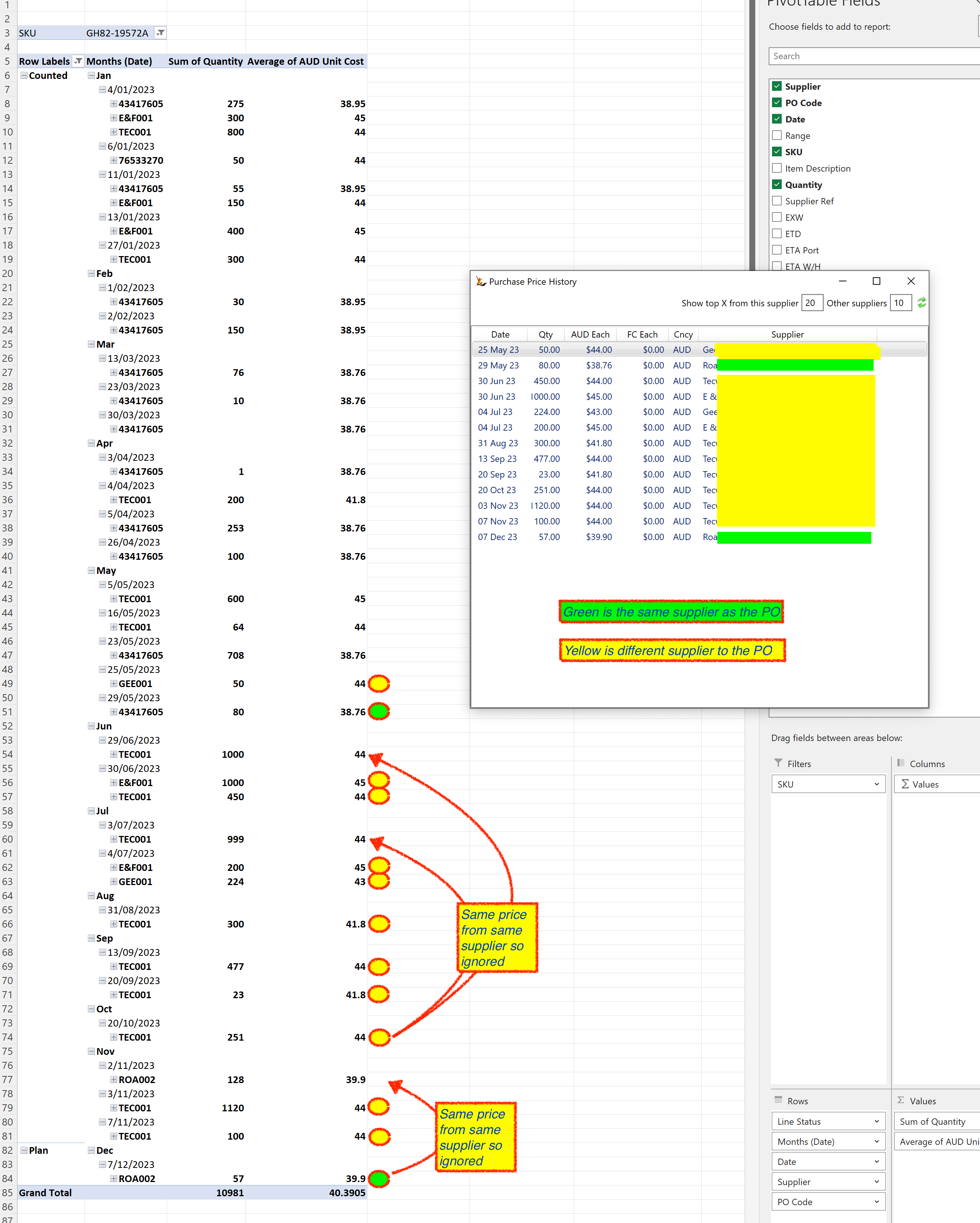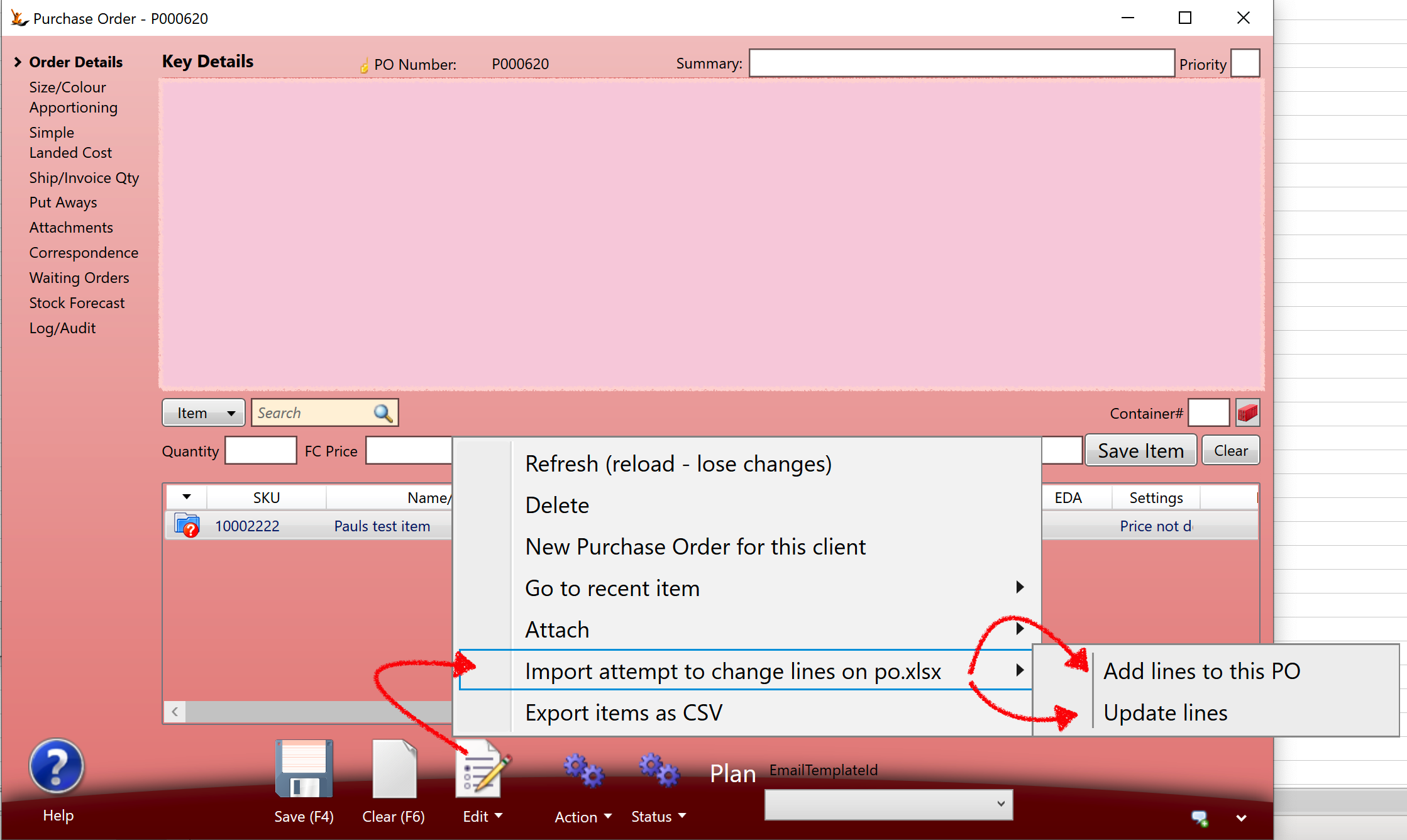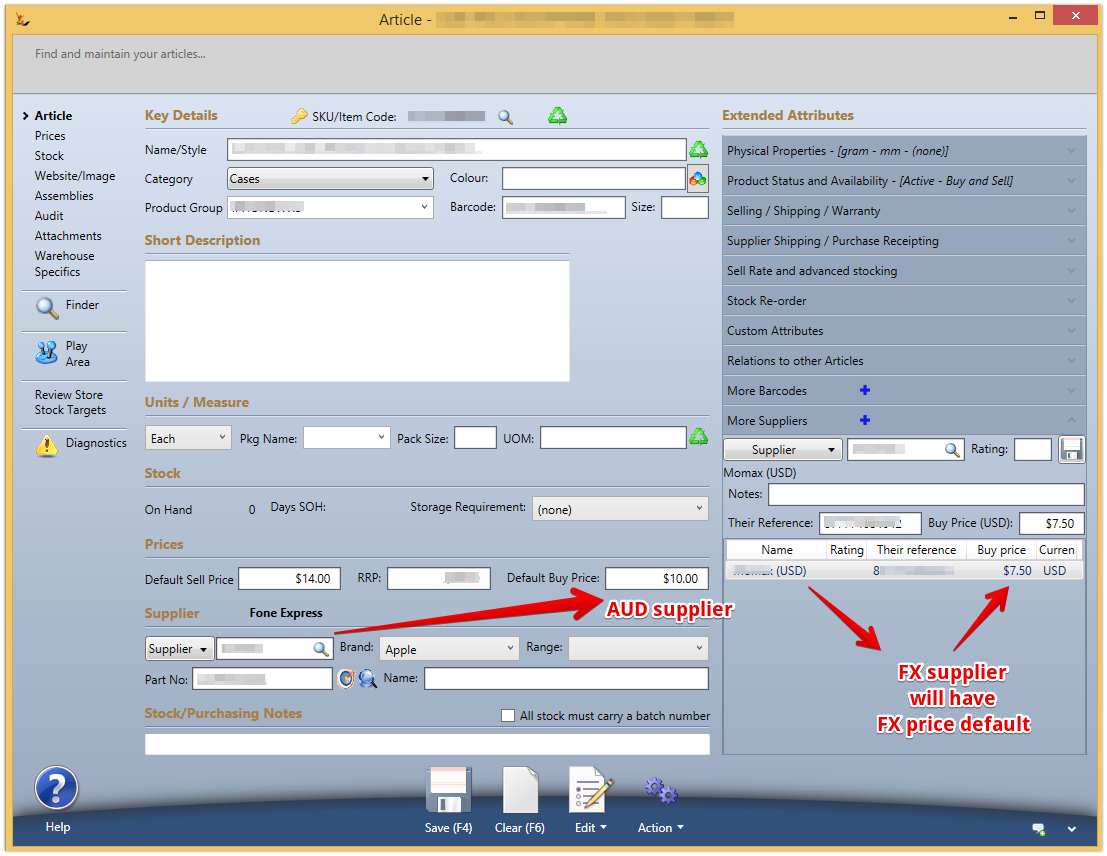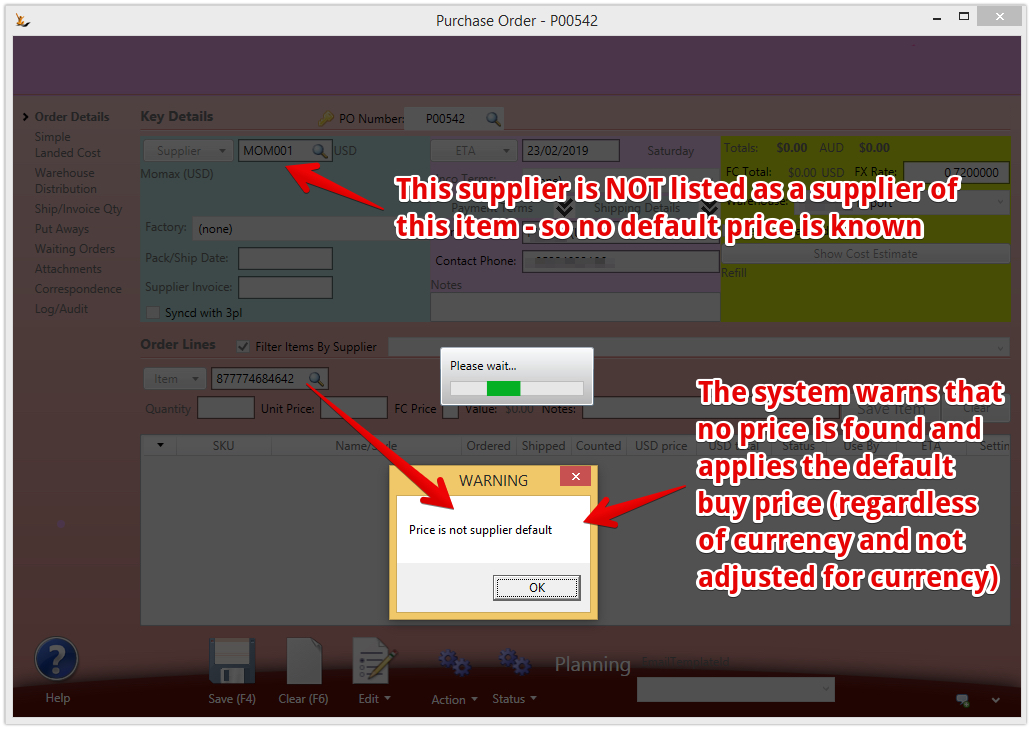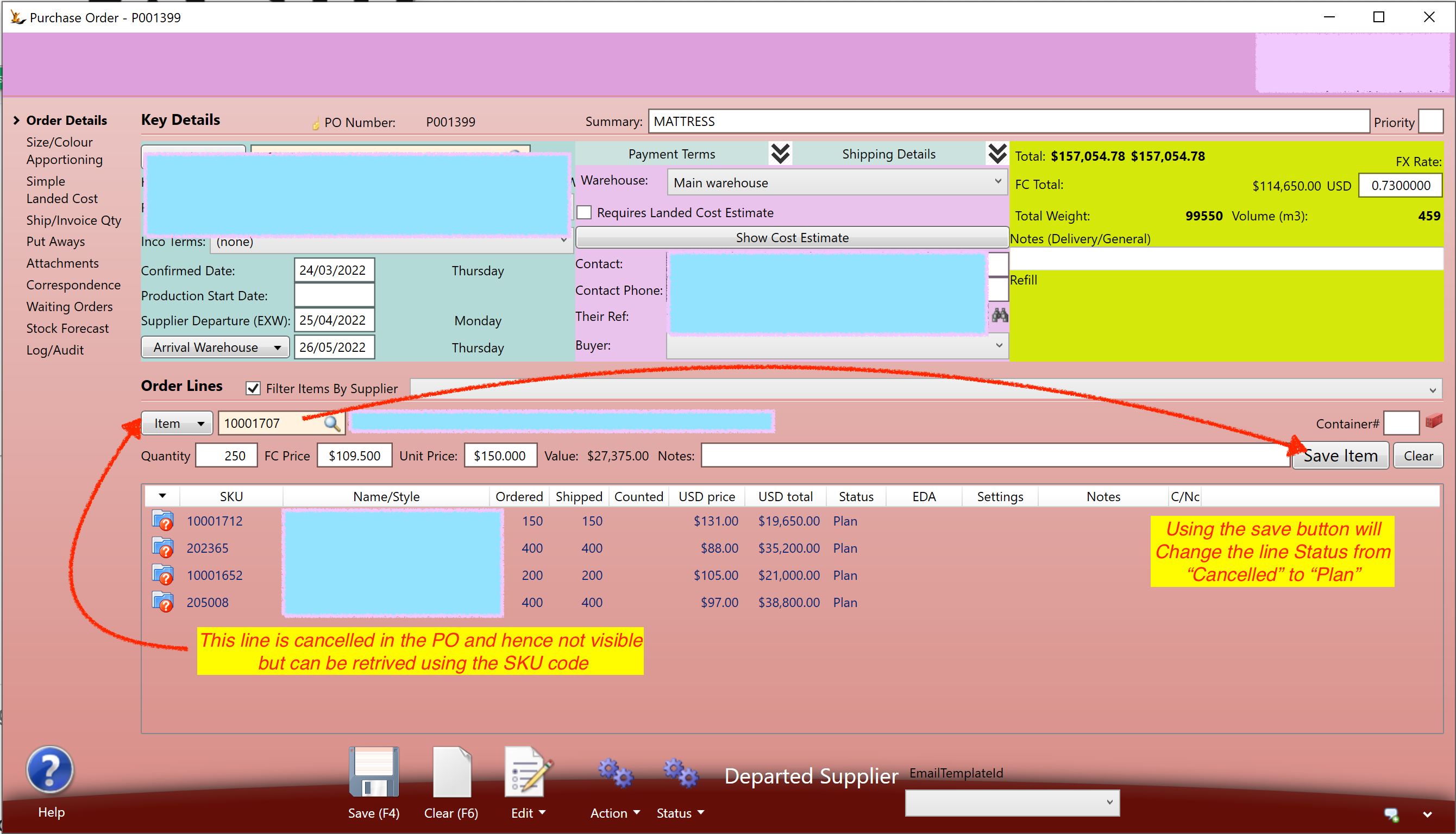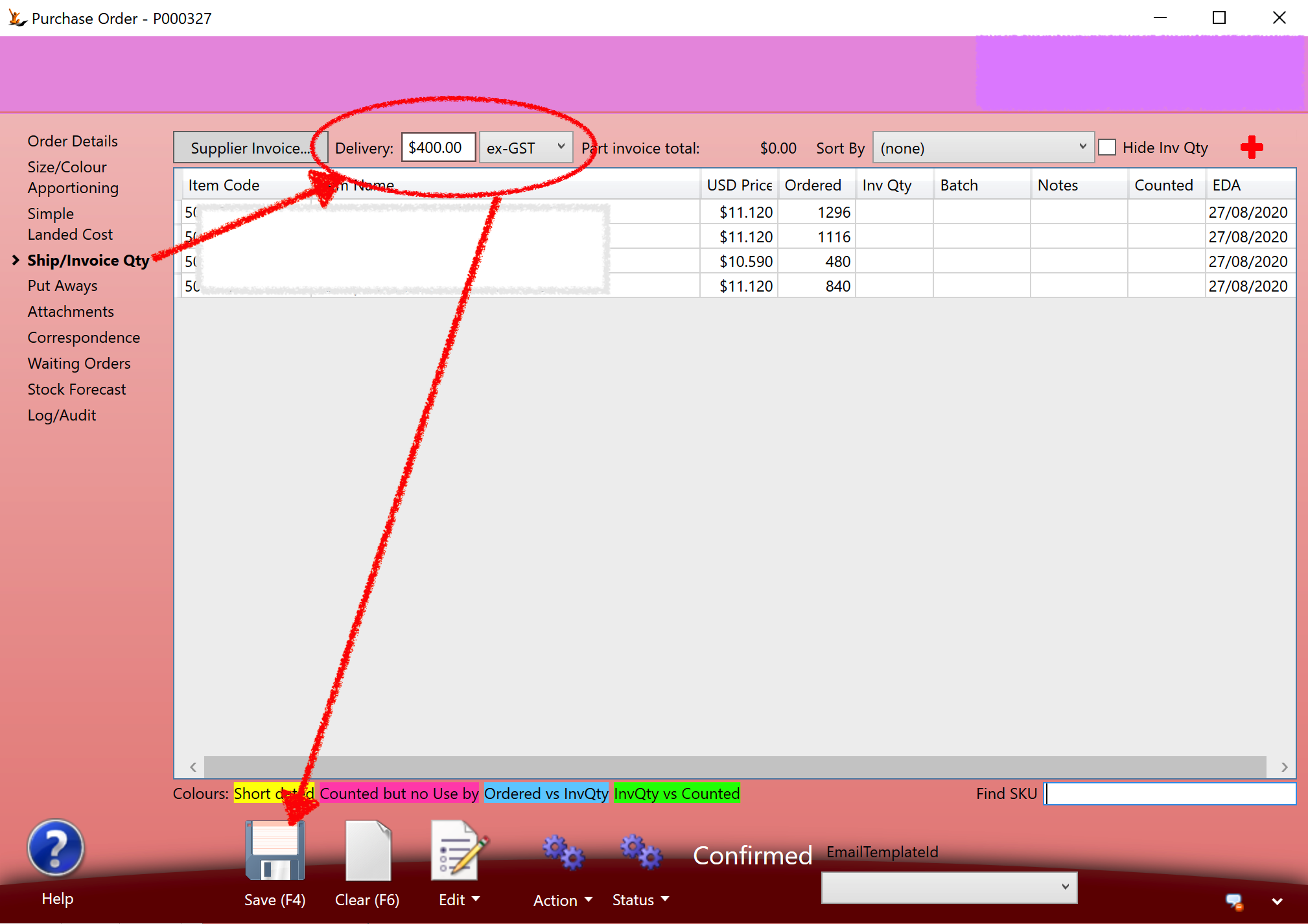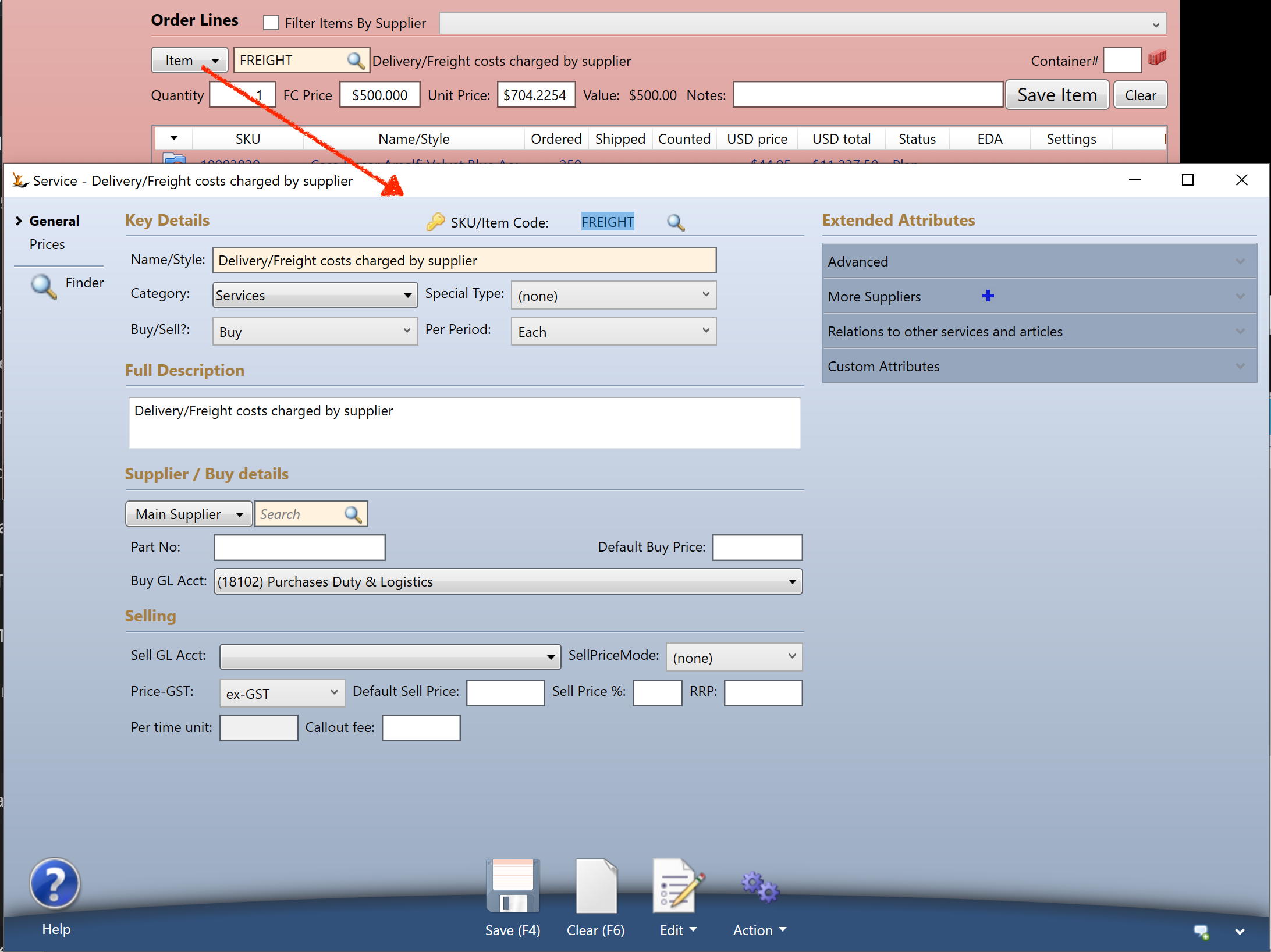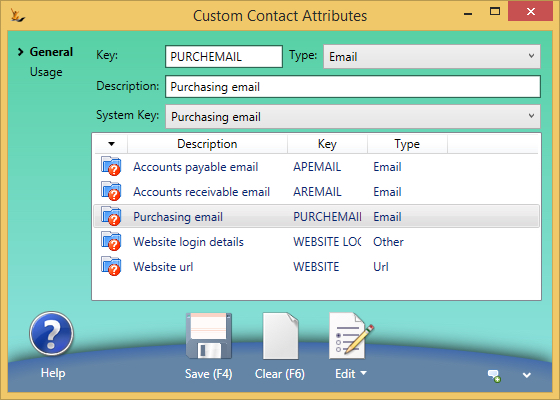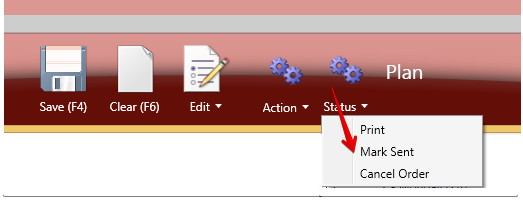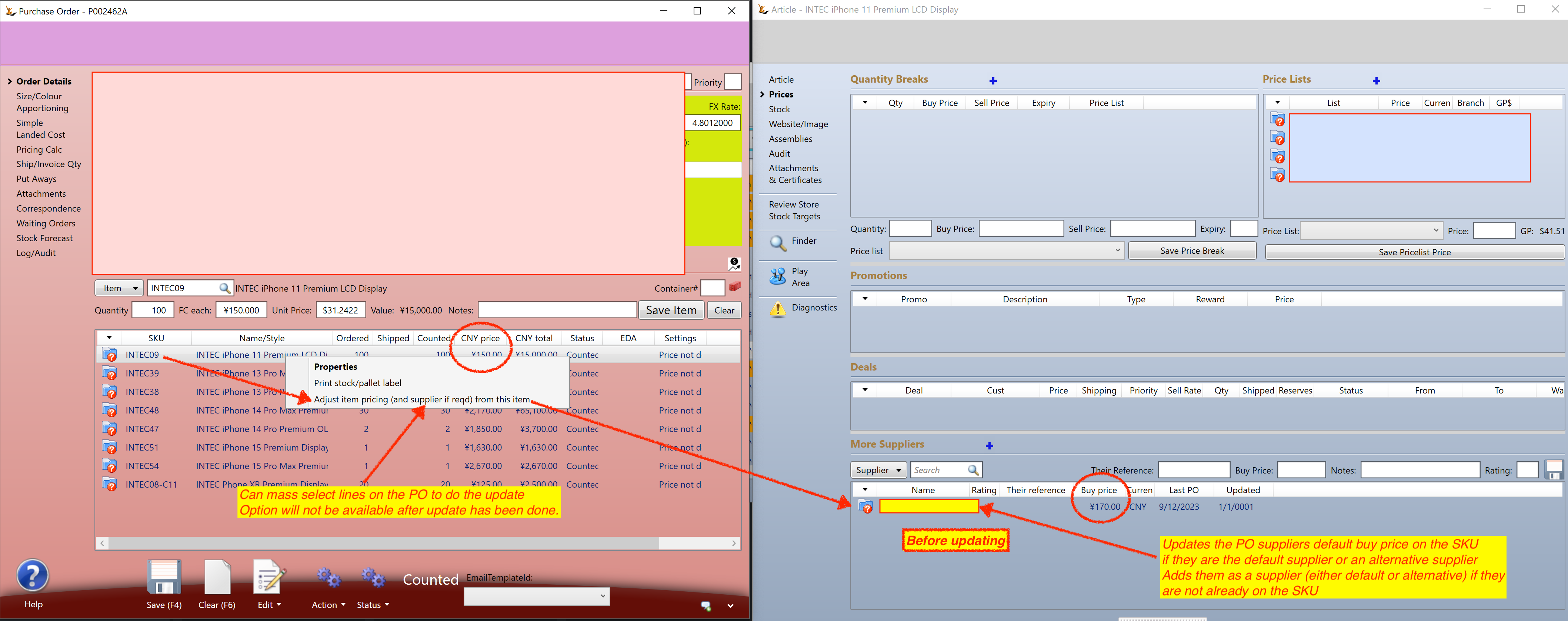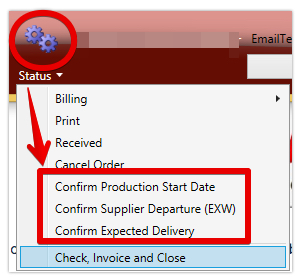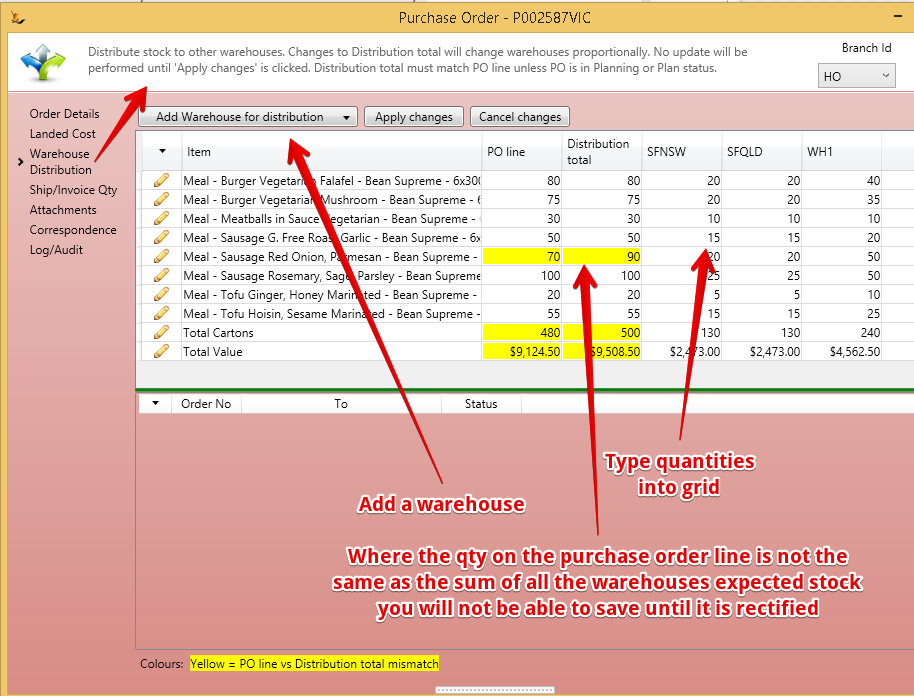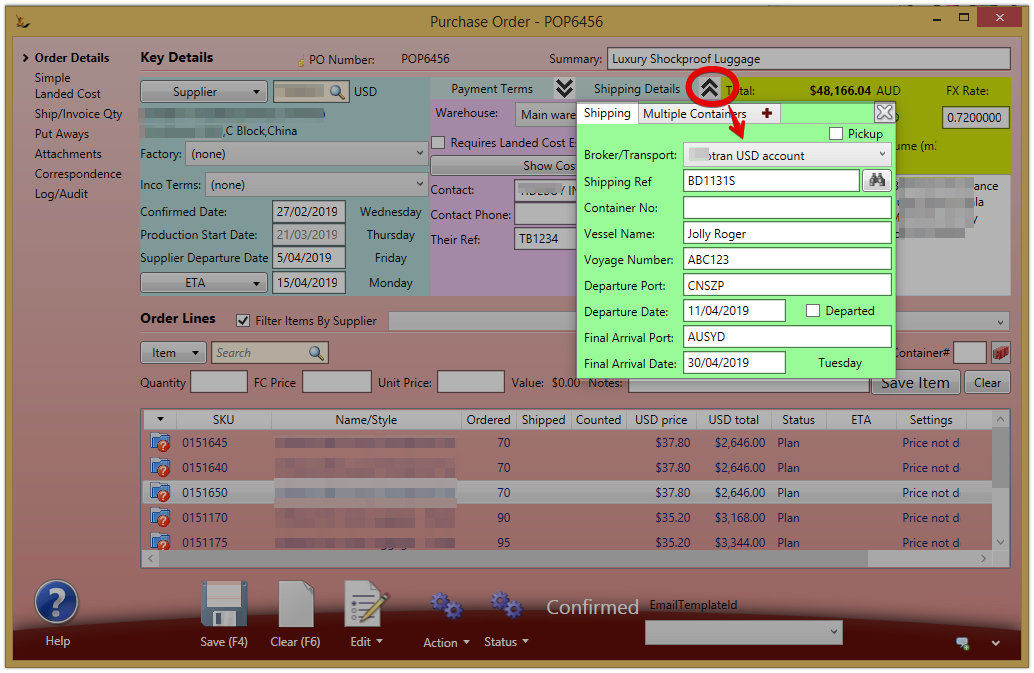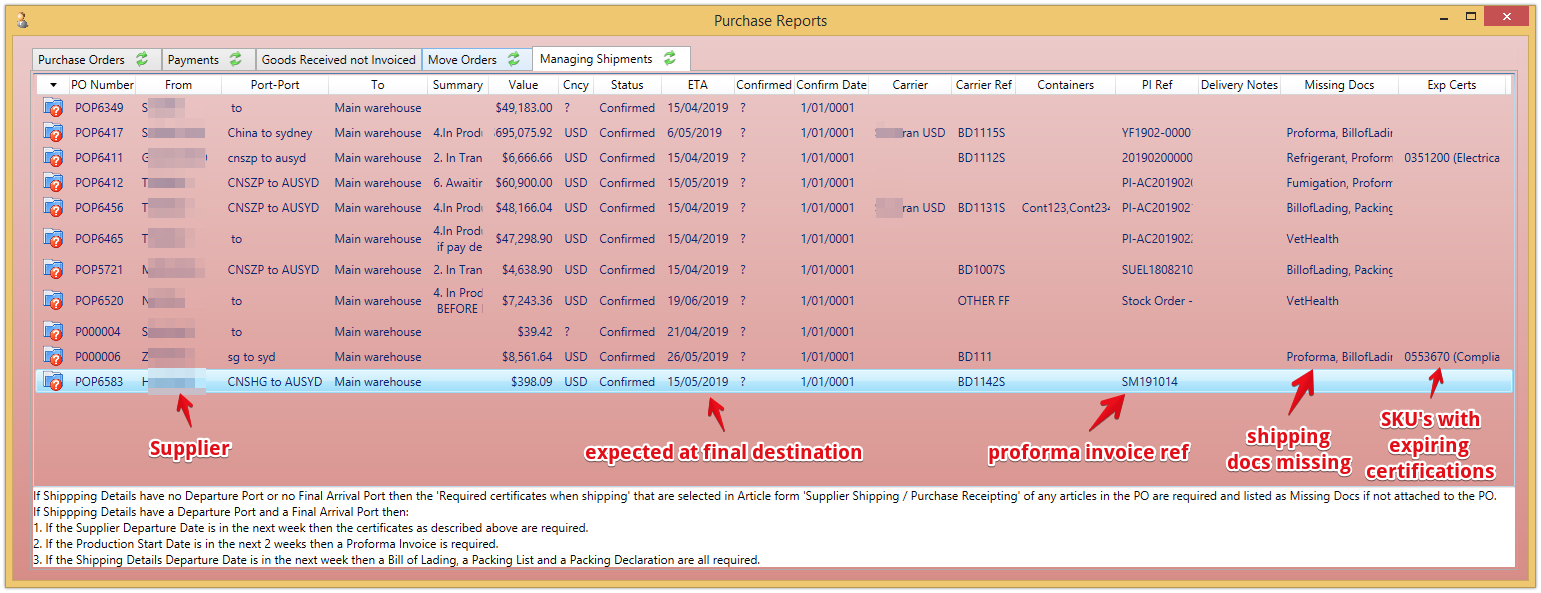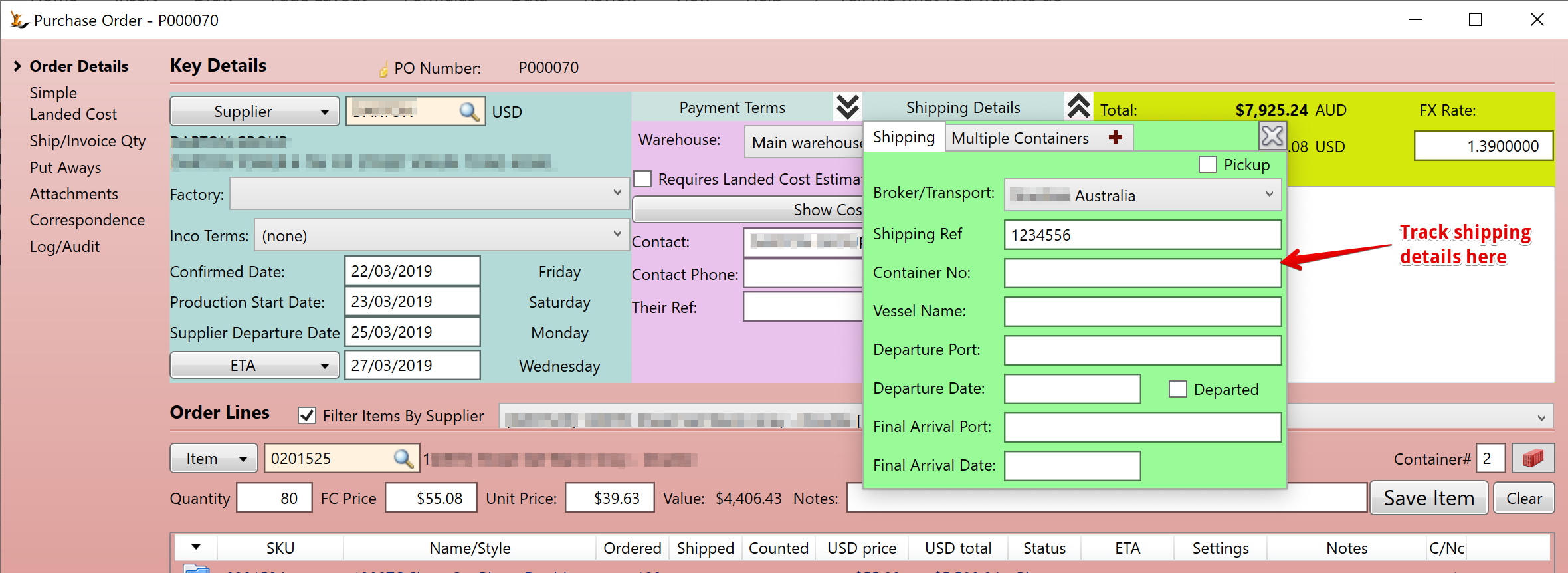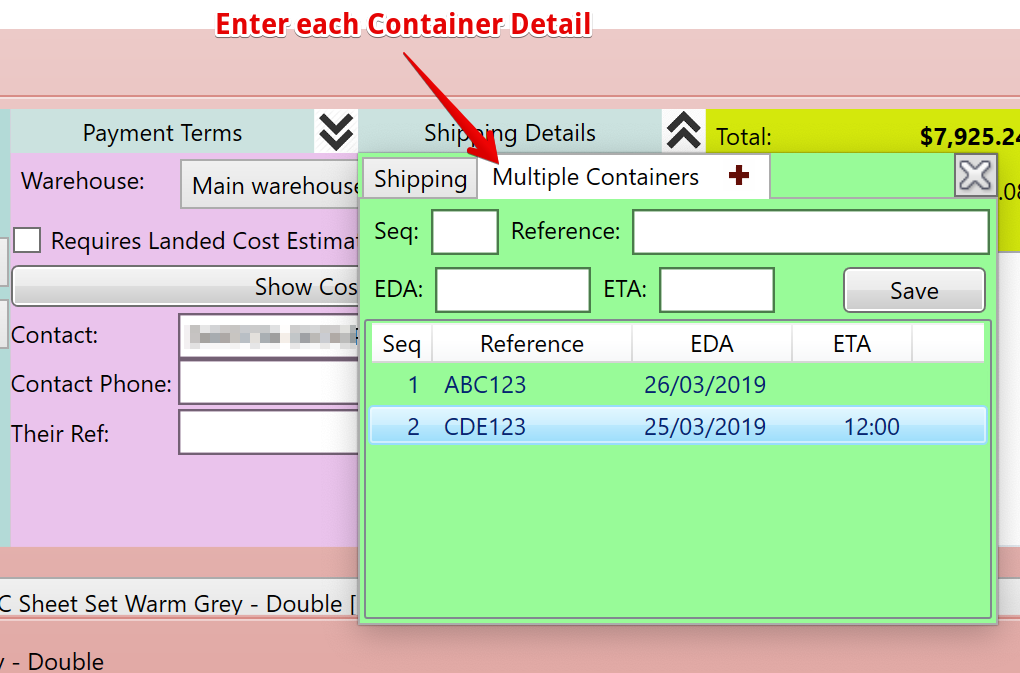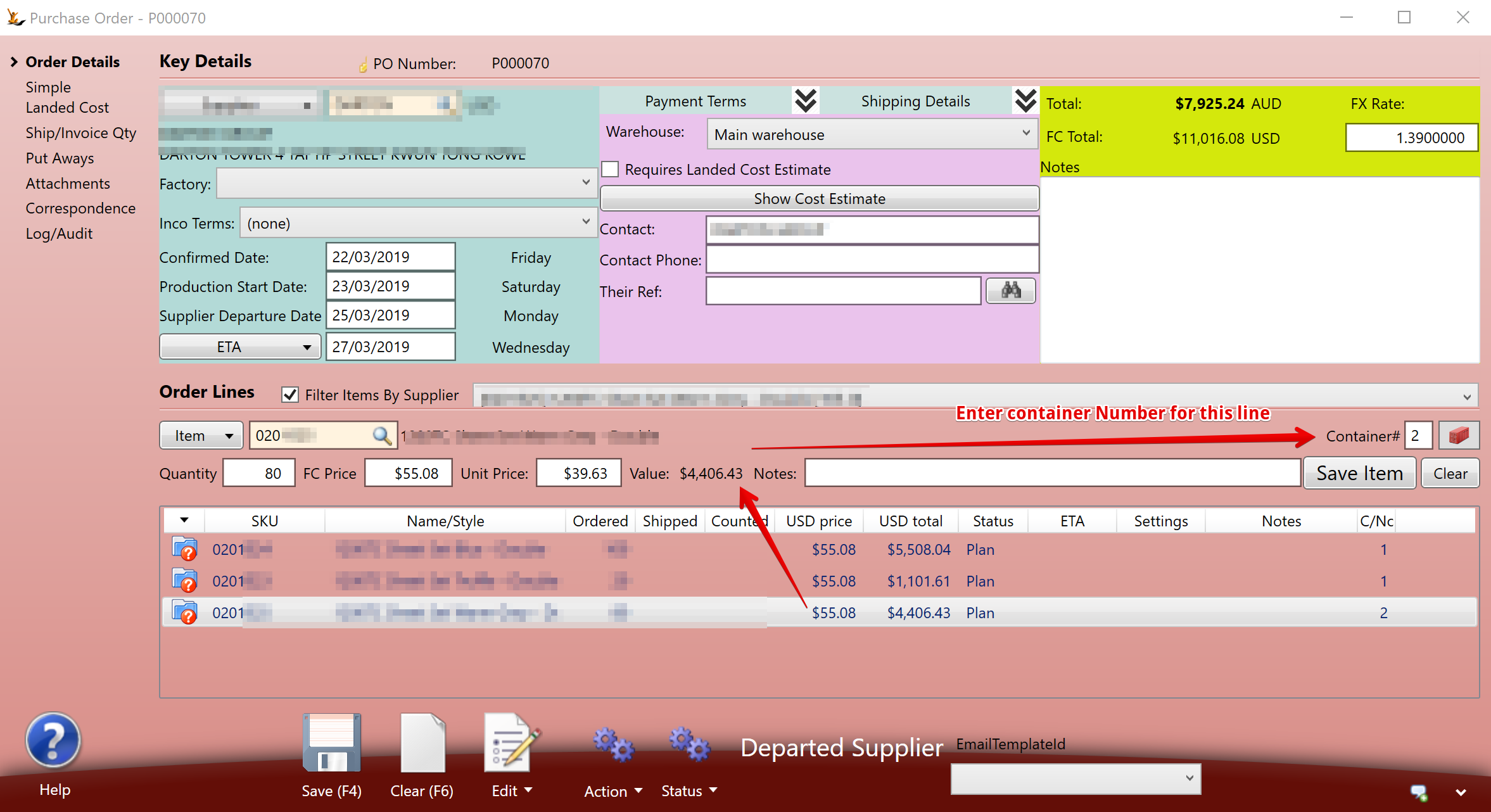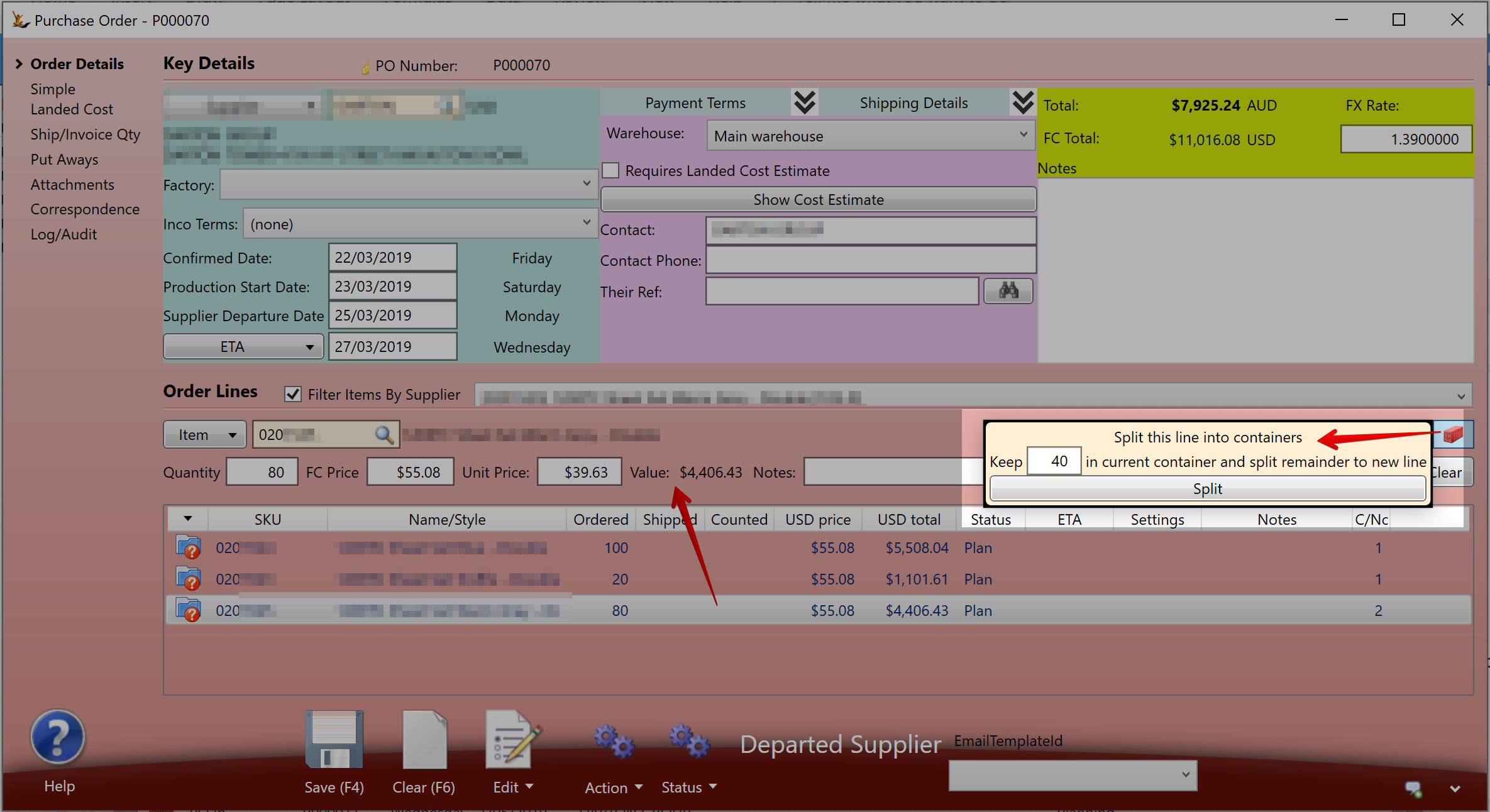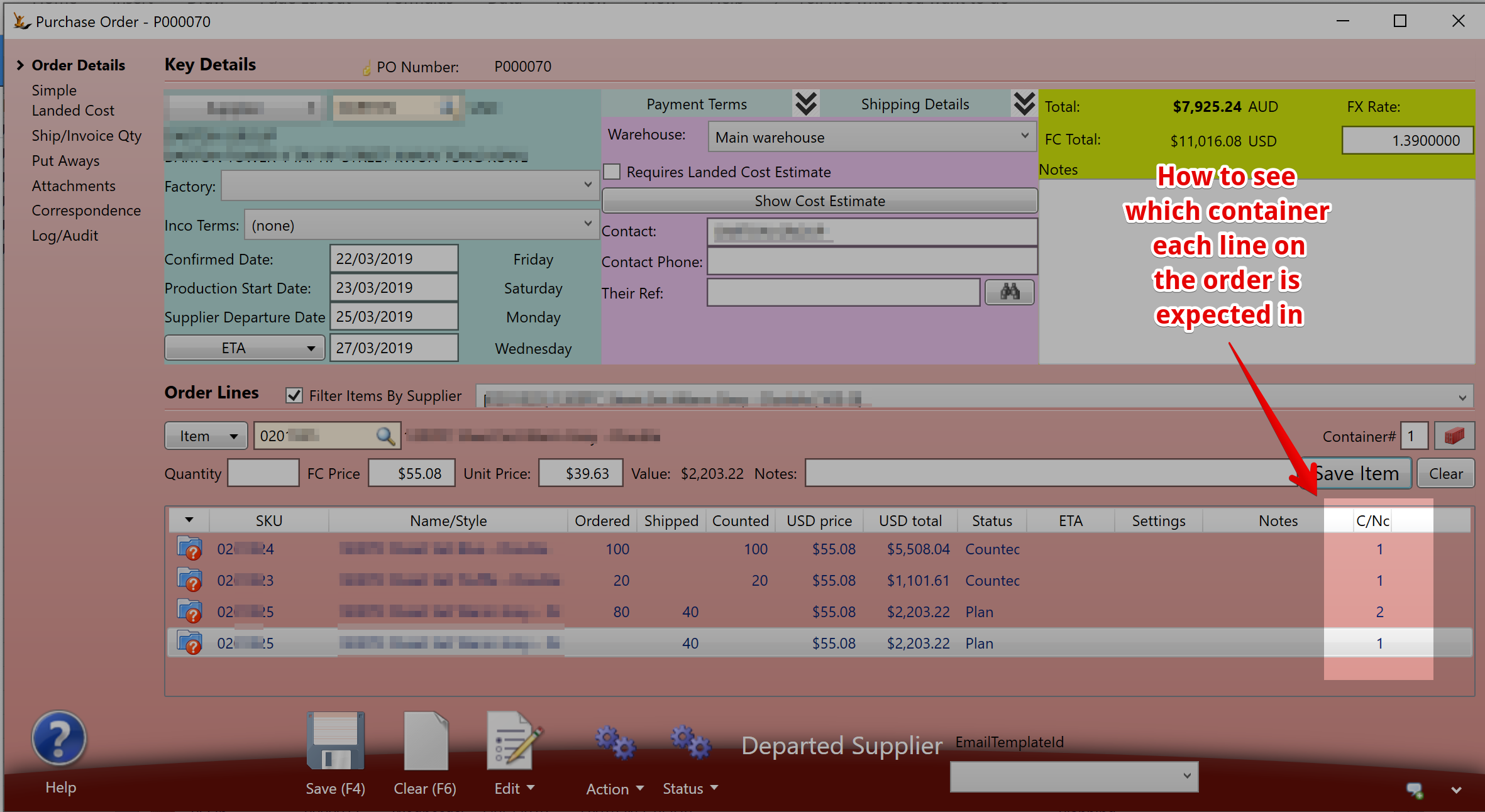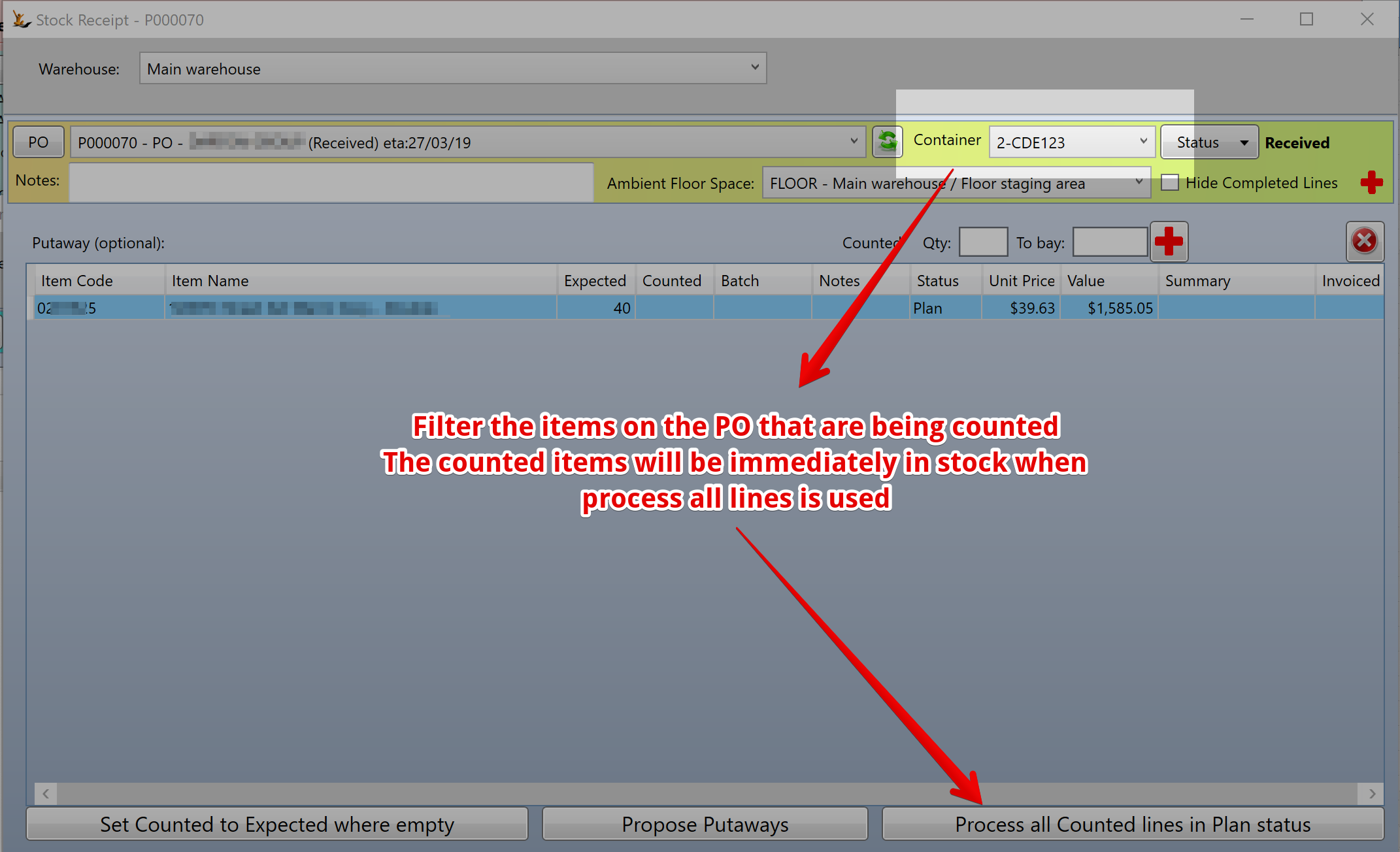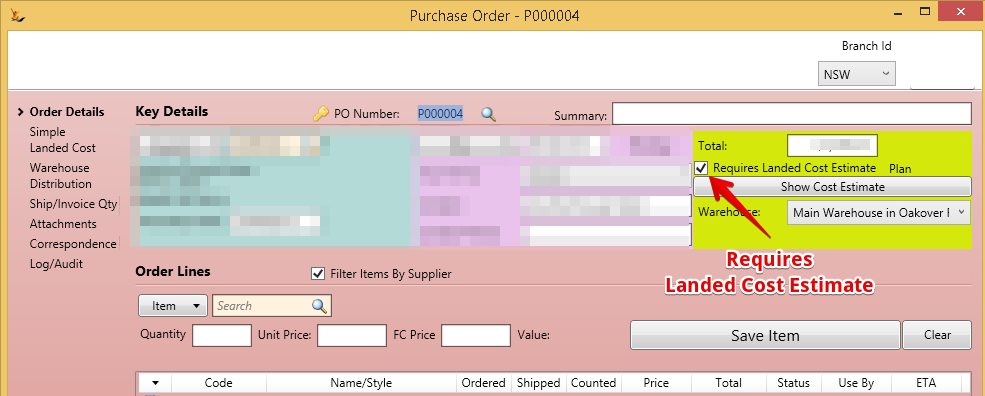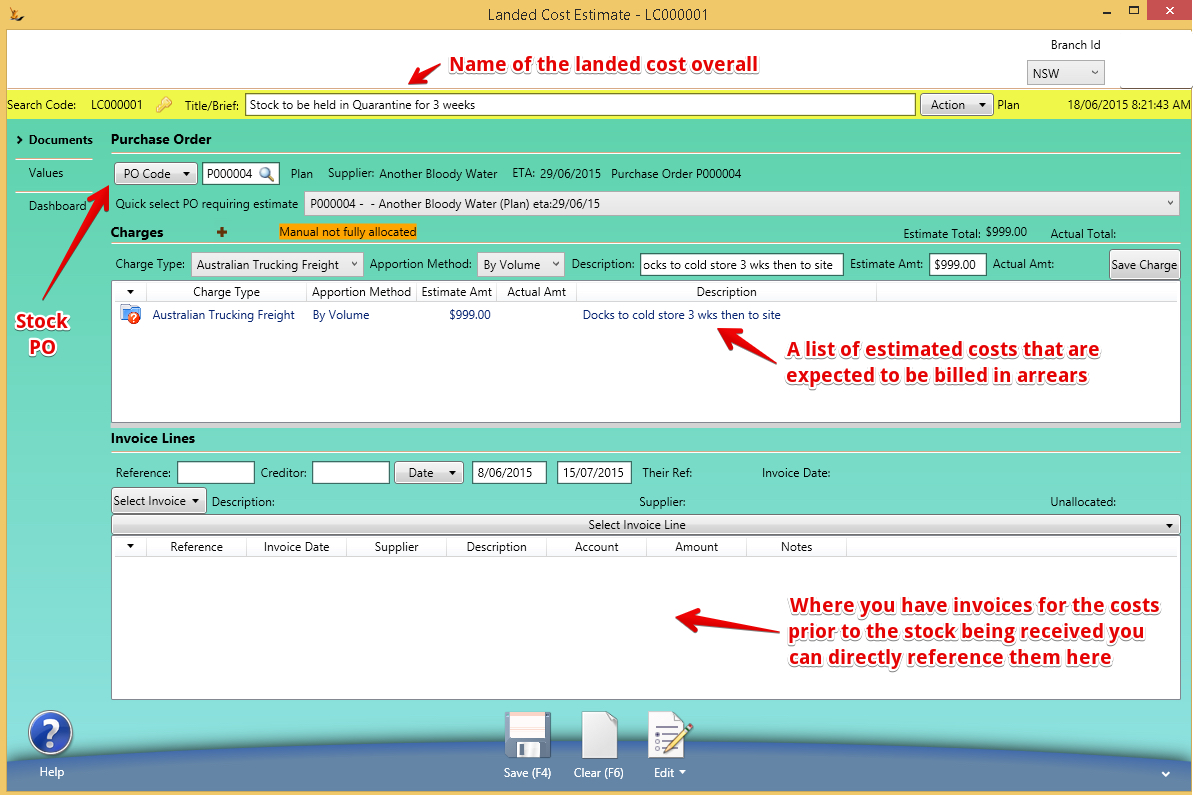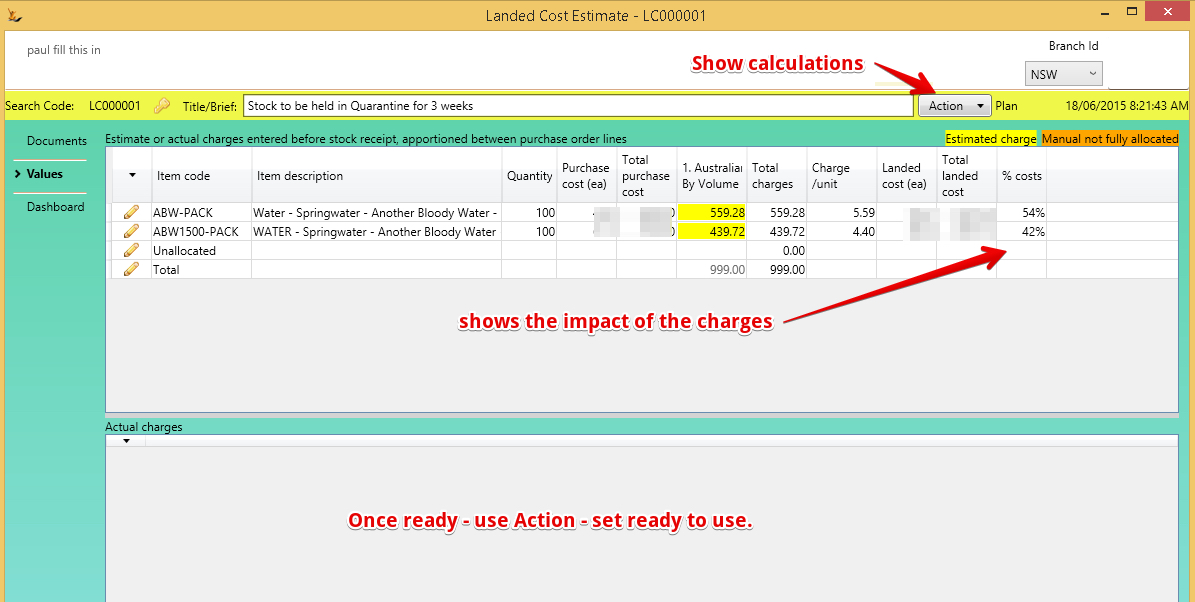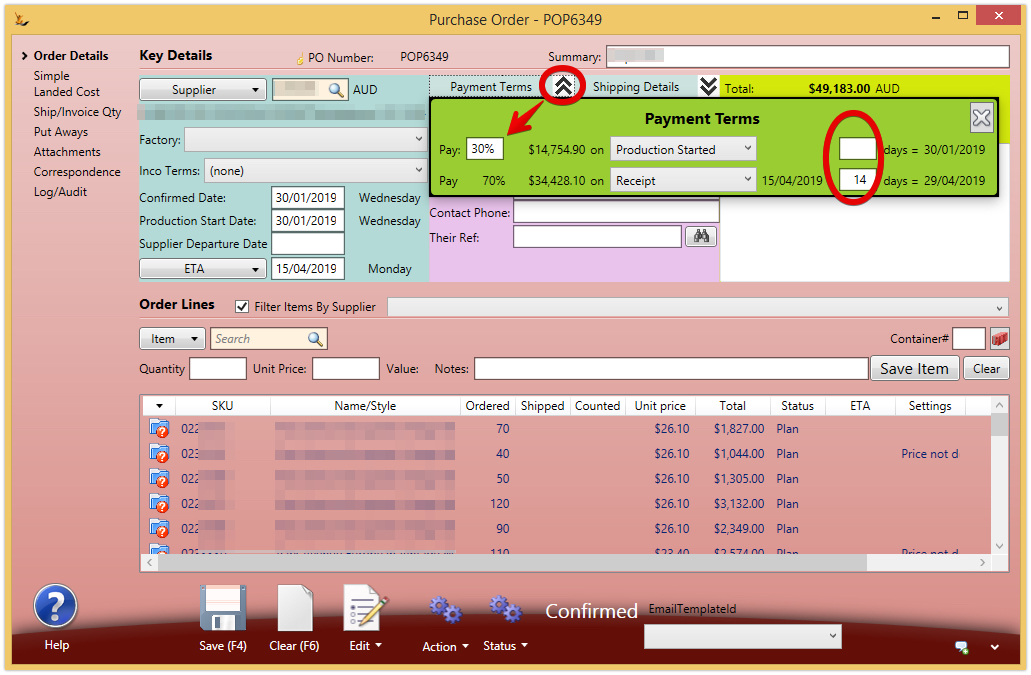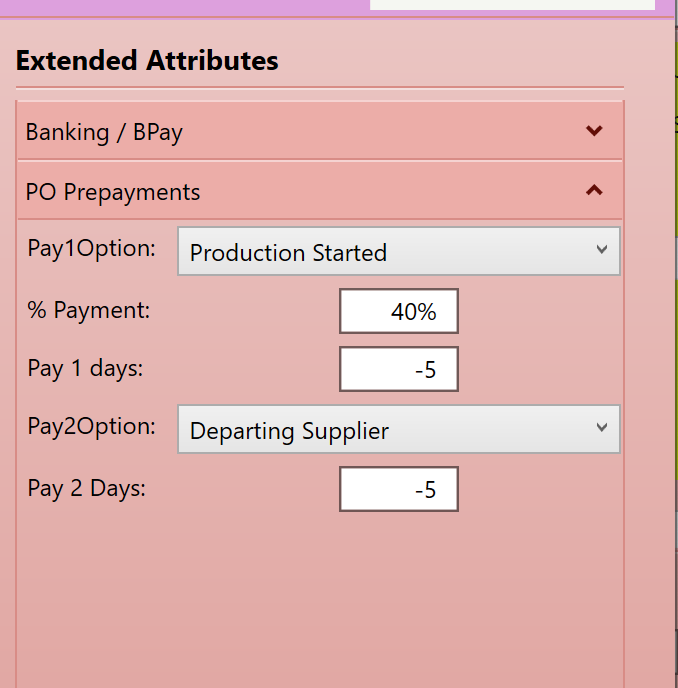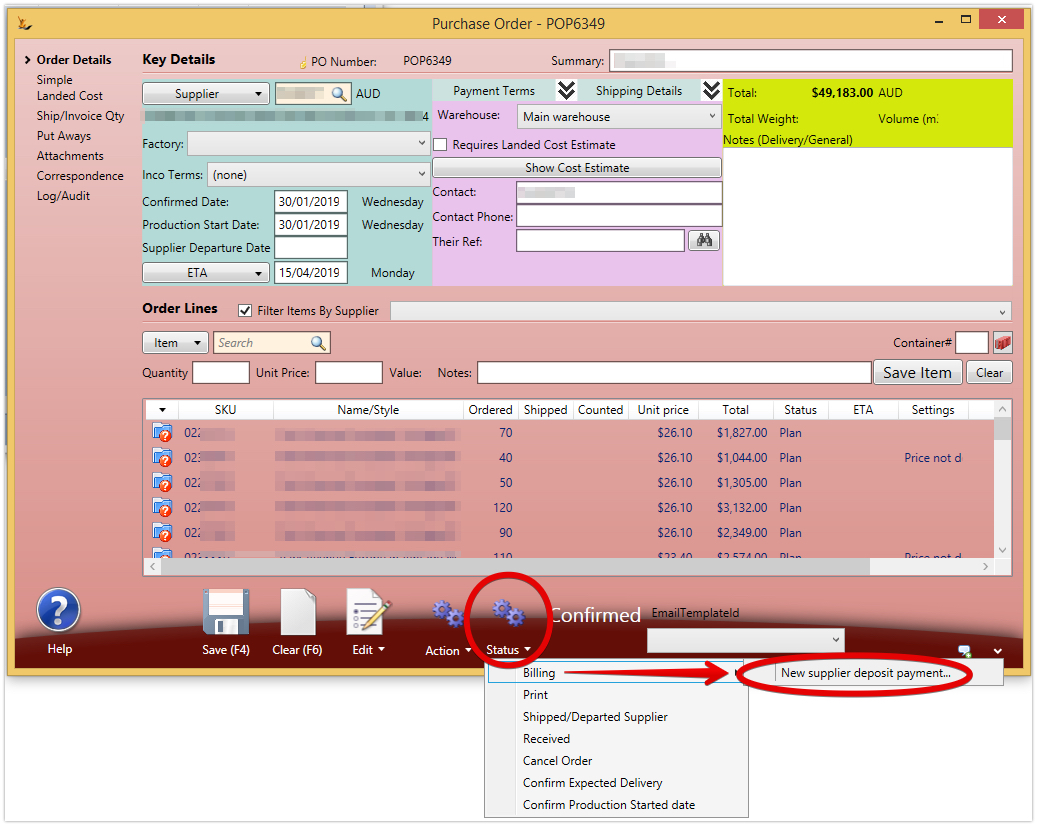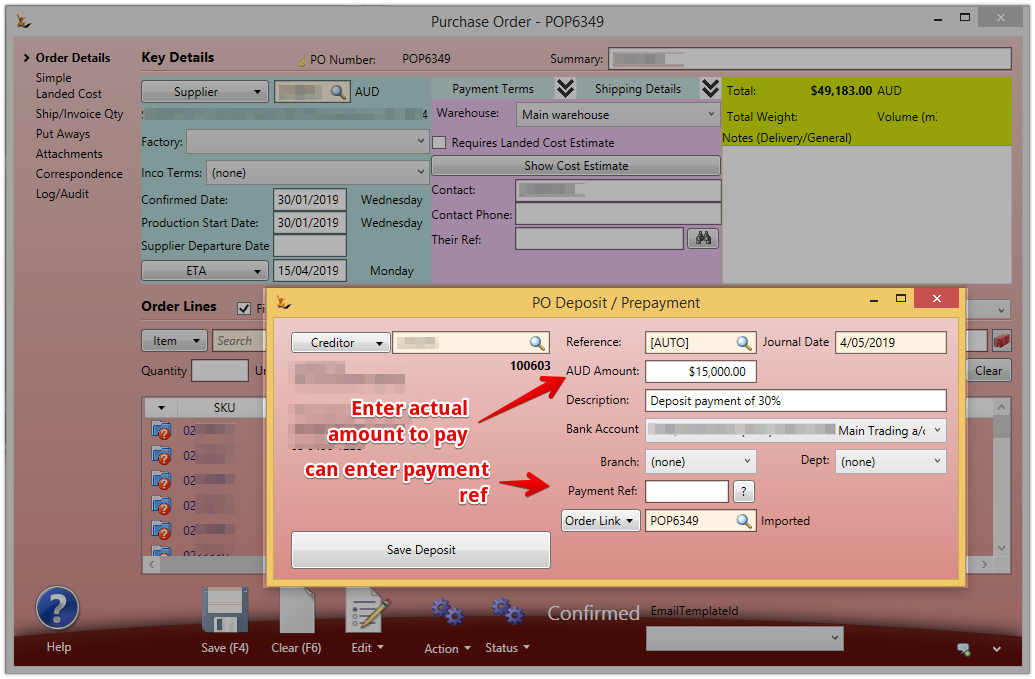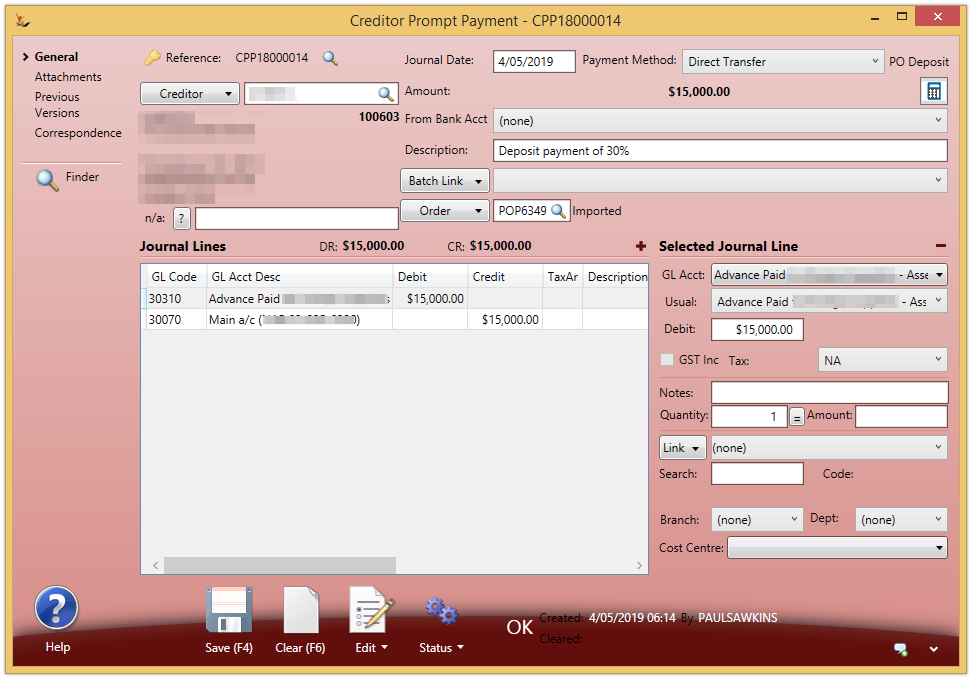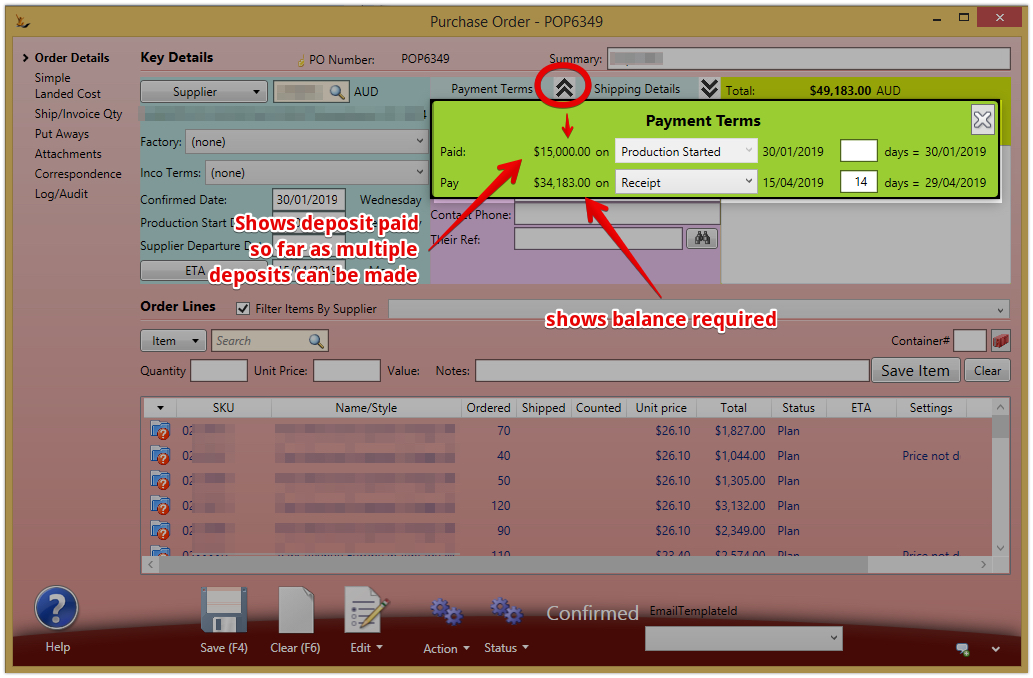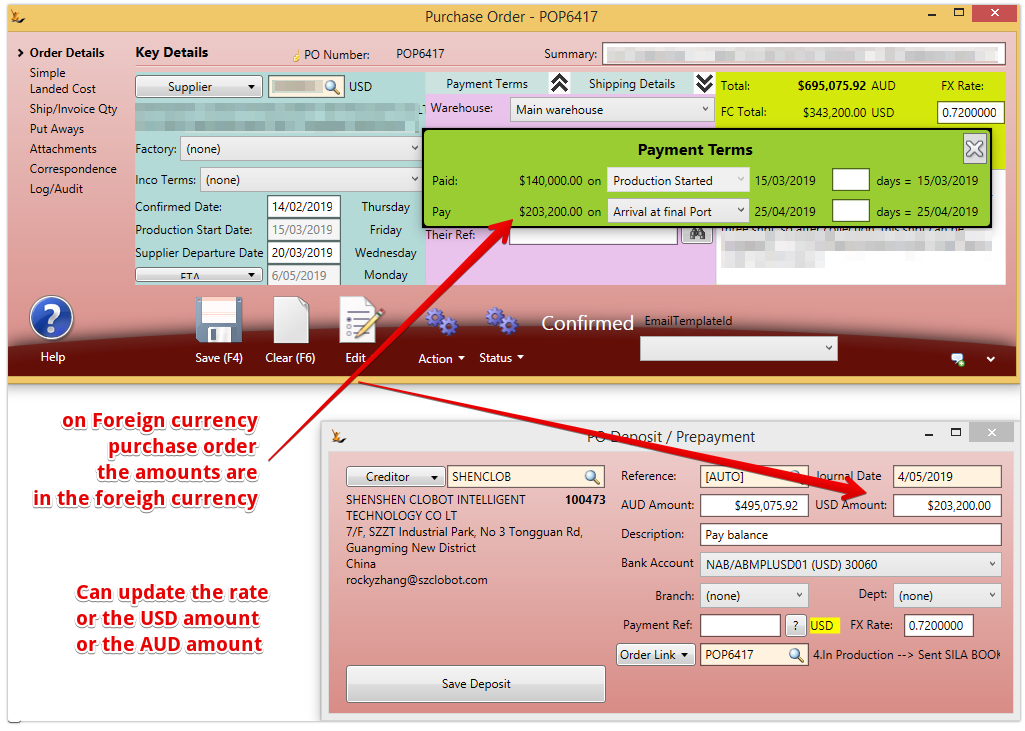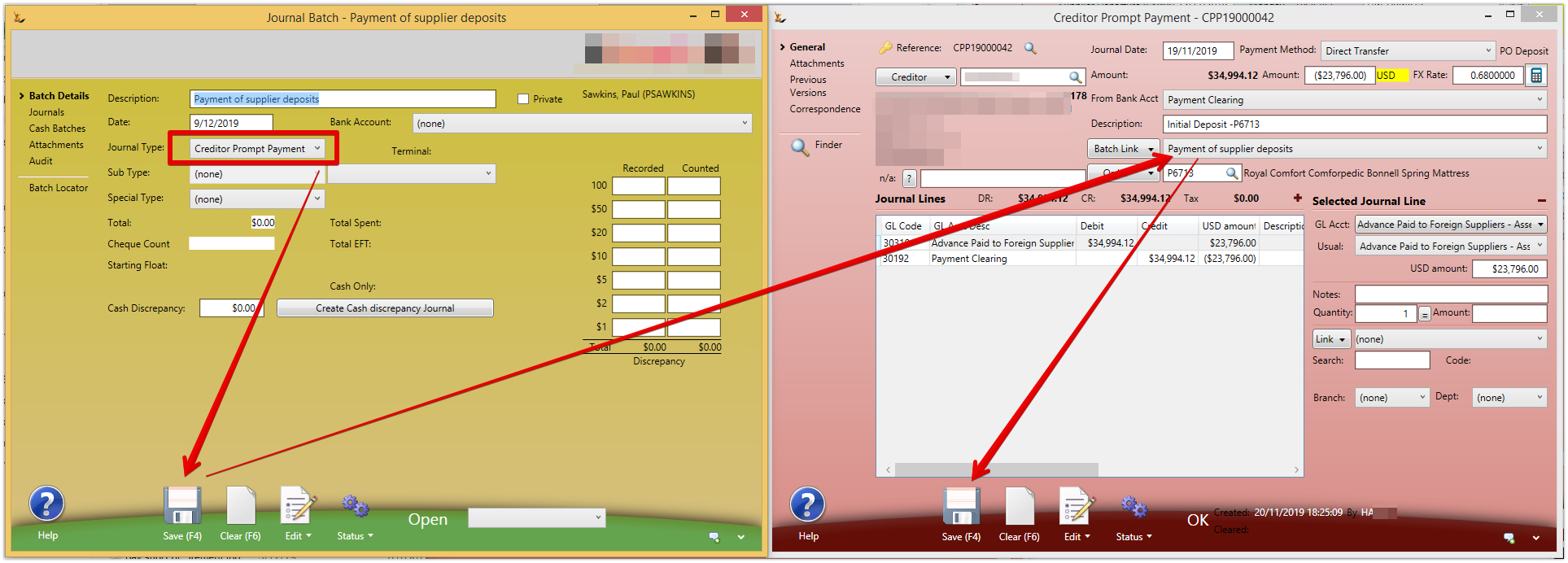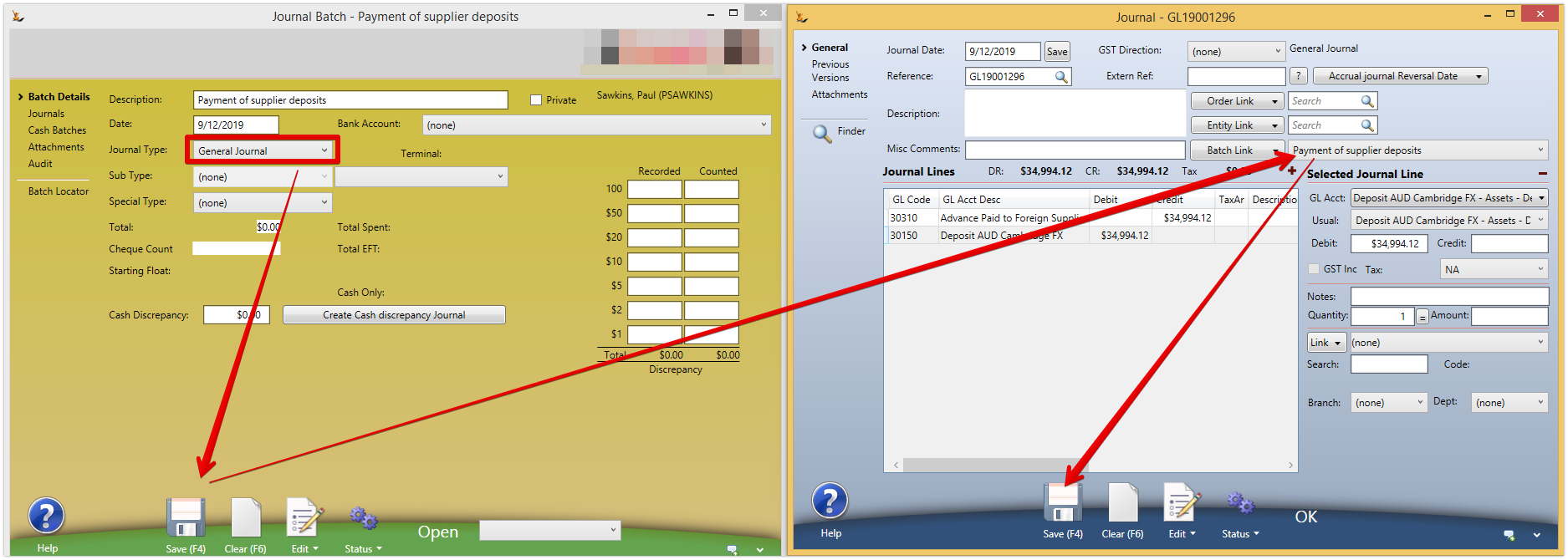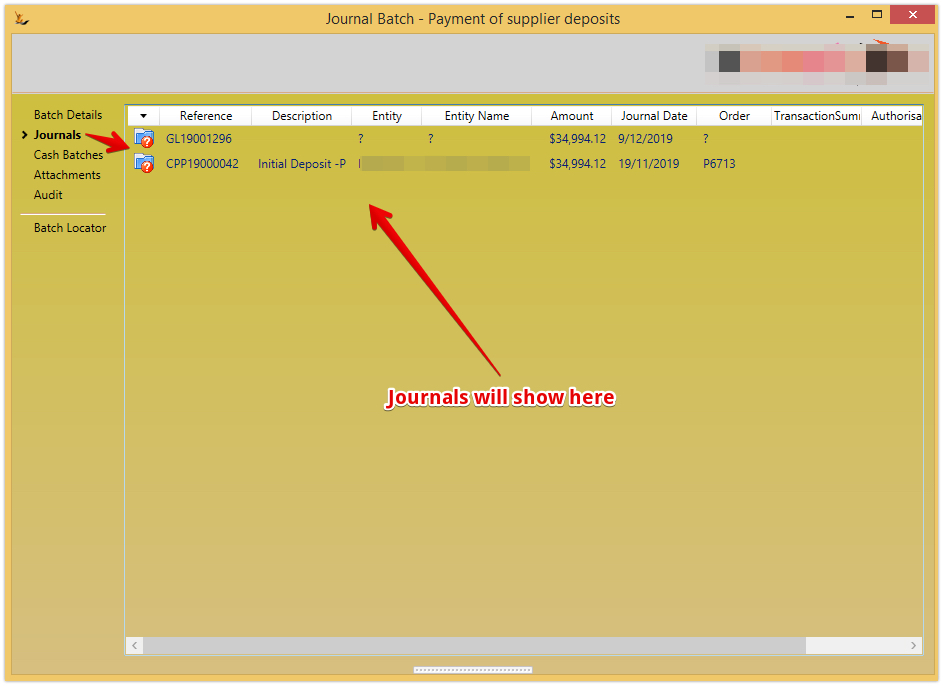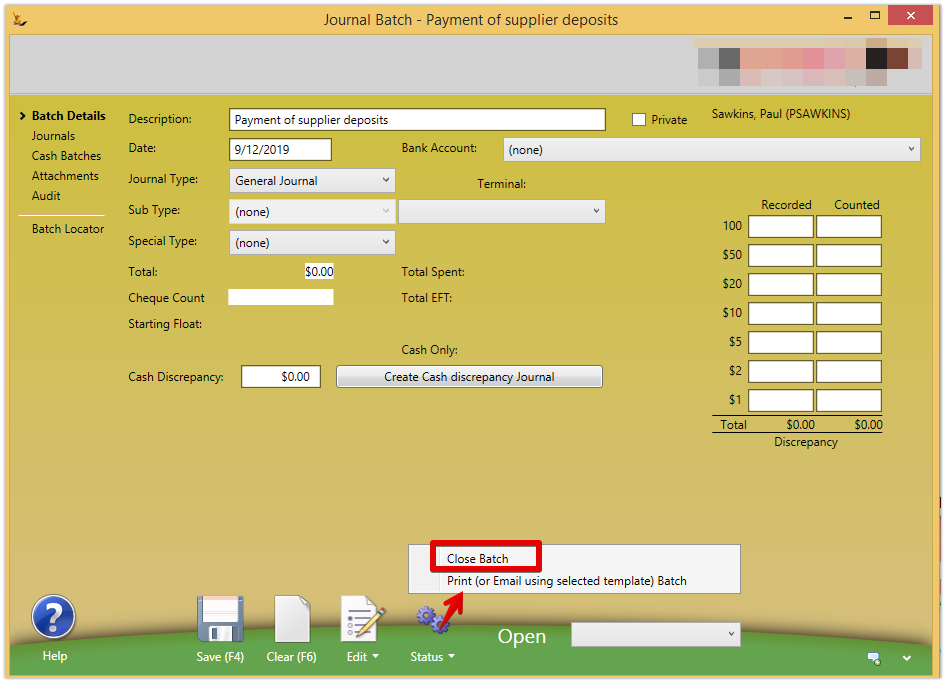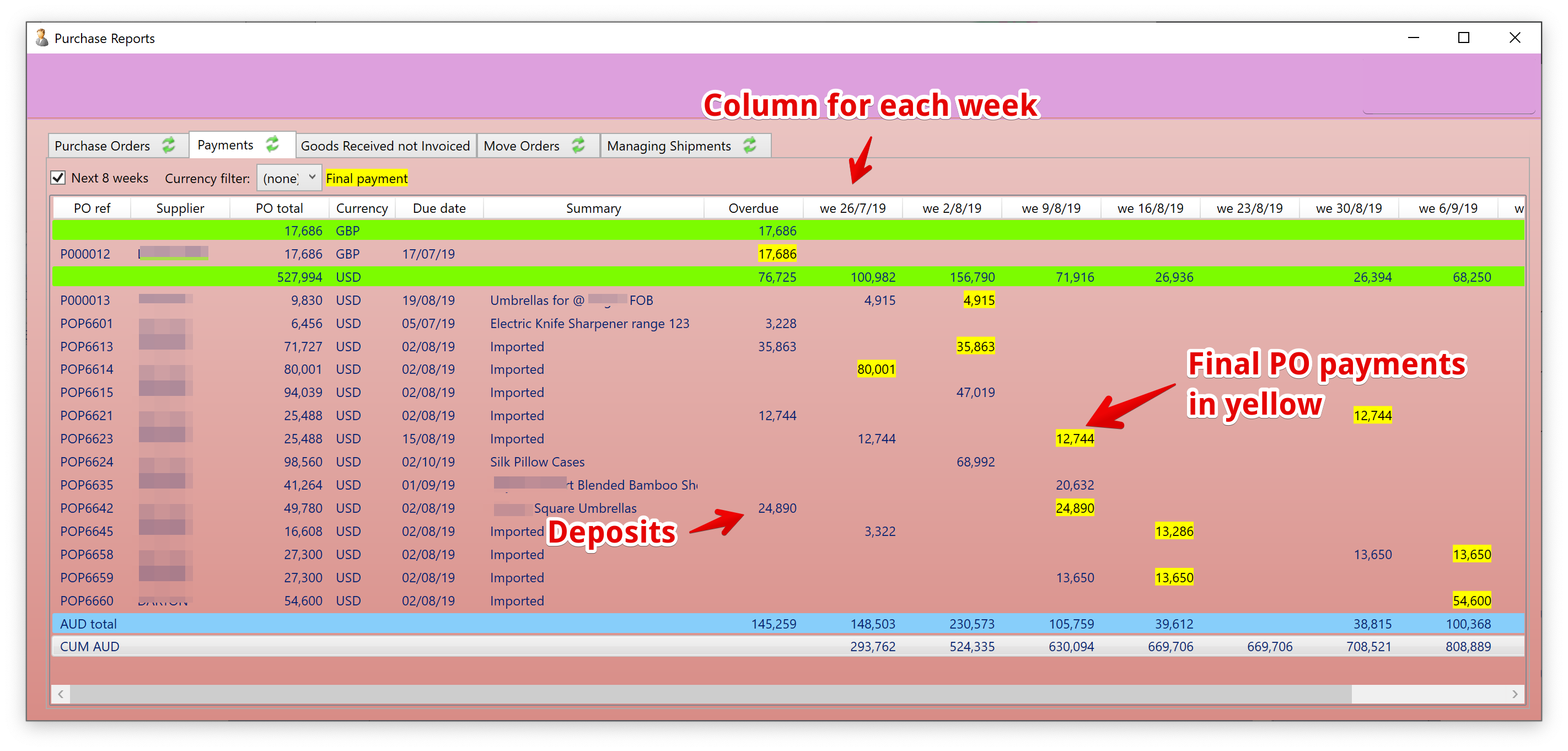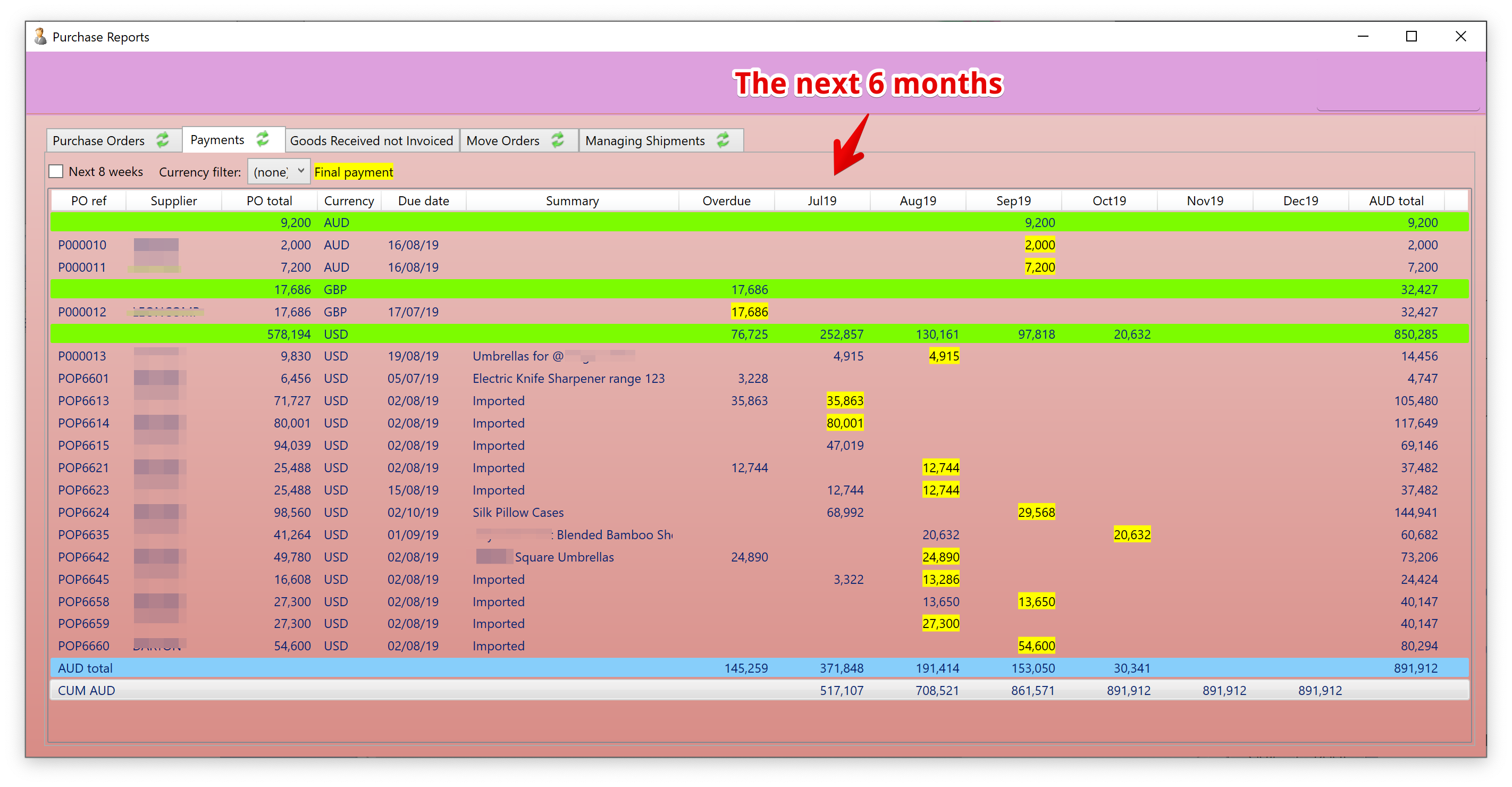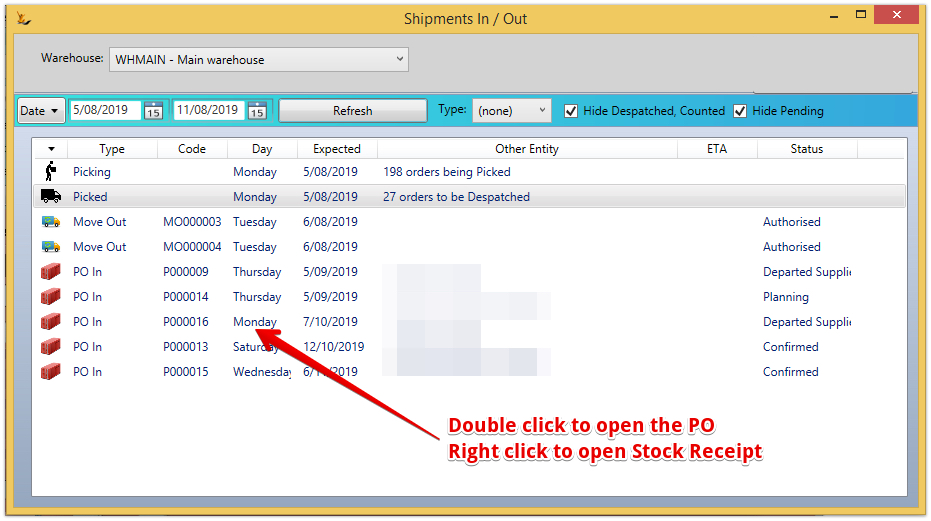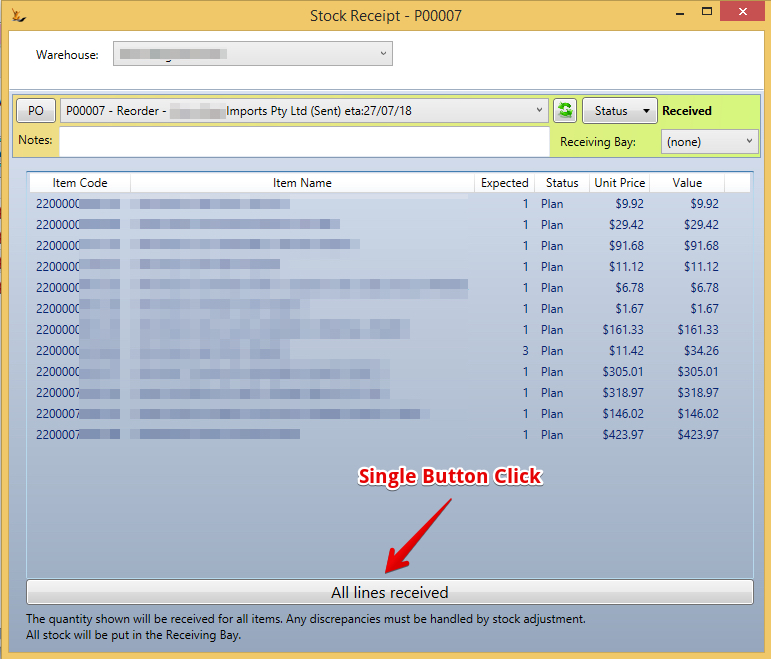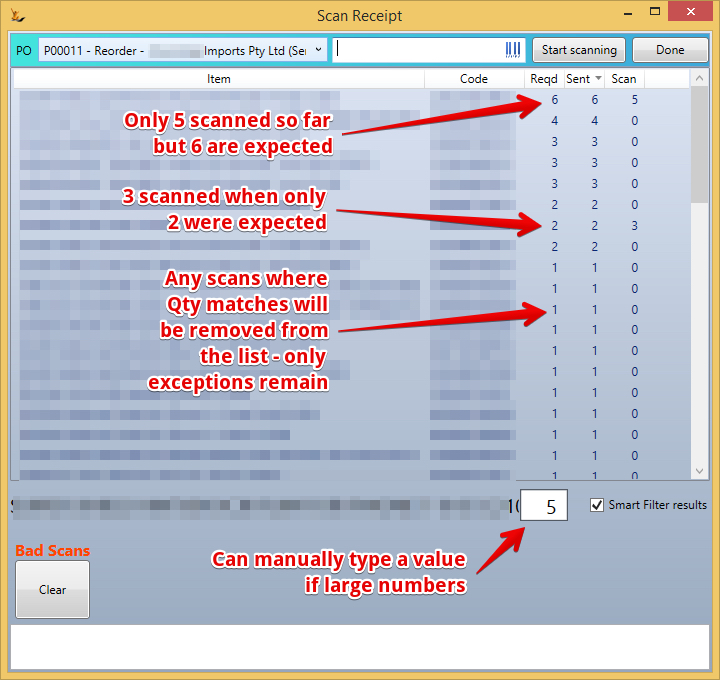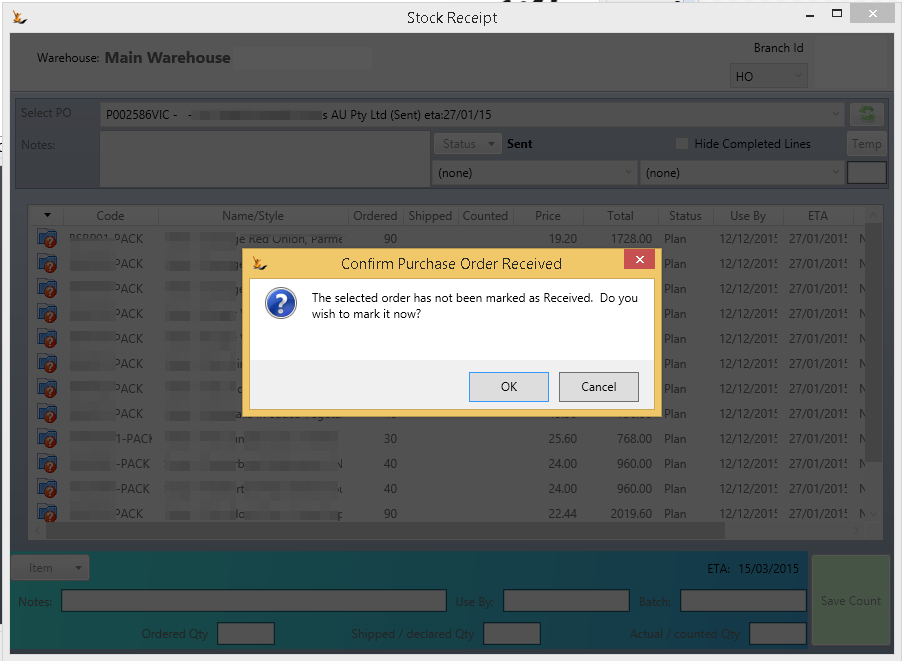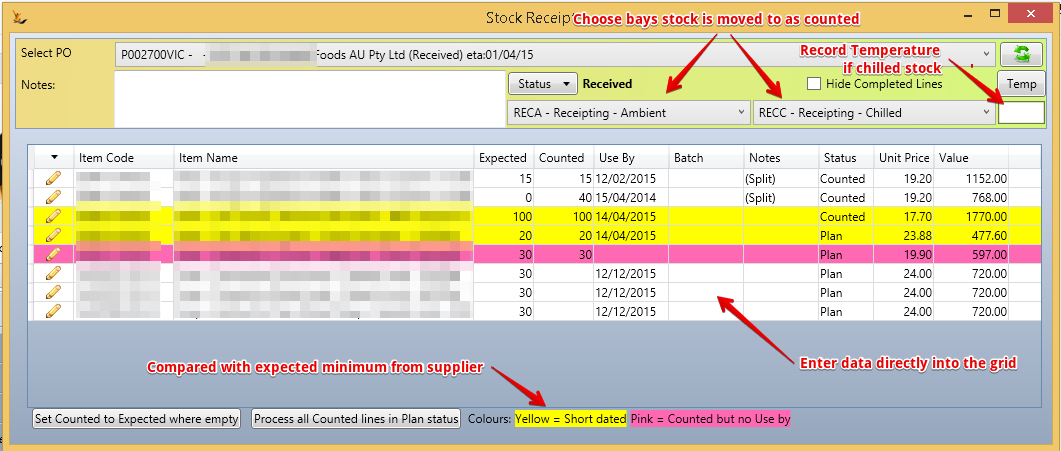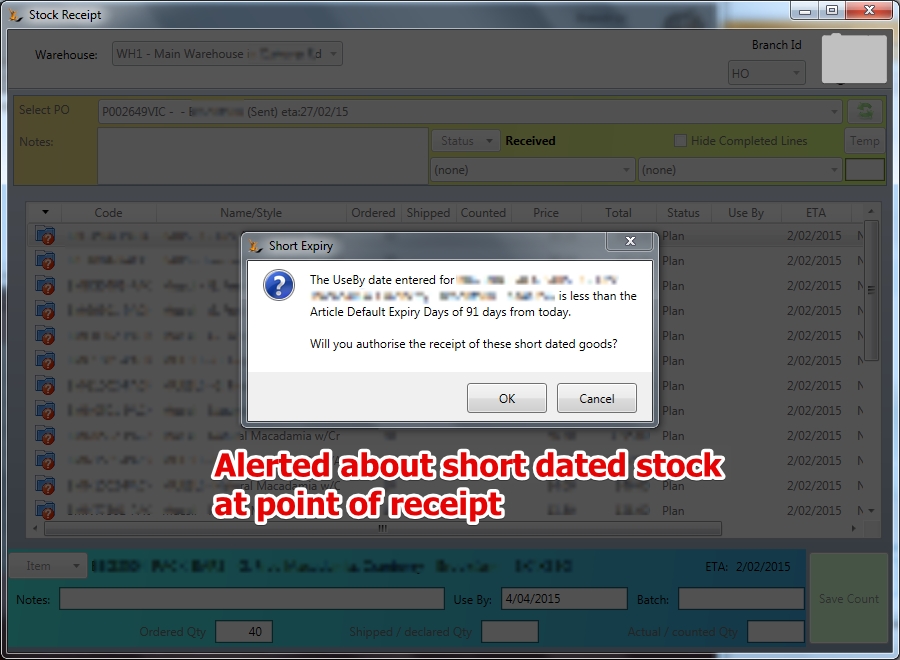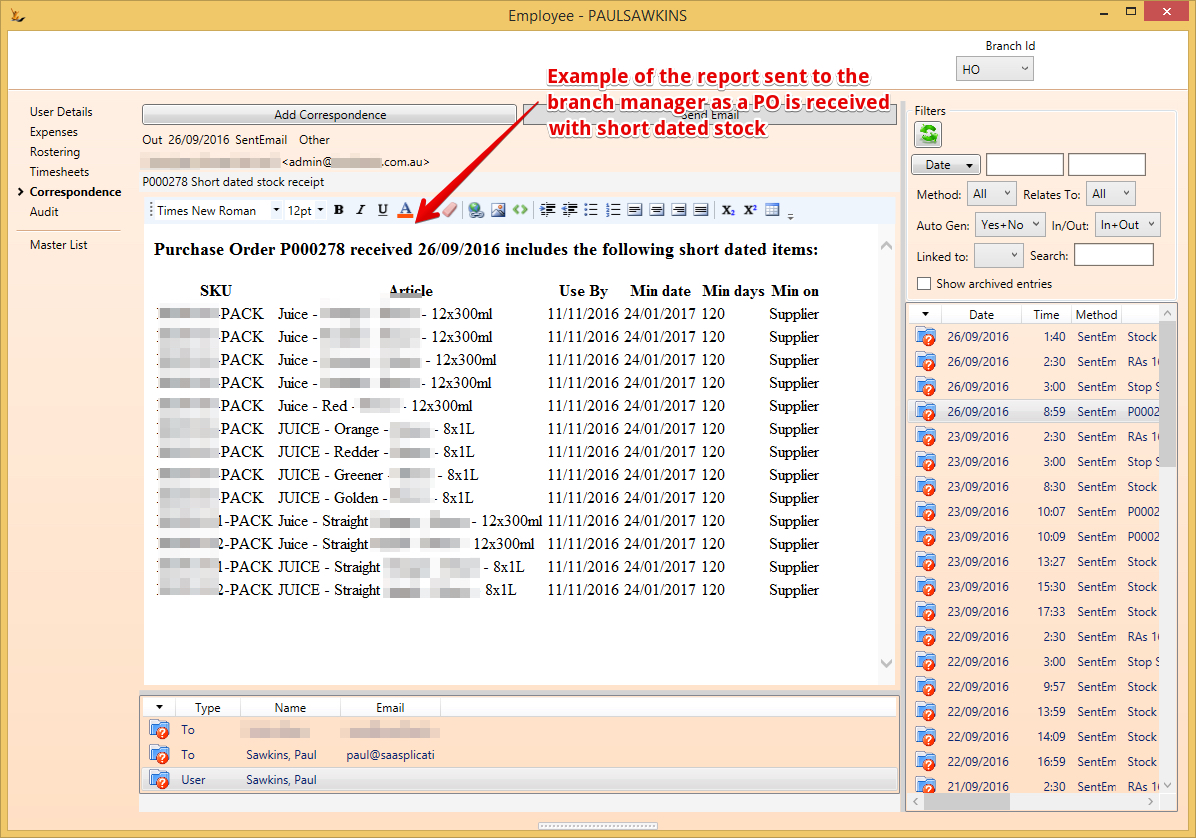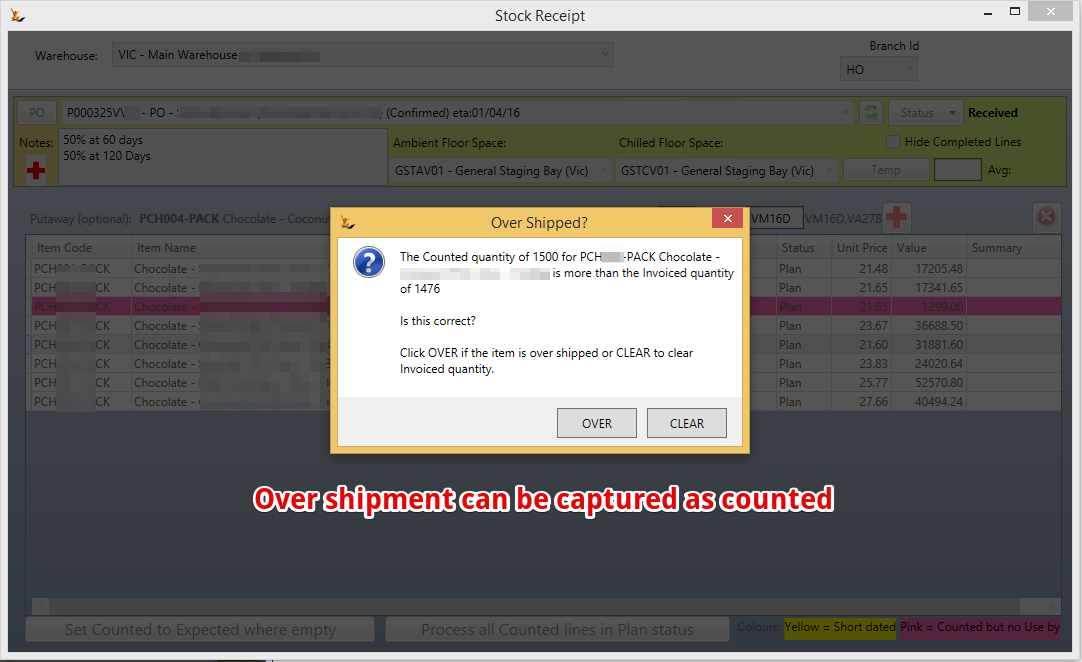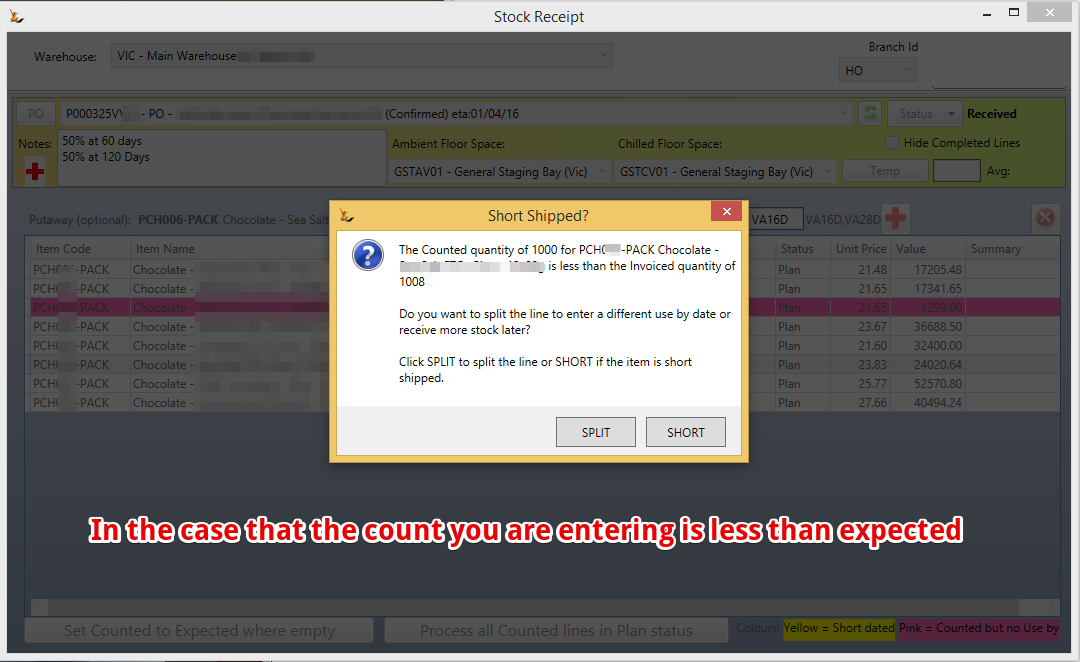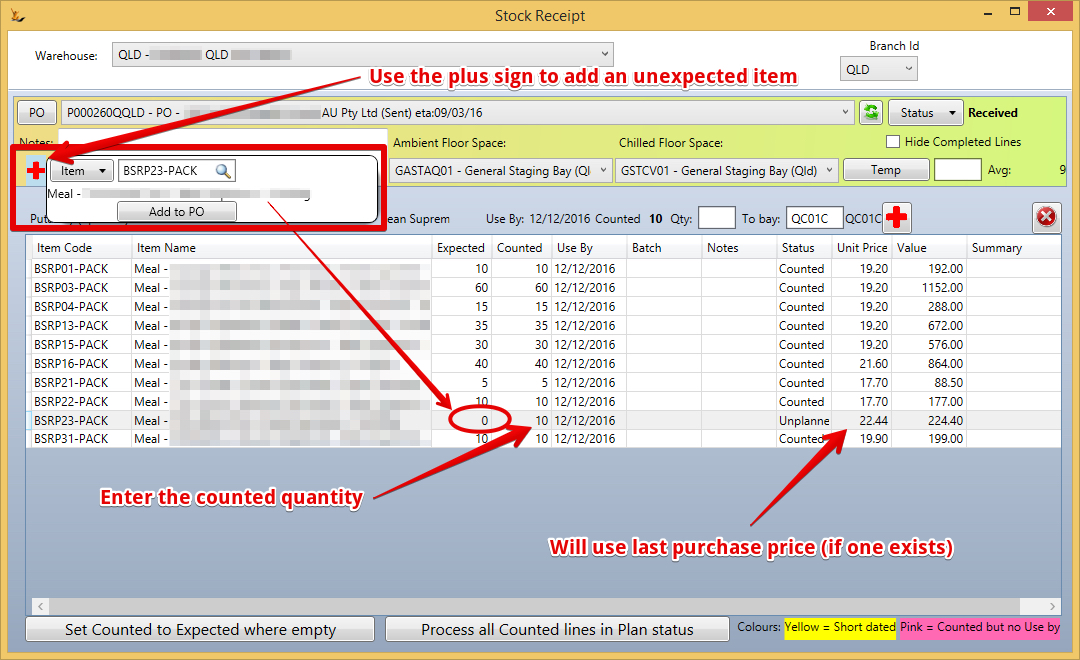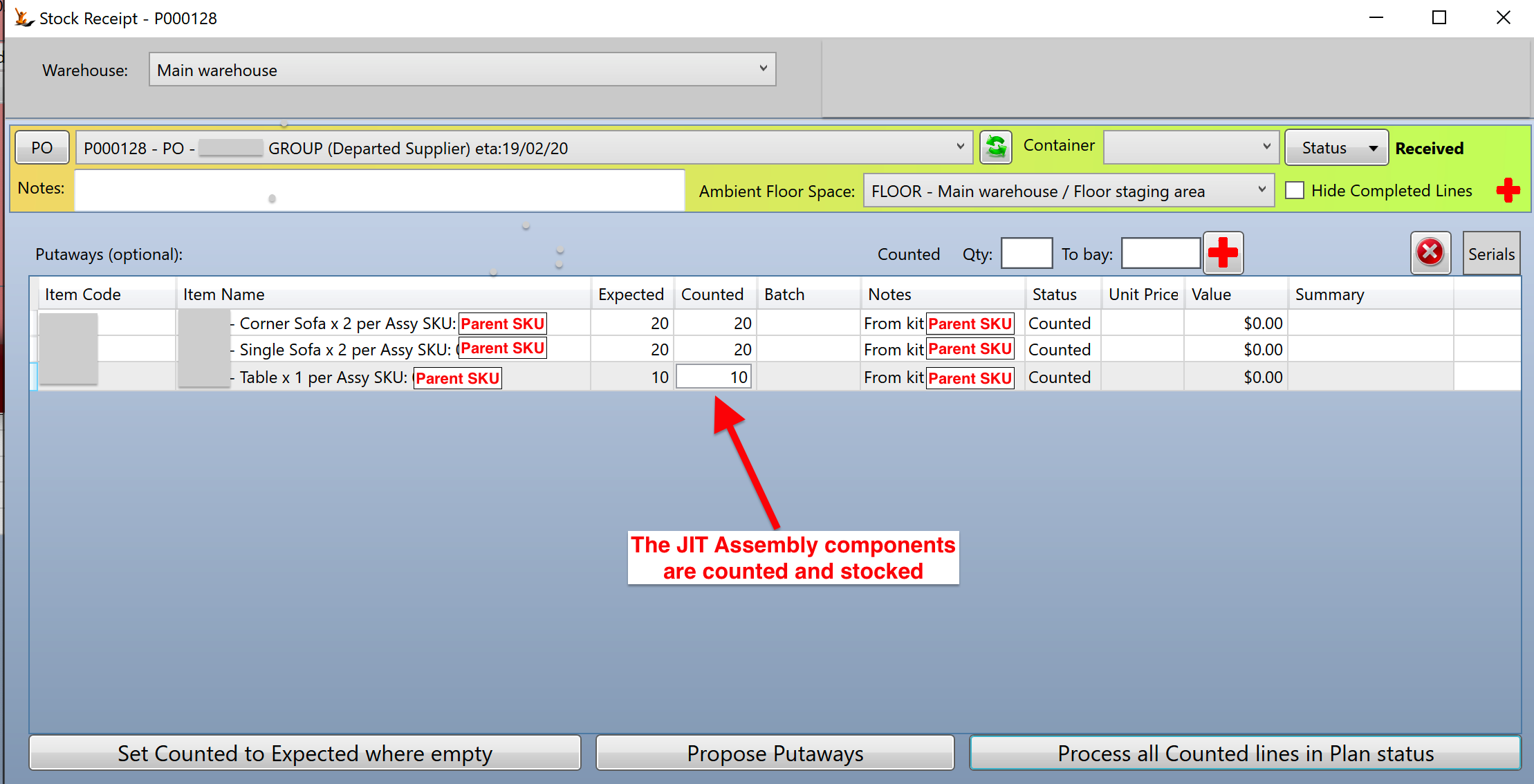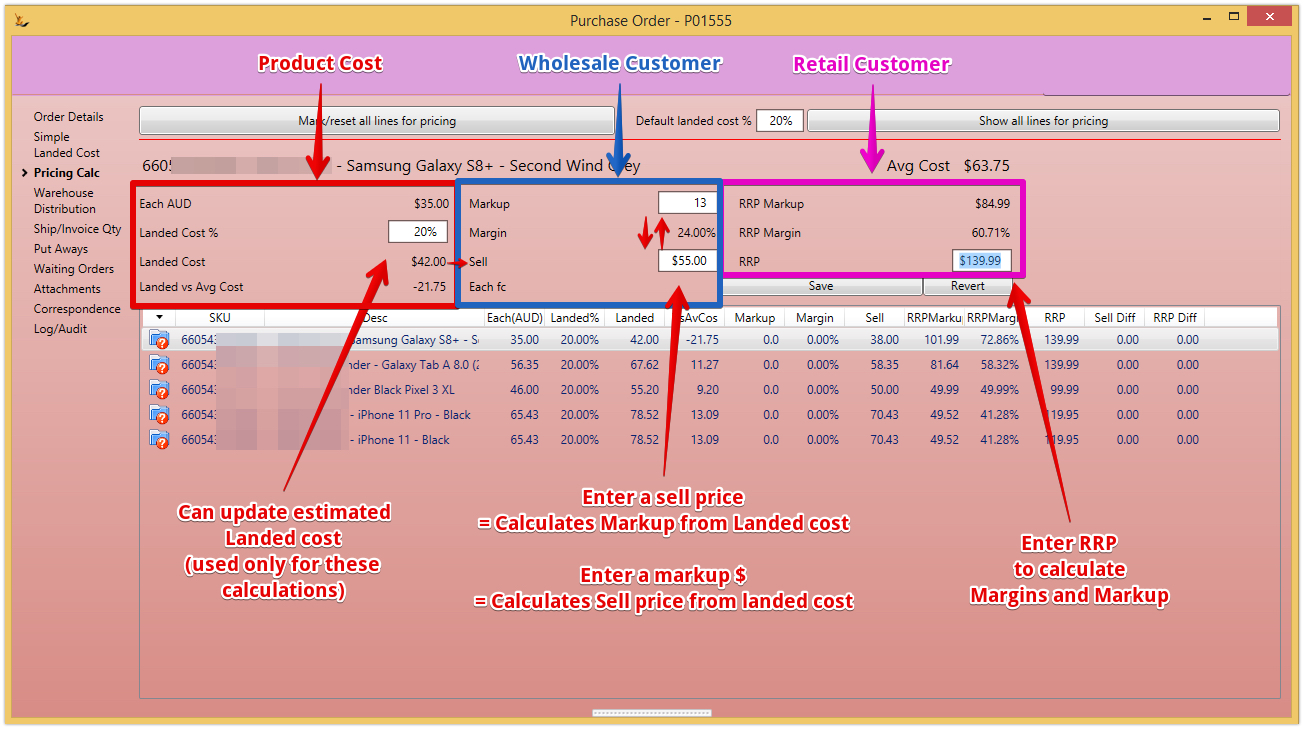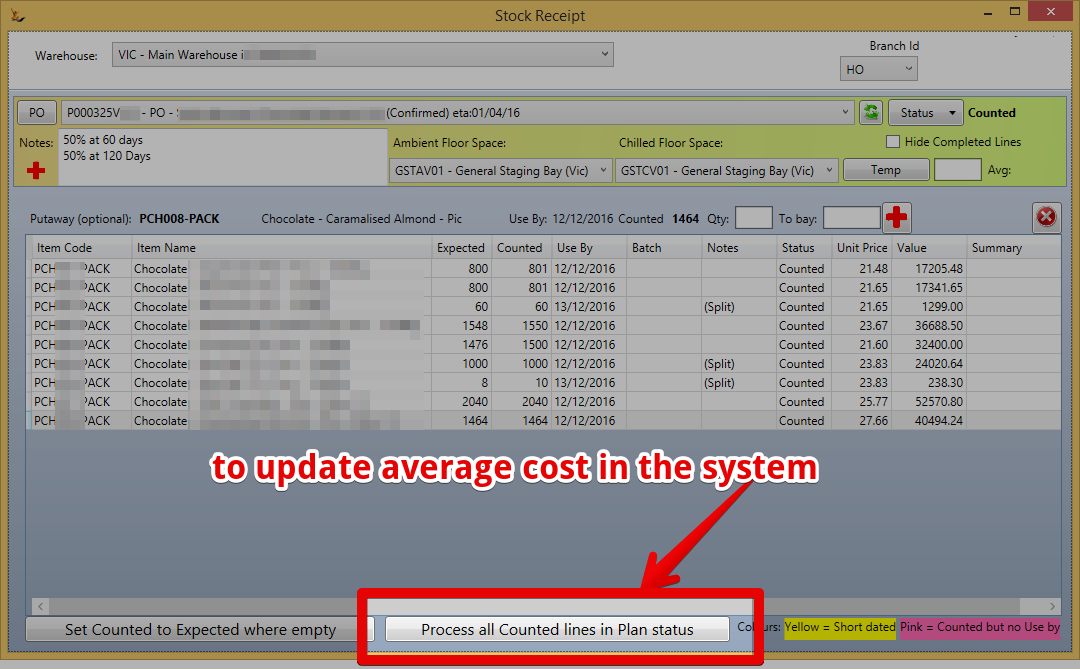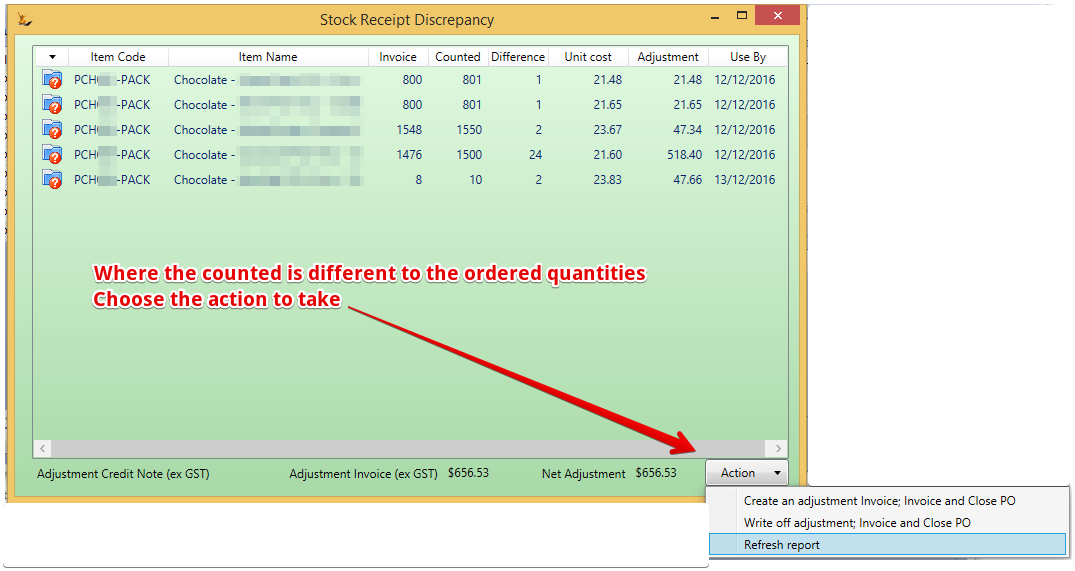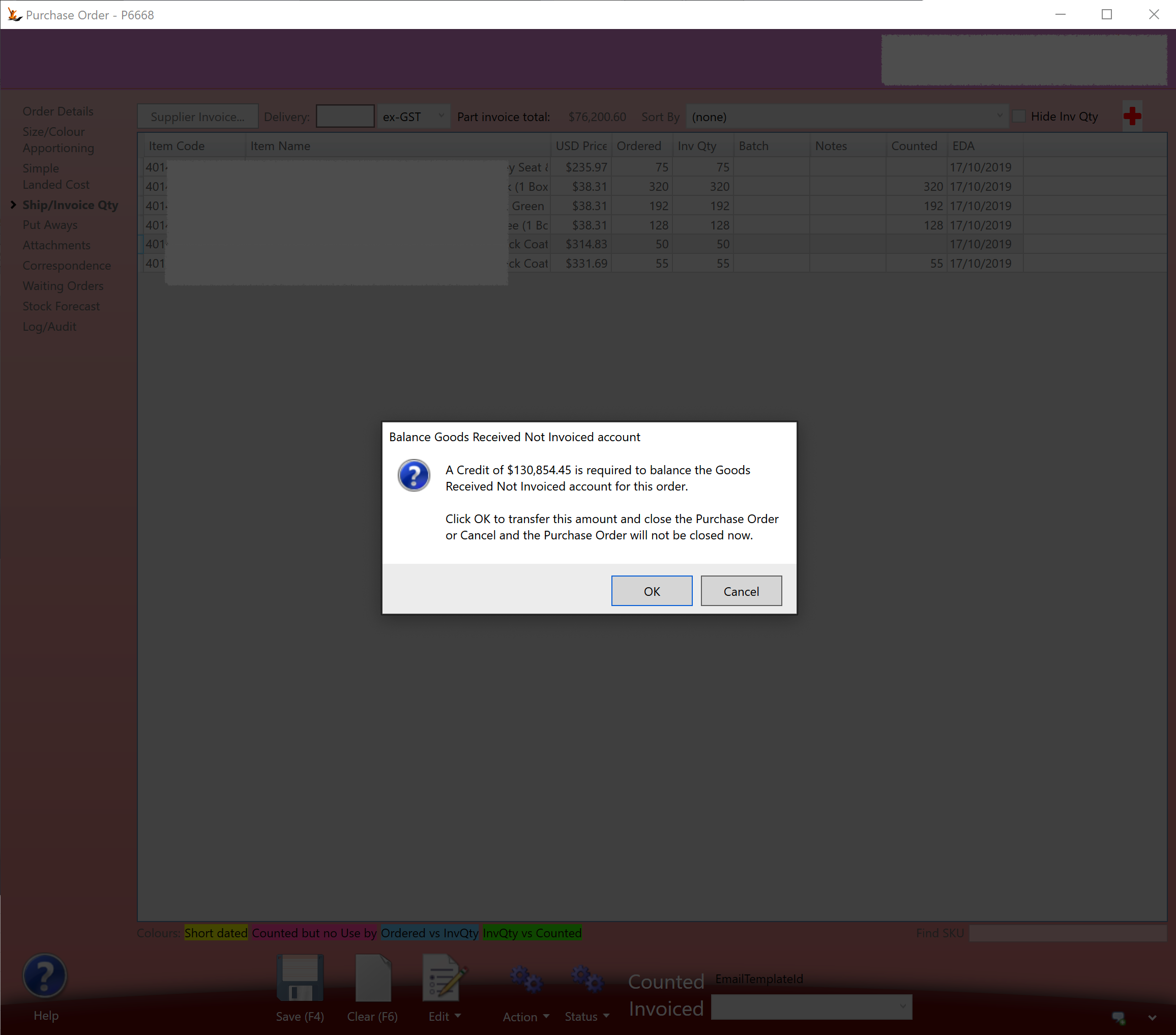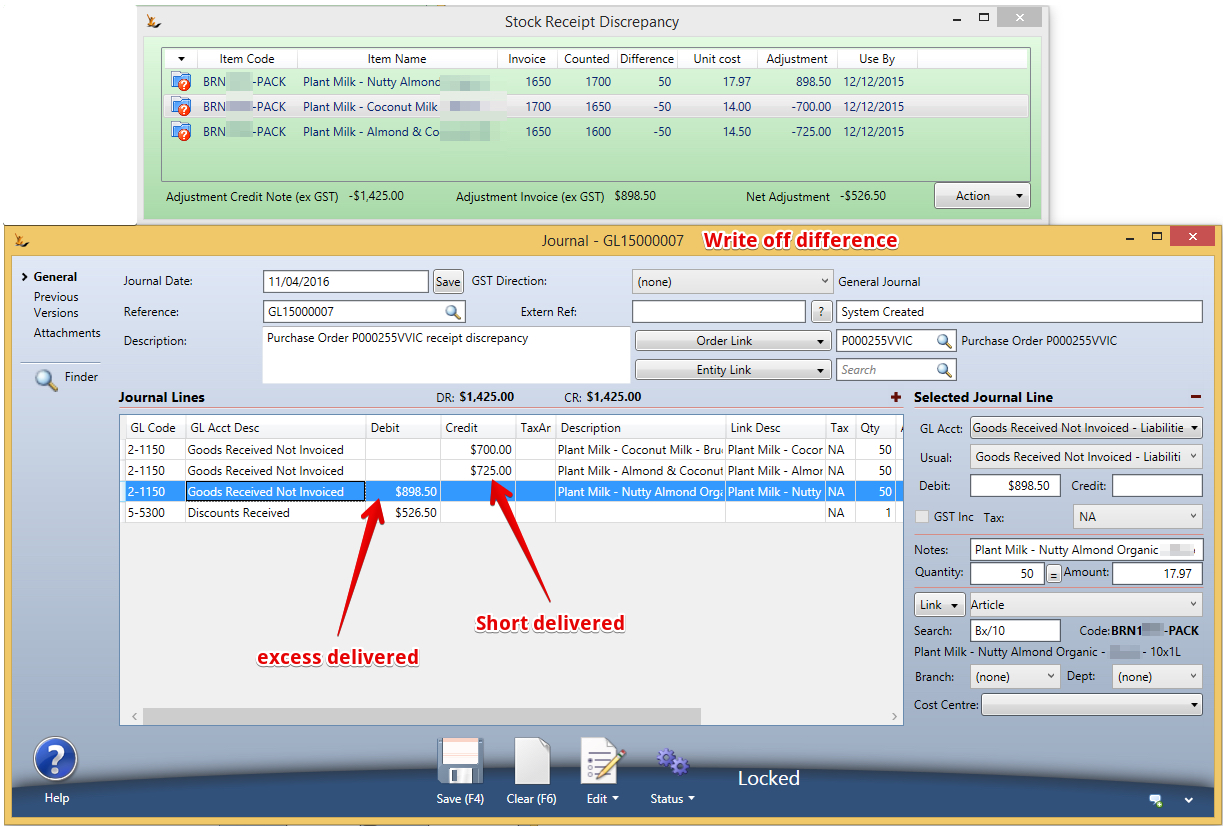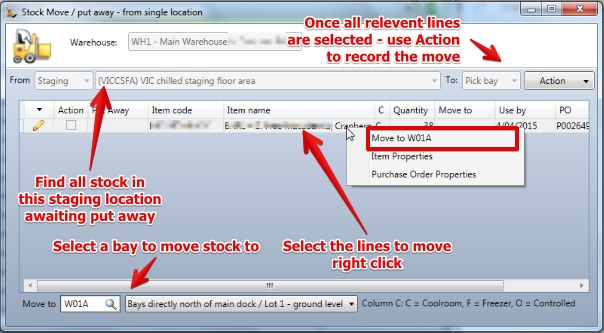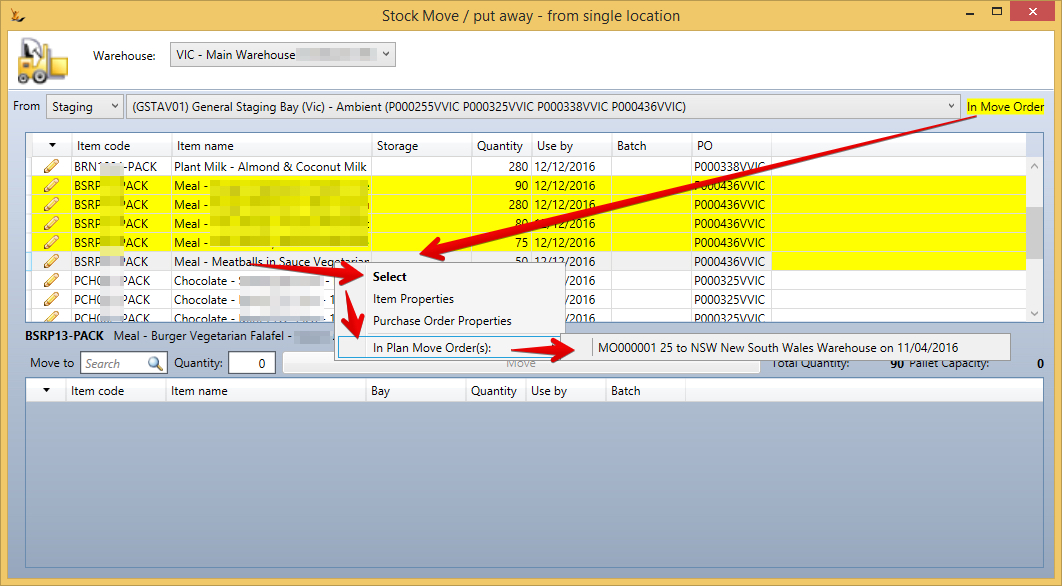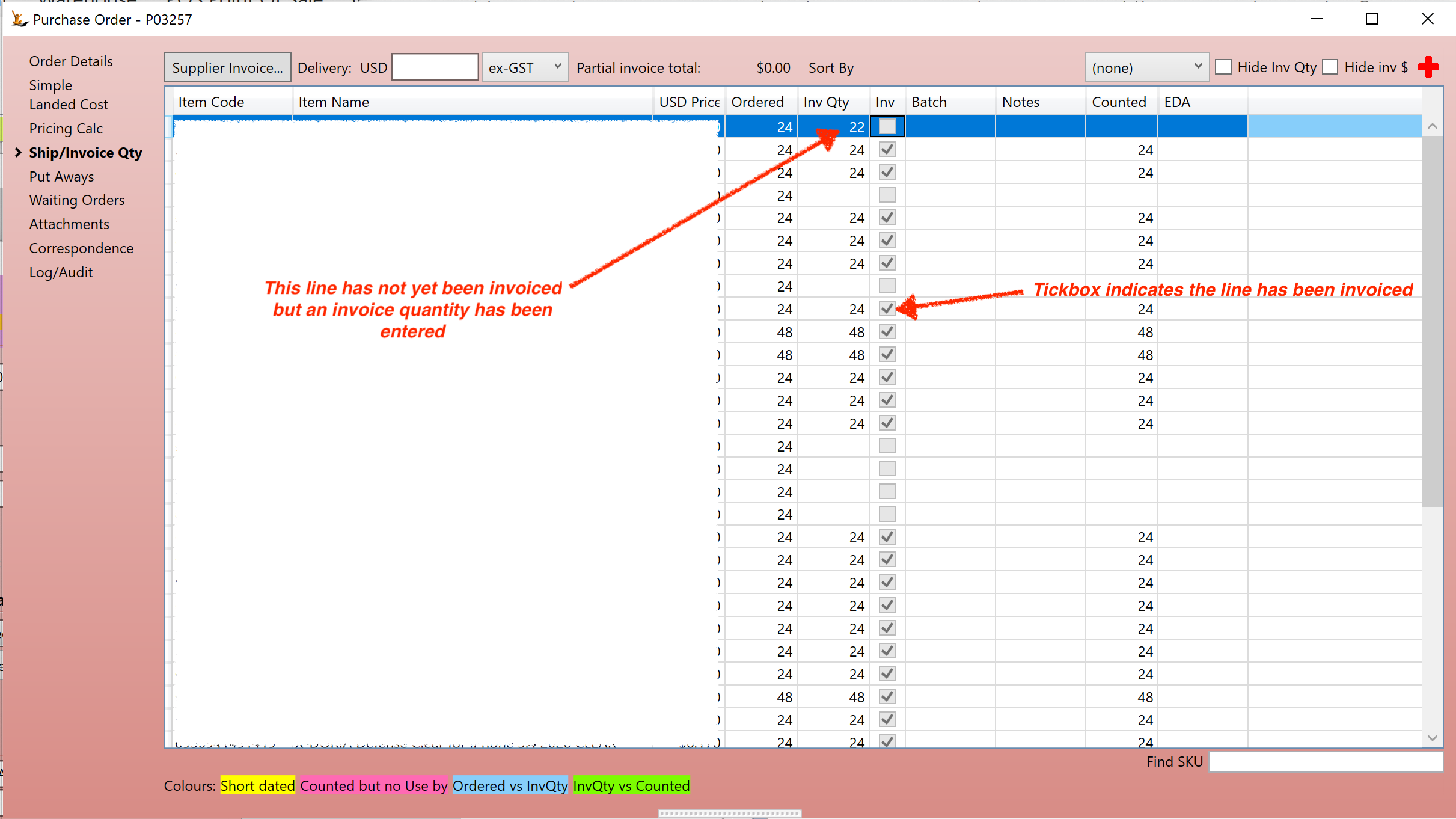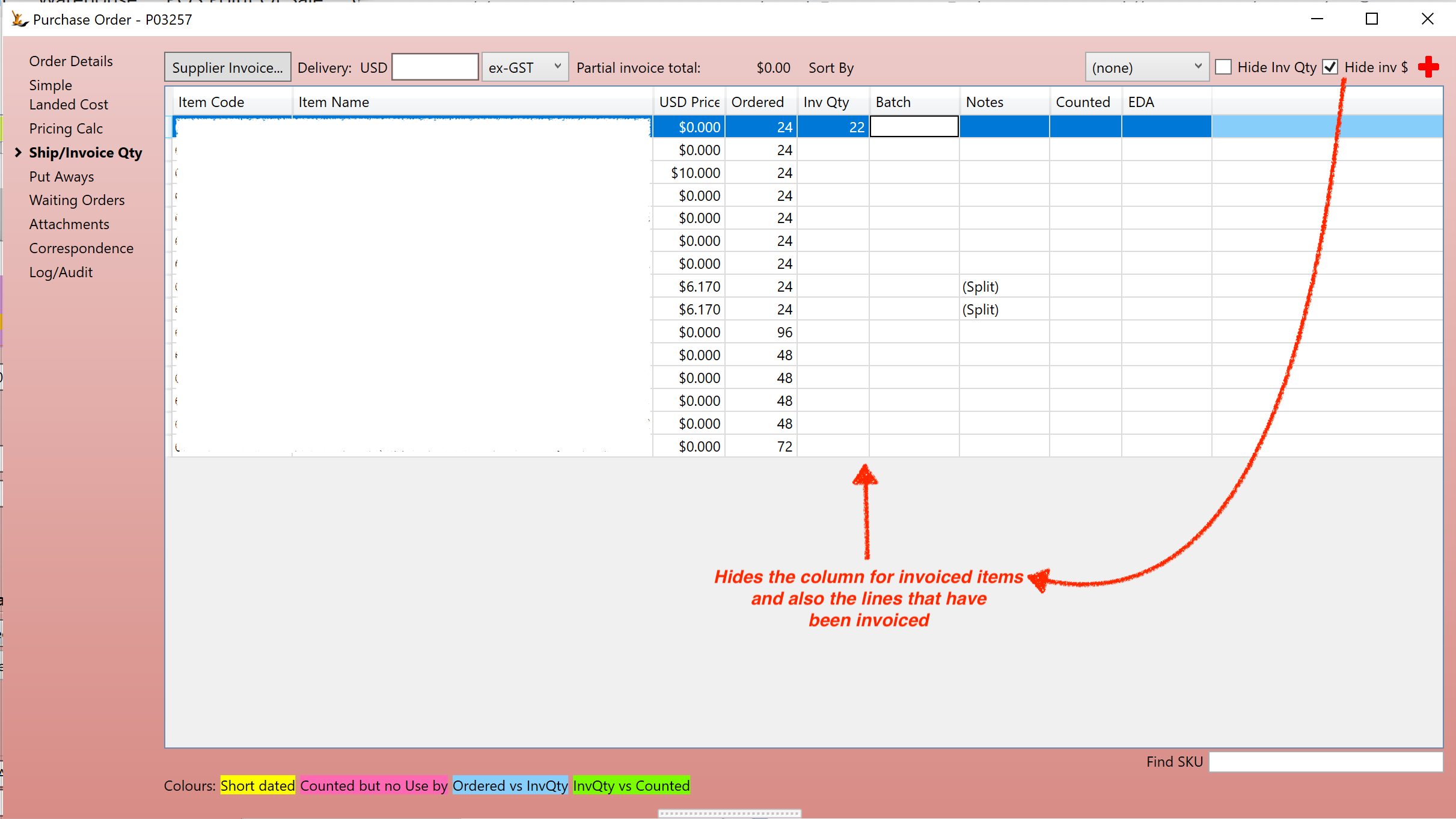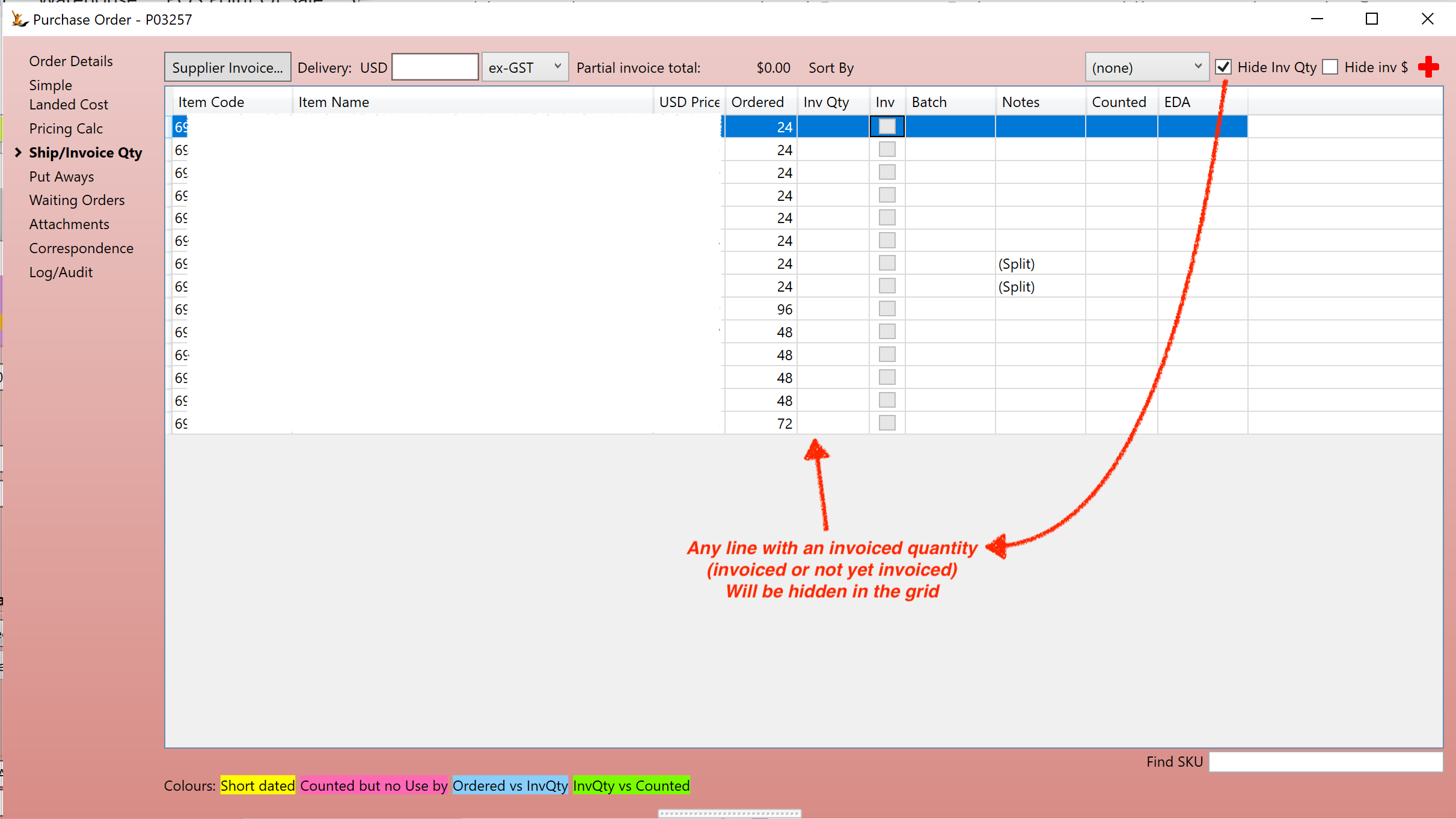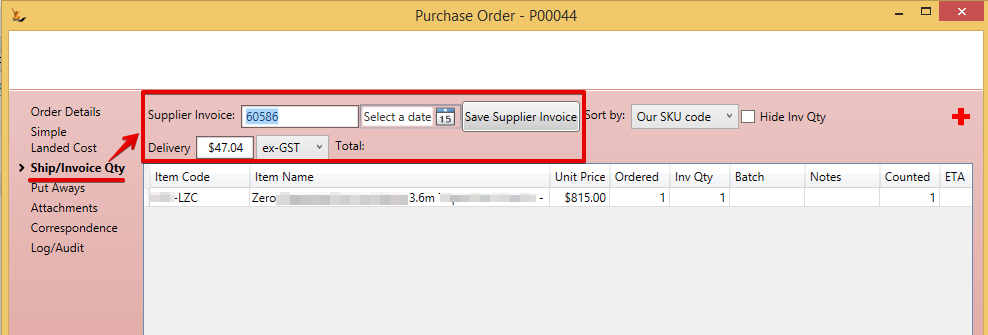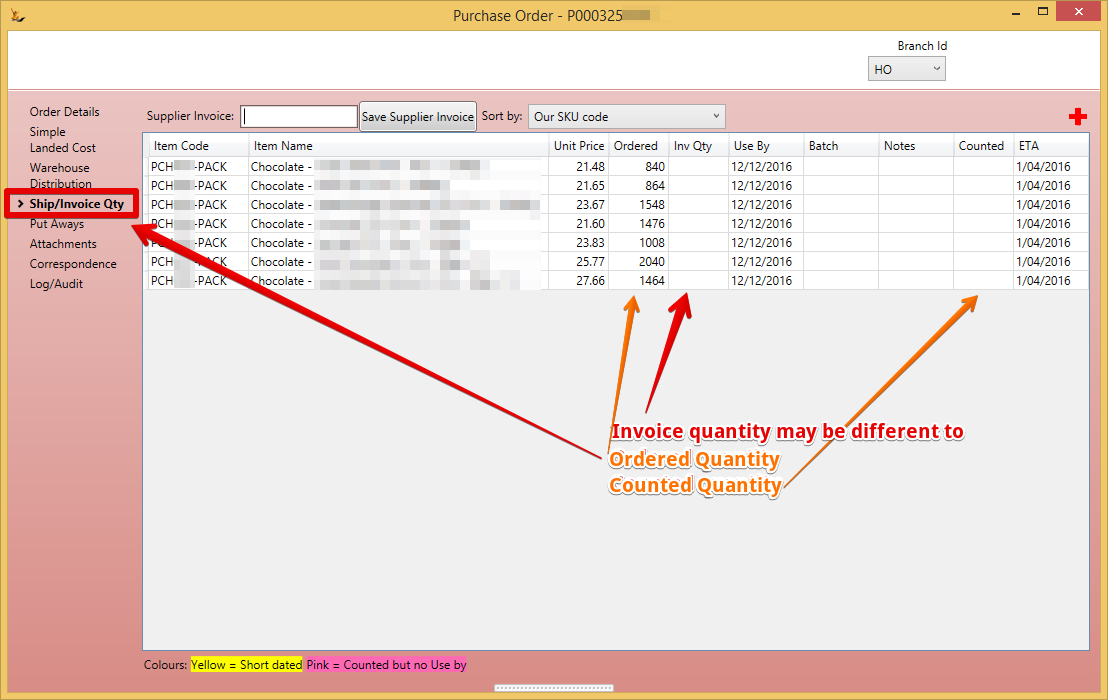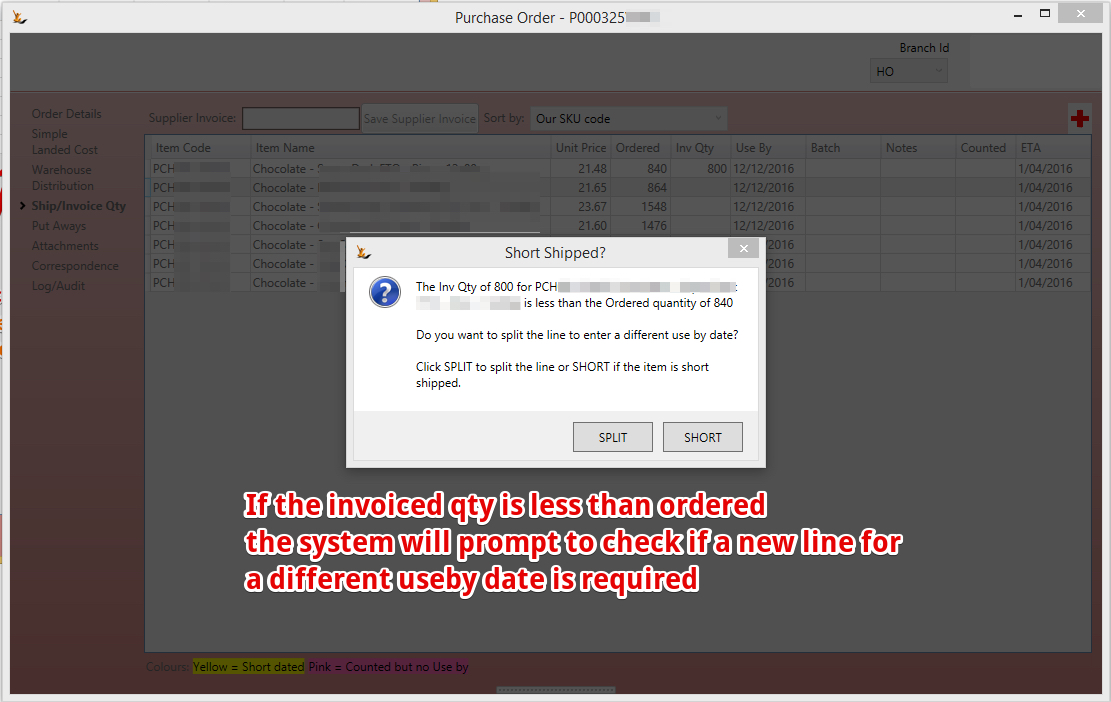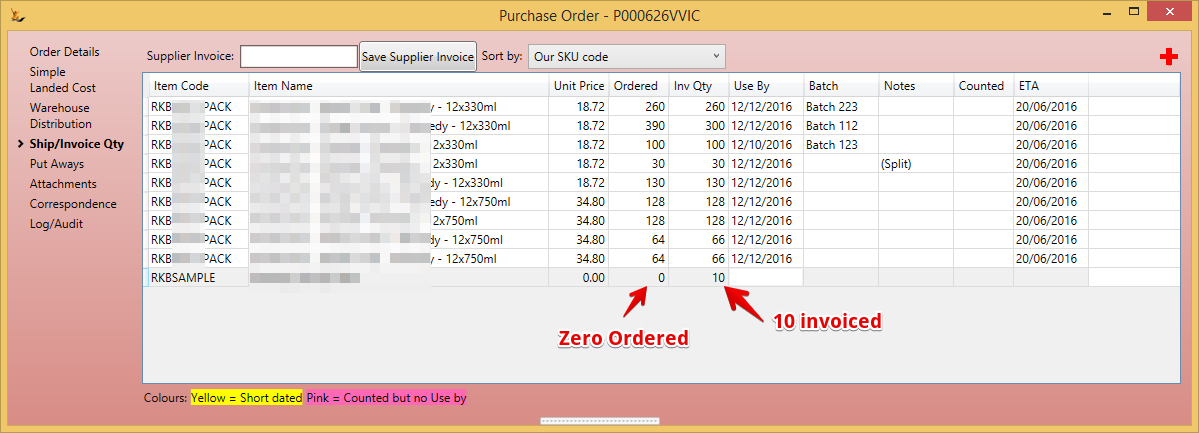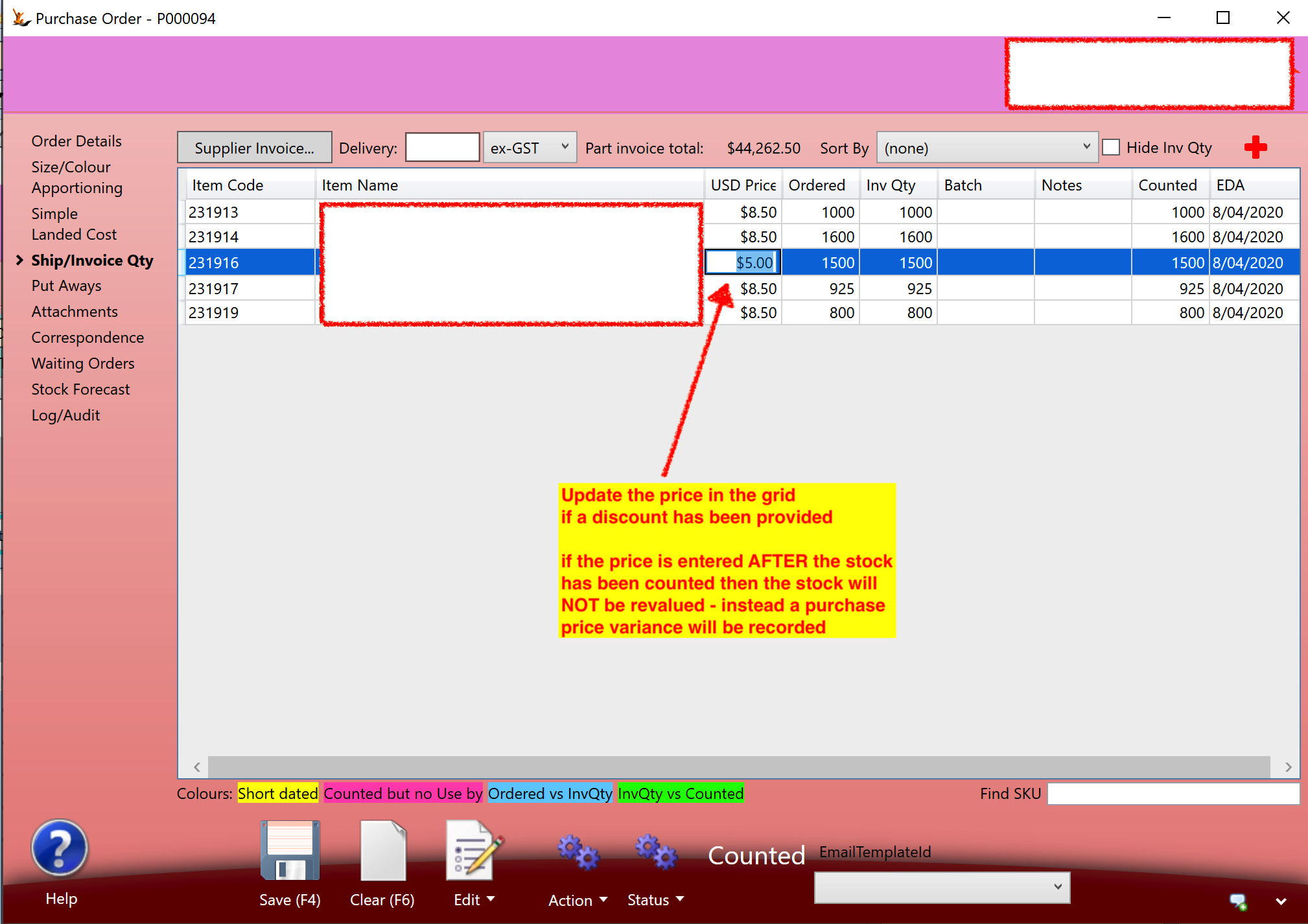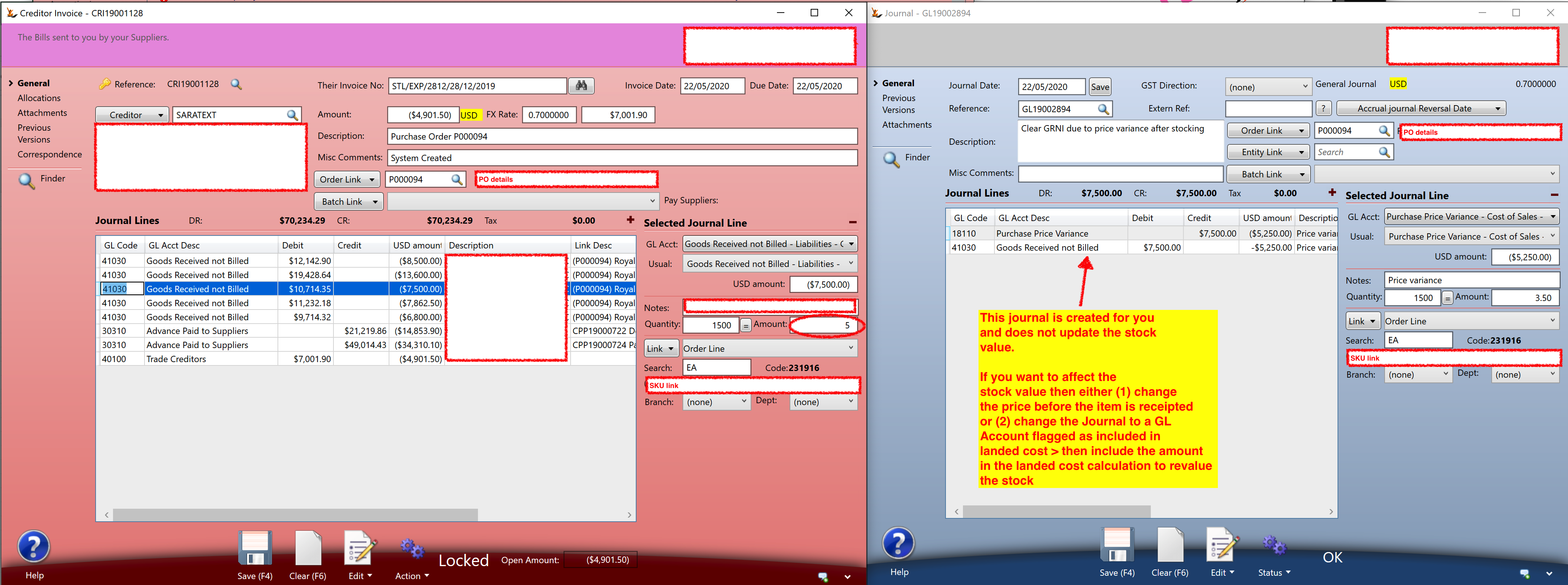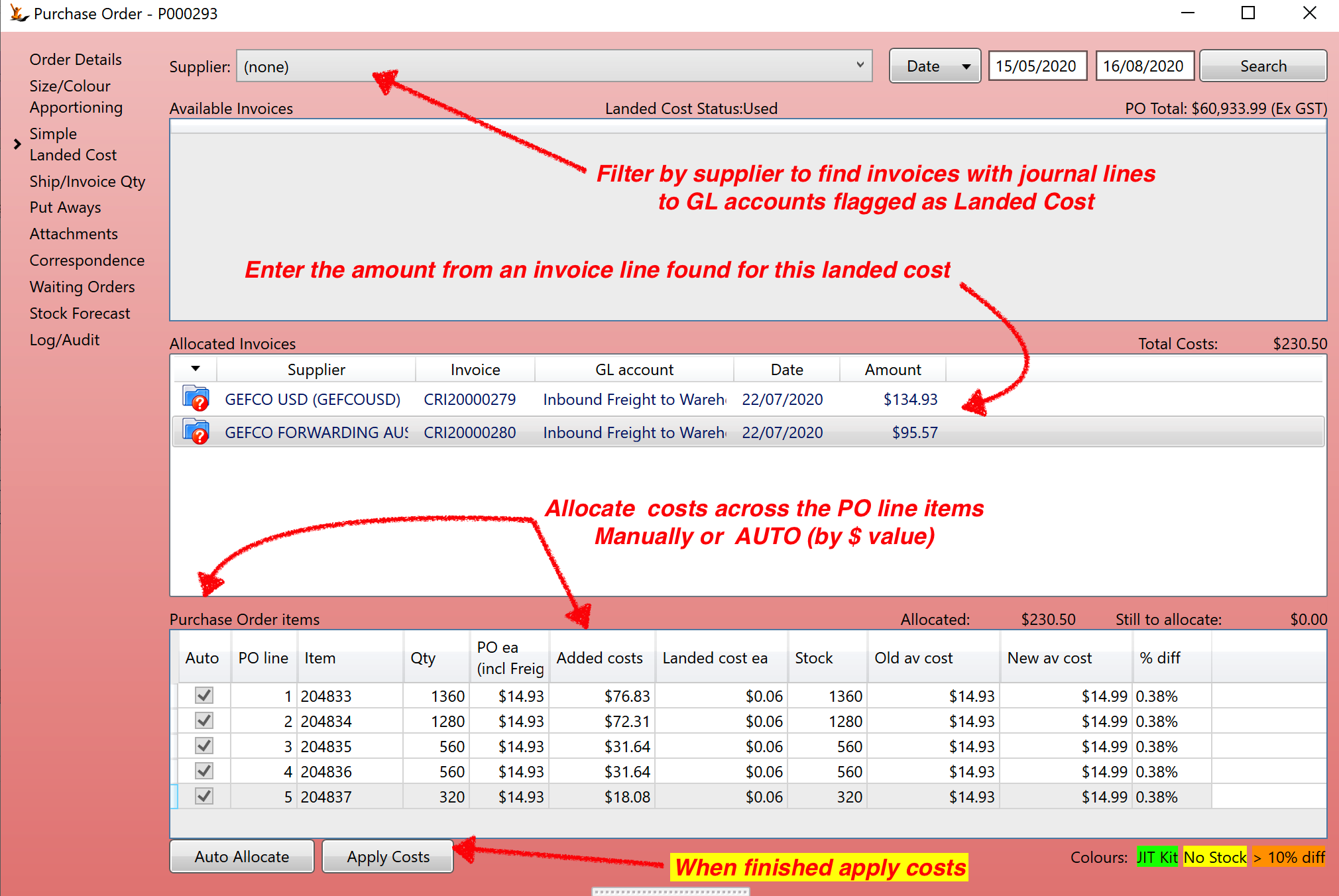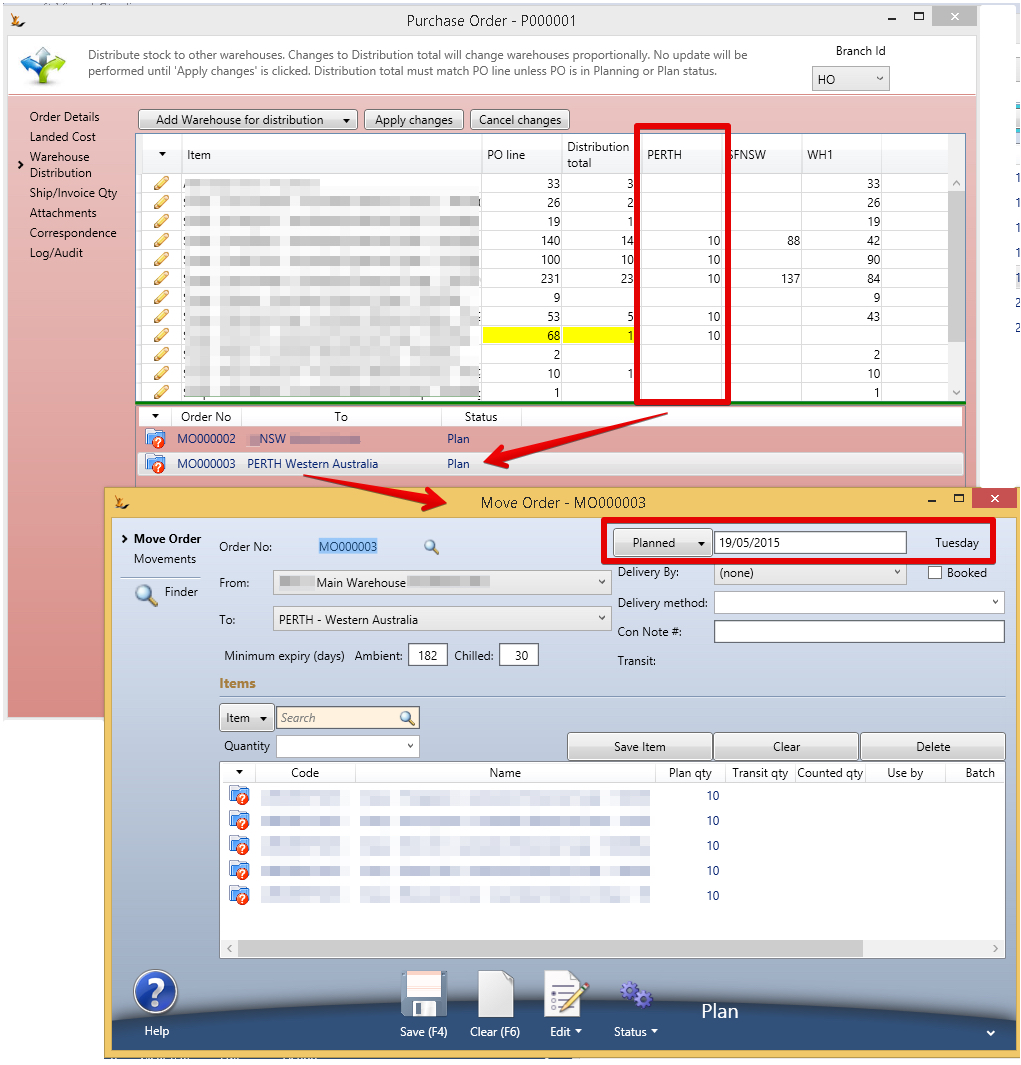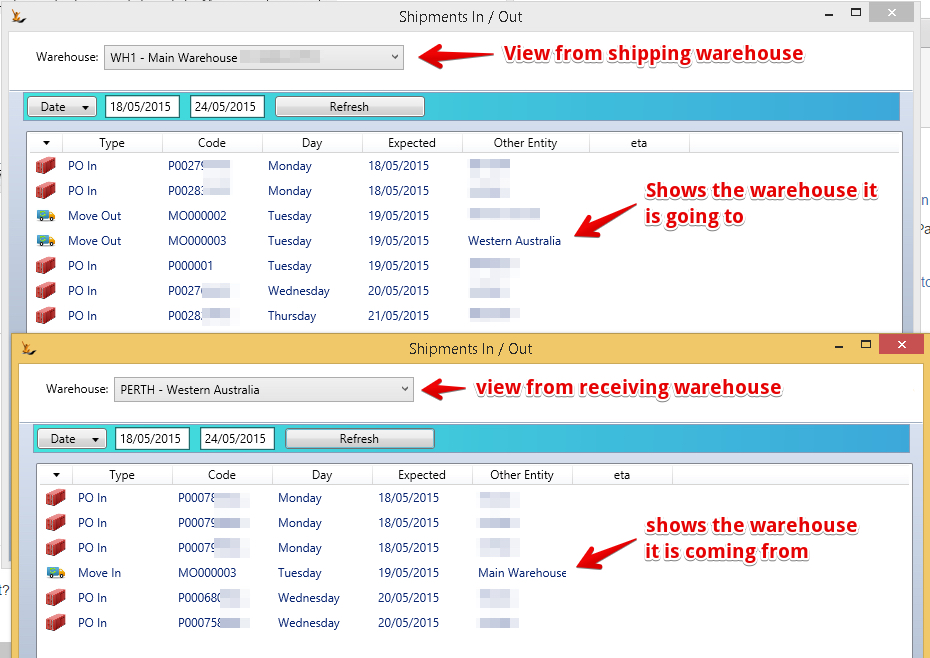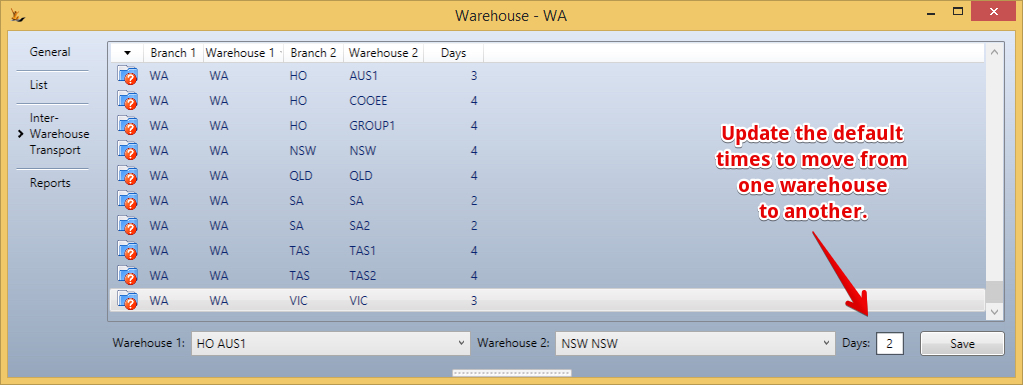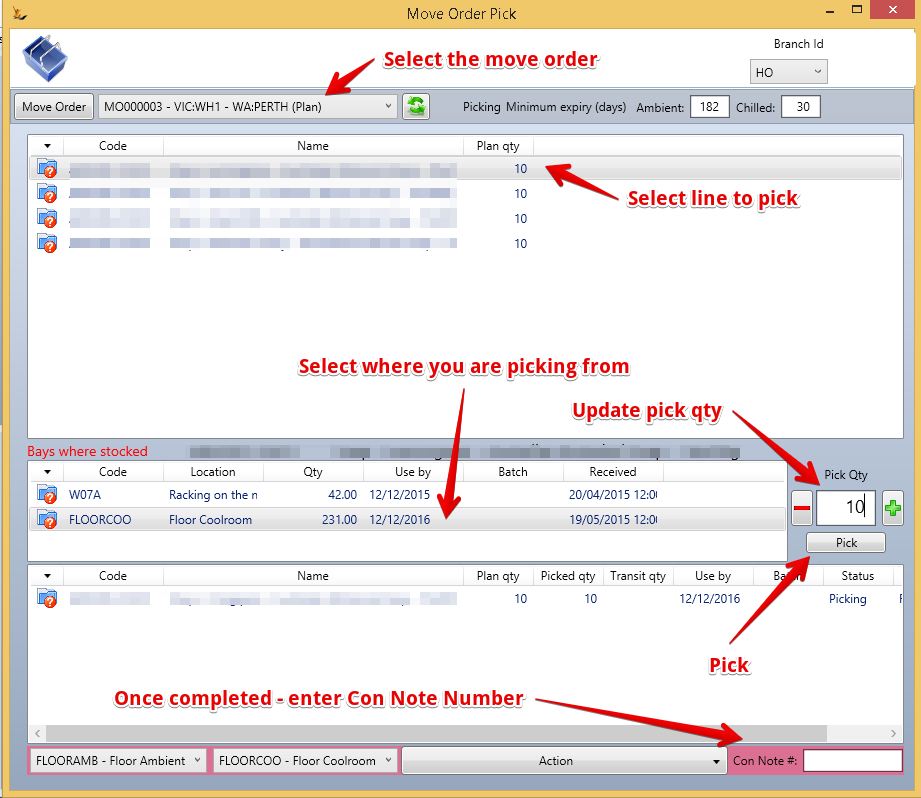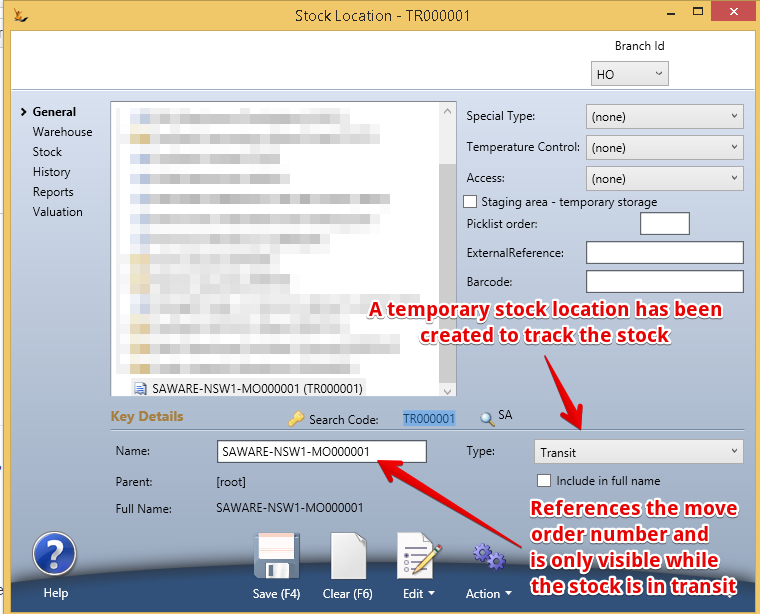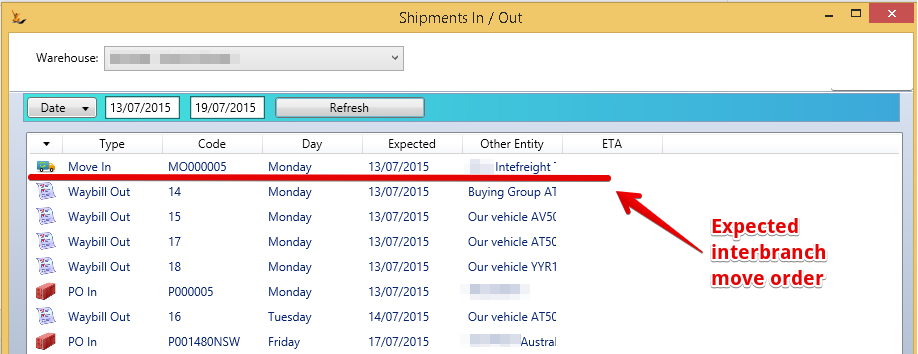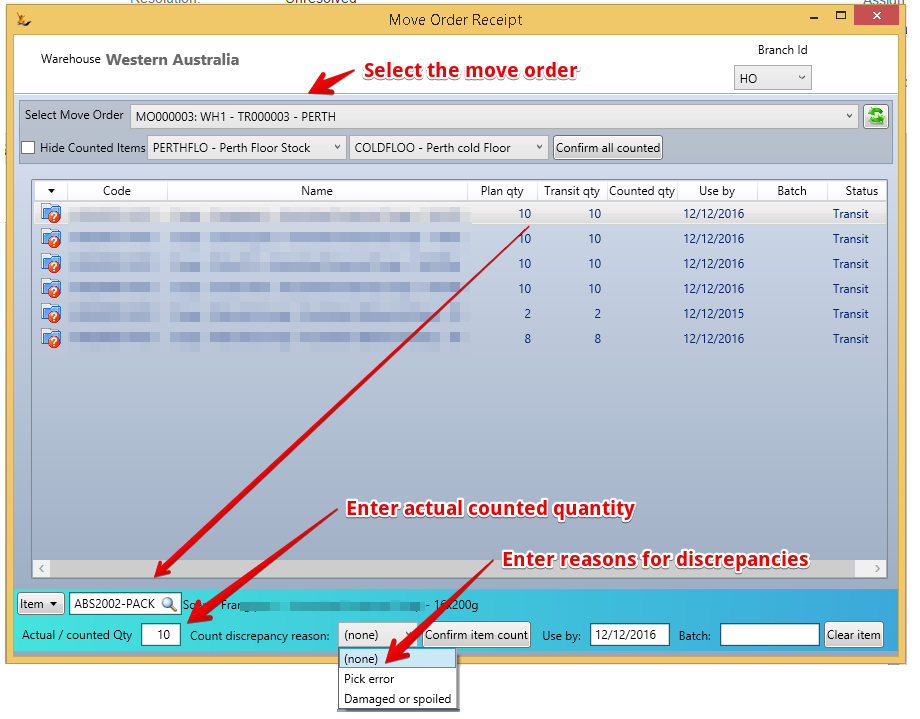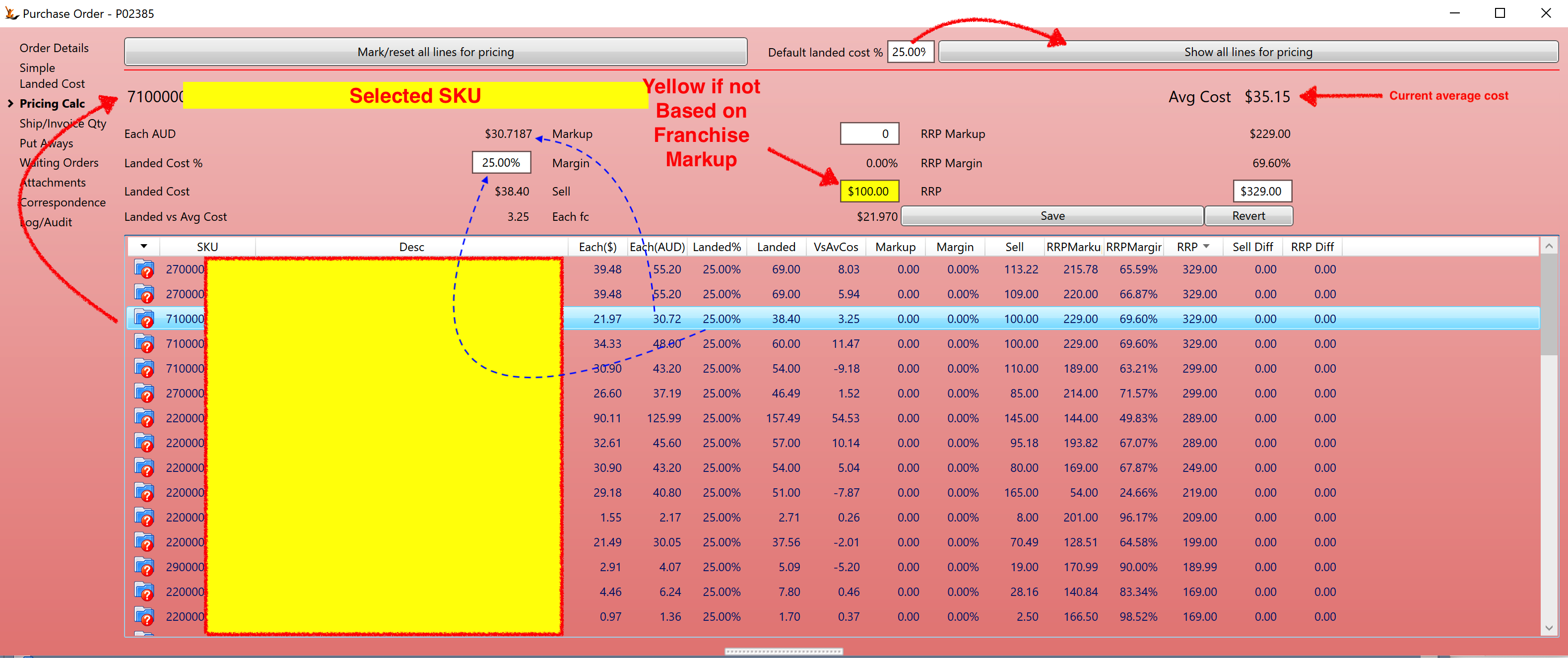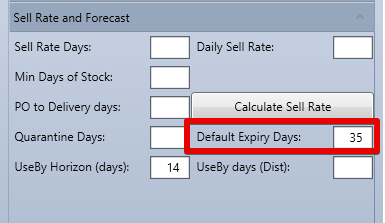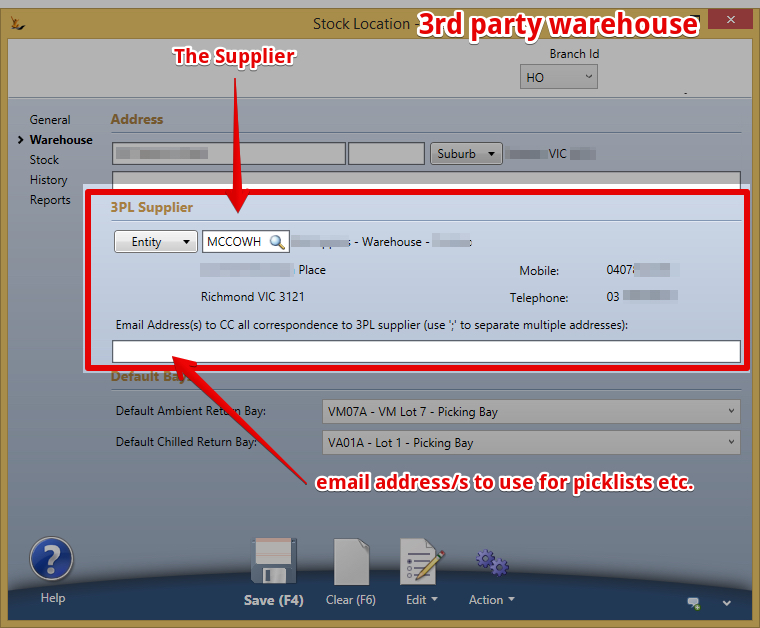Use Sidebar LHS to navigate
For global help click here
Purchase Order from PO to Goods Receipt
Where perishable goods are transacted the expiry date will be required
Table of contents
Overview
Each Purchase Order will be received by a warehouse from a supplier.
- Stock will then be moved from this warehouse to others using Inter warehouse Move Orders
- If a supplier is sending direct to multiple warehouses you will require multiple purchase orders
- Suppliers may send multiple shipments and invoices per purchase order (if flagged)
A purchase order for purchasing perishable stock may be created:
- While Forecasting - see Product Forecasting Based on Sales History
- Manually (described here)
Where Used Report - for recalls
The where used report is designed to find stock received from a supplier and look to see where it was used in manufacturing or sent to customers.
The where used report will find traceable stock based on expiry dates and lot numbers.
Find all customers that received the stock
Also used to create inter-company purchase orders
- when a Host Company (your business/s) Creditor is used as the supplier and will use the /wiki/spaces/SI/pages/33054894 linked to AutoEntity Type "HostCompany"
- A Matching sales order will be created in the Host Company (your business/s)
- When Invoices are created - matching invoices will be created in the related company.
For non-stock purchasing use Non-Stock Purchase Order
Sales Order at Risk Report
When Purchase Orders are Delayed - it is important to contact Wholesale Customers to modify their orders.
This report provides a
- List of sales orders indicating the number of order lines that are at risk
- The ability to open the product forecasting screen to view expected stock levels including inbound purchase orders
An email of the XLS will be sent to users at 1pm each day with secure feature Secure Features#ReceiveMarketplaceOrdersReport
Purchase Order Flow
Where to find purchase orders
Purchase Order Report
List of Purchase Orders that require Action
The Purchase Reports dashboard highlights all items that require action - note the legend at the bottom for details
Filter based on the role in the business to see the purchase orders that require action by that role.
Right click to open the related documents.
- Only shows the PO's that require action
- Brand is the predominant Brand on the PO
- If PO is being sent direct to the customer it will have the "DropShip Customer" column details including related Sales order
Drop Ship Purchase Orders (supplier sends directly to customer or printer)
Drop ship purchase orders have a delivery address that is not your address
- It could be a customers address
- It could be an address of supplier that changes it (eg prints onto a cup or makes soup from ingredients)
- It could be the address of a franchisee (when the PO has been placed by a Franchisor for direct shipment to franchisee)
If you do not want your suppliers to know your end customers addresses - then arrange the freight booking for a drop ship purchase order - the supplier documents will NOT include the address to be delivered to - it will only have the courier booking information.
Email of the PO Reports
Purchase Order report emails with summary information from the above are sent to users with any of:
- Secure Features#ReceivePurchaseOrderReport
- Secure Features#ReceivePurchaseOrderReportAllBranches
- Secure Features#ReceivePurchaseOrderOverdueReport
- Secure Features#ReceivePurchaseOrderWarehouseReport
Payments - timing of deposits and final payments
When suppliers expect deposits before starting work and final payment before releasing goods it is important to understand the cashflow implications and have a view of the timings of those
Can be viewed for next 8 weeks or for next 6 months. Summarised by currency with a total cumulative requirement in Host Company base currency.
Setting payment timings on a purchase order - if this is not set the calculation uses warehouse reciept + Terms
Note defaults can be set on the supplier
To enter deposit payments on Purchase Orders - see Purchase Order from PO to Goods Receipt#PurchaseOrderDeposits
Goods Received not Invoiced Account
Used to confirm the movements in the Goods Received Not Invoice Account (or landed cost accounts)
- Stock Receipt Journals
- Creditor invoices
Has one line for each Purchase Order
Shows all transactions, Opening balance, difference, closing balance
Purchase orders are always stock receipted before being invoiced. Proforma invoices are not journals.
Differences commonly occur when the PO has been received but not invoiced
- the invoiced quantity is different to the counted qty
- The receipt value is different to the invoice value
- see Purchase Order Variations
Move Orders
Move orders move stock from one warehouse to another. Examples include own warehouses and other places (like customers) where owned stock exists.
A Purchase Order that purchases stock for multiple warehouses - will create move orders when receipted to move stock from the receiving warehouse to the other warehouses.
This report shows all Move Orders that require attention - or have missing details
Managing Shipments - International Purchase Orders
This dashboard tracks key dates and required documents. Note that confirmed date column is the latest confirmed date of the dates that are tracked on the PO.
International Purchase orders have key dates to meet and require specific documentation at key times
- Proforma Invoice (supplied in advance of stock receipt and used by Customs)
- Bill of Lading
- Packing List
- Packing Declaration
Documents attached to a PO
Documents can be attached anytime to a Purchase Order - if they are missing when require then they show in the list
Some SKU's require additional certifying documents to be provided with each purchase order - some examples
- Fumigation - common with wood or outdoor furniture products
- Veterinary Health - common for products for pets
- TGA-ARTG (Australian Register of Therapeutic Goods) inspection
- Refrigerant check
Documents required with every shipment by SKU
This is where to indicate which SKU;s require documents with every shipment.
Expiring Certifications
It is also important to highlight any certifications on any SKU that will expiry in the next 12 months - eg
- Electrical Certifications
Viewing products on order and the % paid by product
The Purchase Reports view has a view of all purchase order lines in the system
From the Purchase Order Screen - finding a purchase order
Enter PO number.
Enter the supplier then do a search limited by the supplier.
Searching by supplier ref
Searching by shipping company ref
Purchase Order Register - The central list
On the Supplier
In the Forecasting screen
Expected Purchase Orders show in the forecasting screen
For a snapshot of the current situation of the items on this PO
To see detailed planning buckets over time across all products by supplier etc
See Product Forecasting Based on Sales History
In the Warehouse Shipments in/out screen
Used by the warehouse to track things that are arriving and departing the warehouse including purchase orders
Franchisee's receiving a Franchisor Drop Ship Purchase order from a supplier will have an asterix to indicate it is a Franchisor PO.
Building up a Purchase Order
Purchase orders may be created in a number of ways
- Manually - see below
- Upload of XLS sheet to Purchase order screen (commonly used if your warehouse holds 3PL stock with non EDI customer or on cutover) - SpreadsheetimporttoaddlinestoaPO
- From Sales Based Forecasting Screen - Product Forecasting Based on Sales History
- From Daily Purchasing Requirements Screen - Daily Purchase Order
- From a Drop Ship Sales Order Line see Drop Shipments - supplier sends direct to customer
- From Franchisor Replenishment Dashboard see Retail and Warehouse Stock Replenishment
When a Franchisee creates a Purchase Order to their Franchisor - when the Status moves to "Sent" a mirror Sales Order is created in the Franchisor.
A Franchisor can also create a Sales Order to a Franchisee - and when Authorised a mirror PO will be created in the Franchisee that will be used for receipting the goods
Regardless of how a Sales Order from a Franchisor to a Franchisee is created - when the Sales Order in the Franchisor creates a Debtor invoice - a mirror Creditor invoice linked to the PO in the Franchisee will be immediately created.
Purchase Order lines can also be updated by xls import.
- For example if a supplier is sent quantities and changes them to fit into shipping containers
- Use "Update lines" option when importing
- When a Dropship Purchase order quantities are updated > the corresponding sales order quantities will also be updated
Items that are only sold as JIT assembly can also be purchased using the JIT SKU. The stock receipt will list the kit components to be counted.
Add Supplier - some fields will pre-populate
Supplier related limits
The Filter items by supplier flag will make a smaller list when doing item searches
ETA for the lines will only have a value if different to the ETA on the header of the PO. You can update the ETA of a line from the PO screen
Foreign Currency Suppliers
When a supplier that is setup as a FX supplier - then the FX amounts will show
If a FX PO has GST an alert will show
Normally FX PO's should not be subject to GST.
If you have created one and it is incorrect then
- remove the incGST from the supplier company
- move the PO back to plan status
- Adjust a line qty or price (causes the entire PO to recalculate)
- then adjust it back and put the status back.
Checking recent purchase prices across suppliers
When negotiating with suppliers and prices rapidly change it is useful to have a view of recent prices
Note that the values are the last date for any Supplier + Price combination
Add multiple lines to the Purchase Order
Updating of pricing requires Secure Feature "Can Change Purchase Order Unit Cost"
- Unit Price is AUD price
- FC Price is Foreign Currency Price
- Value = Qty x Unit Price
- Notes is system generated notes
- Examples
- Expected Quarantine Start Date
- Split - multiple use by
- Split - part receipt
- if an intercompany purchase order then notes from the order lines
- Examples
- Other Quantities on the order line
- Shipped - once the supplier notifies you how many they have shipped
- Received - updated by the counting process as stock receipt
- Line Status - system generated
- Counted - once counted
- Cancelled - using right click menu on the line to cancel the line
- Closed once PO received
- ETA is set by the Purchase Order ETA and is used by planning and and sales orders
Spreadsheet import to add lines to a PO
Before importing an XLS spreadsheet > create a PO by choosing a supplier and saving
A two column spreadsheet (SKU, Qty) can be used to quickly add lines to a purchase order - this will use the default buy price on the SKU
A third column can be added (Price) to import the price - note if the supplier is a Foreign Currency Supplier then the price is assumed to be in the Foreign Currency
To import open transactions on mass
- Import Headers. Columns include - PO, Warehouse Code, Forwarder Ref, Supplier Code, Summary, ETA
- Import lines across Purchase orders by adding a column to the PO lines spreadsheet of (PO)
- SKU's that are in a status of Runout or Inactive will not be imported
- By default the SKU import process limits to the items with that supplier nominated as the primary supplier on the SKU - to enable the import process to import any SKU regardless of supplier untick the "Filter items by supplier" on the PO
Can also update lines on the order
When a purchase order is in Planning or Plan status updates can be made to the quantity and price for a SKU.
Columns required
- SKU, Price, Qty
When there is no default buy price for the item from that supplier
When the supplier is not one of the suppliers listed on the Article with a default buy price then the default buy price for the default supplier will default.
In this example the default supplier has a default buy price of $10 in AUD - the FX supplier we chose did NOT have a default buy price.
If the default supplier is a Foreign Currency Supplier then the default buy price will be in the foreign currency.
A warning will show when no buy price is found for the supplier.
Cancelling lines on a Purchase Order
Right click to cancel a line on the Purchase order > the cancelled line will still be on the purchase order however it will no longer be visible
- A log entry will be added to the PO log
- Note - if a complex landed cost exists AND manual costs have been associated to the line THEN the line cannot be cancelled until these have been removed
Re-instating a cancelled line
- Use the SKU to recall the line on the PO and press save on the line
- this will change the line status from "Cancelled" to "Plan" and the line will again be visible
- Note - Cancelled lines on Drop Ship Purchase orders CANNOT be re-instated due to requirement to re-instate the line on the sales order
Add attachments to the purchase order
Example shipping documents, supplier documents etc - see Useful things to know
Note that international purchase orders have a list of standard documents expected if they have a ship from port and ship to port - see Purchase Reports Dashboard#ManagingShipments-InternationalPurchaseOrders
Add Freight Charges to the Purchase Order
When a purchase order supplier also charges freight - add it to the purchase order.
Freight will be in the same currency as the creditor and FX currency will show adjacent to the field
Add Additional Charges to the Purchase Order
When a supplier charges additional charges there are two possible approaches
- Use landed costing to associate the charges to the stock cost > in this case a separate invoice (linked to the PO if you want) will be required
- Consider the costs to be expenses and not absorb them in product cost > in this case a SERVICE can be added as a purchase order line at any time up to status "Invoiced"
Send the Purchase Order documents and track correspondence
See Correspondence explained and Email Templates
Status menu > Email this Purchase Order to Supplier > PO status will move to "Sent"
Email will be sent to
- Any contact on the supplier with a role of type "Logistics"
- The Debtor email address (if above not found)
- The Company email address (if above not found)
Can send the PO manually with a preview / edit
- Edit the email and view the pdf attachment before you send it.
- Email Template = System usage "Manual" and System Context "Purchase Order"
In order to print the Purchase Order when in Plan Status you will need the Secure Feature "Can Authorise Purchase Orders"
If you want to attach a PDF of the purchase order
- Print Template YOURCOMPANYNAMEPurchaseOrder.mrt will be used - if not found then PurchaseOrder.mrt will be used
- XLS will also be attached with SKU, Barcode and Carton Barcode to each purchase order sent (if xls is attached)
- All emails sent of purchase orders will BCC if sender is setup as Company BCC
To set up a From email address for purchase orders sent via the 'Email this Purchase Order to supplier' status menu option:
- Admin menu, config, Contact/ID Types
- System Key, select Purchasing email
- Save (F4)
- Admin menu, Your Host Company, More tab
- Contact Info, Key, select Purchasing email
- Enter From email address in Detail
- Save Contact
Status Changes to track progress with suppliers
Can also manually change the status of a PO to keep track of where you are with the supplier.
- Planning - internal planning only and still being adjusted
- Plan - has been planned and is expected quantity
- Sent - has been sent to supplier
- Confirmed - quantities have been confirmed by supplier
- After status confirmed > changes to lines are tracked.
- so if the purchase order status is moved back to unconfirmed then plan and lines are added or removed - an audit trail exists
- After status confirmed > changes to lines are tracked.
- Departed Supplier - supplier notifies they have shipped
Updating Supplier Default Price
Updating supplier default price
Products that suppliers change price of frequently are easily updated from a PO after confirmed status
Right click (can multi-select lines) to update the supplier default price to be the PO price
If the supplier is not already on the SKU then it will be added
- if there is no default supplier as the default supplier
- if there is a default supplier - as an alternative supplier
Confirm Expected Date (and other key dates)
Use the Status Menu to lock the expected date - so you know it has been confirmed.
It can be unlocked at any time to be updated by using the status menu again - A log entry is written for the lock and the unlock process.
The shipments dashboard will indicate if dates have not been confirmed and are approaching
Users are warned if dates are not in the following sequence
- Confirmed date
- Production Start Date
- Supplier Departure EXW
- Port Departure ETD
- Port Arrival ETA
- Delivery ETA
Purchasing stock requirements for Multiple warehouses (move orders after receipt)
A single purchase order may have requirements for multiple warehouses - this can be managed manually or created via Product Forecasting Based on Sales History
Warehouse to Warehouse Stock Move Orders will be created to manage stock moves.
Review the distribution tab if the stock is being sent to other warehouses when it arrives
If you change the quantity on the purchase order line - the mismatch will show and need updating so all stock has a warehouse it is intended for
Once all the purchase order lines have been counted the system will create the required inter warehouse move orders
International Shipping Tracking and required actions
Where you use a shipping company you can import the details across all your international PO's. o import from a shipping company the shipping updates the columns required are:
- Order, Supplier Invoice, ex Factory date, Load port code, discharge port code, ETD, ETA at port, Est Delivered date, Arrival Vessel
Shipping is updated on the PO screen
Standard documents are required to be attached to international Purchase Orders - if they are missing they are listed as missing on the Managing Shipments Report
Managing Shipping Containers
On the purchase order you can track the shipping details
Finding Containers using search
Enter a partial match to the container name and click on the binoculars
All matches (and partials) will be listed and double click on the PO you want
Multiple shipping containers
It gets more interesting when the PO is across multiple shipping containers - because normally the local transport wants to drop and pick up in a single journey - so want you to tell them which container to bring first (and they then book the pickup times at the port). To decide which container to bring first you will want to know which container is carrying which products
- The Container # cannot be changed after a line has been Counted (Counted status).
- The Container # of a JIT kit cannot be changed after the kit has been exploded (on PO Received).
Link the PO line to a container
Container #'s can be cleared if required
Split lines across containers
Splitting items between Containers:
- If an item is split between containers then there will be 2 lines for the SKU.
- The line for the selected container will have the original Ordered quantity and a Shipped quantity of the Keep quantity entered in the Split pop-up.
- The other line will have no Ordered quantity and a Shipped quantity of the remainder, i.e. the first lines Ordered quantity minus the first lines Shipped quantity.
- JIT Kits can be split across containers
Count receipt by container
The when a container arrives - filter the PO by the container and do the counts. These will be added to stock and the PO will remain open waiting for the next container
Exploding JIT kits:
- Kits are exploded when the PO is marked as Received.
- A line will be added for each different component of a kit.
- The Ordered quantity of the component will be the Ordered quantity of the kit multiplied by the number of that component in each kit.
- If the kit has been split between containers it might not have an Ordered quantity so neither will the component.
- The Shipped quantity of the component will be set to the Shipped quantity of the kit, if any, multiplied by the number of that component in each kit.
- The component will have a setting of Not Billable.
- The component will have a zero price and value.
- The kit will have a setting of Exploded.
Landed Costing Estimates
There are two methods you can use for landed cost
Complex Landed Costs - Where landed costs are expected to be invoiced some time after the stock is in store (or sold) use the estimated landed cost capability. Use this method to allow the stock cost to reflect your expected costs and be updated later when the actuals come in. See Landed Costing for complete details
Simple Landed Costs - If not using estimates - you can use simple landed costing after the PO has been receipted. see Simple Landed Costing
JIT Kits can use both simple and complex landed cost calculations.
Building a landed cost estimate (complex landed cost required before stock receipt)
- Note that the user requires Secure Features Set Requires Landed Cost to set or clear the 'Requires Landed Cost' check box on a purchase order.
- Note that a landed cost can be created using the Landed Cost Estimate form (Purchase menu > Complex Landed Cost) and linked to a purchase order and this will set 'Requires Landed Cost' on the purchase order even if the user does not have the secure feature.
Enter details into the estimate
Note that multiple charges or actuals can be entered. See Landed Costing for complete details for example using actuals before stock arrives
Can enter foreign currency amounts for both estimates and actuals. They will resolve to Host Company currency equivalents.
Review the calculations
When ready set it ready to use.
Purchase Order Deposits
Any purchase order may have a deposit recorded. Use the Payments section to enter how you expect the deposit / final payment to be split.
Any number of deposits may be paid on a single purchase order. The amount of the deposit is added as a credit to the final invoice amount.
A creditor may have default payment terms
Entering a PO Deposit Payment
FX suppliers will have an FX value and FX rate to enter
Creates a Creditor Prompt Payment (Payment without Invoice)
Balance required to be paid
Foreign Currency Purchase Order Deposit Payments
Note after the first deposit - any number of deposits can be added to the PO and the paid amount will reflect the total value
The deposits paid reduce the final invoice amount to be paid
Payments via a clearing account - eg FX service
Some organisations may a single payment to a FX management company with instructions of payments to make.
- Link all the payments to a single Batch and to a clearing account
- Create a journal from the clearing account to the bank the amount was transferred from
Create a journal batch - and link the deposits to it
Note - in order for the batch to show up on the journal screen - select the journal type
Deposits will be to the clearing account
Create a journal from the clearing account to the bank
Adjust the journal type on the batch so the payment journal can be linked
Then check all the journals you want to link are linked
Close the batch
Batches that remain open will have new journals auto added to them until they are closed
Purchase Reports - Required Payments Tab
Indicates when payments are required for Purchase Orders in the system.
If a PO does not have payment terms then it is assumed that no prepayments will be required. The invoice will be raised when the PO is received and the terms of the supplier are added to the payment due date.
Purchase Reports - Shipments Tracking Tab
Can see if a purchase order has had a deposit paid - this can be critical to ensure the supplier has started.
Receiving the Purchase order - In Out Dashboard
The In/Out dashboard lists all inbound and outbound stock and is where to find PO's that are expected in a warehouse. Only items that are expected in the date range are displayed.
Inbound:
- Purchase Orders
- Franchisor Drop ship Purchase Orders arriving direct at Franchisee
- Franchisor Drop Ship via Warehouse Purchase Orders arriving after being checked at the Franchisor Warehouse
- Move Orders from other warehouses in the same ABN
- Special Orders expected from a Francisor
- Fabrications Expected
Outbound
- Sales Orders being picked up or sent to customers or Franchisees
- Waybills departing on a vehicle
- Franchisor Drop Ship via Warehouse Purchase Orders that have been checked
- Special Orders ready to ship
- Deliveries for Project Orders
There are multiple ways to receive Purchase Orders
Simple Stock Receipt without count
Where the stock does NOT require expiry dates or batches or counting - it can be receipted in a single click
Scan every stock item that has arrived to compare with expected
When stock does NOT require batch or expiry details - can scan all items received and compare with ordered quantity
Count the stock and enter batch and expiry dates
Select a purchase order from the list on the Warehouse in/out Dashboard
If an order has not been marked as received the user will be prompted
The system will prompt if the PO should be marked as Received - note you can review the list of items on the PO before making it as received.
If perishable items are included the temperature of each container can be tracked.
Staging Locations
Each warehouse may have multiple staging locations
Choose the locations you will put the stock after counting and before put away. Staging locations are temporary locations where stock is check counted before putaway.
If you are not using a staging location - the system will recommend put away based on stock history / available spaces.
The staging locations must be "Floor Area" locations and flagged as "Staging Area Temporary Storage"
Organisations with a coarse warehouse use a system recommendation for put away and avoid staging area requirement.
Count the Stock
- Enter the quantity reported by the supplier (found on the shipping documents)
- Count the stock - capture useby / batch number / Serial number (if capture is on receipt not on sale)
JIT Kit parents will not be listed on the Stock Receipt form - only the components will be listed
If the PO uses Containers then a choice will be required and will filter the grid and the actions. When "Process all Counted lines in Plan Status" clears all lines in a container the grid will change to show the next container with lines still in plan status from the PO.
You can be part way through the count - while moving stock that has been counted away.
BUT - Each line must be completely counted before it is stocked.
Lines can be short counted and the system will ask if the line should be split to be counted later or received later
Short dated stock is captured at point of receipt
If expiry dated products are received and the expiry days is less than the minimum required
The date on the stock is compared with:
- Field on Article (Article form, Extended Attributes, Sell Rate and Forecast, 'Default Expiry Days')
- if not found then Field on Supplier (Creditor form, Supplier tab, 'Default Use by days')
An email is sent to the Roles with the secure feature Secure Features#ReceiveShortDatedReceiptAlert for this branch on each event of short dated items.
The stock is indicated as a short dated receipt on Short dated stock exception report in the 'Short dated receipt' column at the right of the report. The column will be blank if the stock was not short dated on receipt.
When the supplier sends you more than you have ordered
When the supplier has sent you less than you have ordered (or you need to split the receipt to account for multiple use by dates or container or partial put away)
When the supplier has sent you at item you did not expect
Add the new line to the purchase order
When a JIT Kit is been purchased from a supplier
The kit is never stocked. Only the components are in stock and kitted together when a kit is sold
The counting screen will shows the kit components - JIT Kits lines are created for the components when the PO is marked as received.
- A line will be added for each different component of a kit.
- The Ordered quantity of the component will be the Ordered quantity of the kit multiplied by the number of that component in each kit.
- If the kit has been split between containers it might not have an Ordered quantity so neither will the component.
- The Shipped quantity of the component will be set to the Shipped quantity of the kit, if any, multiplied by the number of that component in each kit.
- The component will have a setting of Not Billable.
- The component will have a zero price and value.
- The kit will have a setting of Exploded.
The average cost used is the price of the kit divided by the number of components plus any Landed Costing amounts. A kit with qty 3 of item A and qty 2 of item B will have average cost of JIT / 5 for each component.
The kit is not counted - it has the count updated by the count of the components on the PO to the minimum number of kits that could be assembled by the count. Ie if one item is short the kit count will be short.
The counted items are not invoiced - only the kit item is invoiced using the counted qty
Updating Sell prices based on Purchase Prices
Can update the sell price and RRP price on an item from the purchase order
Partially shipped (and invoiced) Purchase Orders
If the supplier has only shipped some items - and has sent an invoice for those items - count only those lines, leave the other lines uncounted.
If the supplier has "Allow Partial PO invoices" then an invoice can be created for lines counted but not invoiced leaving other lines awaiting counting.
- Purchase Order > Status > Create Partial Invoice
- Can create invoice only for lines with an invoice quantity instead of all lines counted > Create a partial invoice, of lines with Inv Qty, in Counted status, but not invoiced
Notes
- If a PO line has been invoiced in a partial invoice then 'Invoiced' will show in the Settings column of the PO form Order Lines grid and 'YES' will show in the Invoiced column of the Standard Stock Receipt grid.
- The Invoiced column will not show unless the supplier of the PO has 'Allow PO partial invoice' ticked.
- If the PO being partially invoiced has a Delivery charge then
- this will be on the first supplier invoice created.
- If the PO being partially invoiced has a Delivery charge then this will be apportioned to the PO lines by value calculated as ordered quantity x price.
- If there is less stock than the ordered quantity at the time that the PO line is received then only a proportion of the delivery charge will be allocated to the stock asset account.
- The average cost of the article will be recalculated to include the allocated delivery charge.
- Status menu option 'Create a partial invoice, of lines with Inv Qty, in Counted status, but not invoiced'.
- Similar to 'Create a partial invoice, of lines in Counted status but not invoiced' but it will not invoice using the Counted quantity if no Invoice quantity is entered.
- 'Part invoice total' will show in place of 'Invoice total' at top of Ship/Invoice Qty tab.
- Shows total of items in Counted status, with an Invoice quantity and not yet invoiced, i.e. the total that would be invoiced by the 'Create a partial invoice, of lines with Inv Qty, in Counted status, but not invoiced' status menu option.
Process All Counted Lines in Plan Status to Create Stock (updates Average cost )
This can be done multiple times for each purchase order as stock is counted.
Stock Received Not invoiced Account
The Stock Receipt Journal will update the "Goods Received not Invoiced" GL Account and the "Stock on Hand" Control Account from from GL Control Accounts
- If an item ordered on a drop-ship via warehouse PO is GST inclusive then the franchisee buy price is the franchisor default sell price minus the tax
When the Creditor invoice is created the journal will update the "Goods Received not invoiced" GL account and the Trade Creditors GL Account from GL Control Accounts
see Purchase Order Variations for more details
Average Cost
Average cost is updated in the following situations
- Stock is created from the purchase order
- Average cost = total value of stock / total stock
- When stock is added by a PO = New average cost = ( Total Value of stock before + Total Value of stock added ) / Total stock qty after new stock added
- Where
- Total Value of stock before = Stock on Hand x Average cost
- Total Value of stock added = new stock being added x cost of this stock
- Stock added by Purchase Order may include - see also Pricing when you sell products
- Freight cost on the PO to the same supplier
- Finance Uplift Charges if using finance to purchase
- Landed costs (see Landed Costing )
- Stock added by Purchase Order may include - see also Pricing when you sell products
Average cost may also be updated manually by a user with Authority directly on the SKU and this will create the required corresponding stock revaluation journals.
When the PO is ready to invoice any discrepancies in counted vs ordered quantity are prompted for action
This will occur in the warehouse if set as the preference to invoice purchase orders based on stock receipt. Otherwise this will occur when the supplier invoices is raised later.
What do you want to do with the additional items ?
- An adjustment invoice is a separate invoice (or credit) for the additional items received (see below)
- A general journal example is shown below
For a user to be able to invoice and close a PO with discrepancies - they will need Secure Features Close Purchase Order With Discrepancy
To receive an email every time a PO has order vs invoice or invoice vs count discrepancies Secure Features # ReceiveP O Invoice Discrepancies
Example of JIT item variance in Goods Received Not Invoiced Account
JIT items are a special case
- stock is created of the components - but that SKU is never invoiced
- An invoice is created for the JIT item - but no stock is created
- Hence a variance is recorded to account for both these differences (you can find it linked to the PO)
Adjustment Journal to write off excess stock received
Both short deliveries and over deliveries will be journaled
Used if you are not expecting to be charged by your supplier for the additional items counted - the qty counted is receipted at average cost and the additional stock value for the additional items is then removed.
Put the stock away
Stock that is going into the warehouse is then put away from the staging locations
The stock locations will default for all items that:
- Have a default stock location on the article - to the default location
- or - have stock in a location at the moment - to the current stock location
Quantities will default to full pallets
- If the item does not have a Pallet Capacity then Quantity will default to 0.
- if a pallet of the stock is less than the Total Quantity to be moved then Quantity will default to the pallet capacity
- A Pallet of the stock = Units Per Layer (Selling/shipping) multiplied by Layers Per Unit
Stock that is expected to go onto a move order can be put away. If your move order is intended to leave immediately it is recommended to pick the move order before putting stock away.
If an item that is being put away could also be put on a Move order (ie it is in plan status and not yet picked) then it will be highlighted and a legend will indicate that the line is in a Move Order. Right click on the highlighted line will list the move orders in a sub menu.
Creating the Creditor Invoice/s
Invoiced Quantities from the supplier need to be entered before the purchase order can be Invoiced or Closed
Invoiced amounts can be entered before or after the stock has been counted and put away
A Received Purchase Order that has not been Invoiced or Closed will be highlighted on the purchase order reports
Multiple invoices on a Purchase Order
can be created per purchase order if the supplier has "Allow PO Partial Invoice" ticked.
Choose "Create partial invoice" and an invoice will be created for only those lines with an invoice quantity that have not already been invoiced.
These purchase orders can end up with many lines and many invoices. When entering new invoices it is helpful to hide those lines that have (1) already been invoiced and (2) an invoice quantity has been entered (even if not yet invoiced)
No invoiced lines hidden
Invoiced lines hidden
Lines with an invoice quantity hidden
Anytime - can enter the supplier invoice number and supplier invoice date.
Note that entering the supplier invoice number will cause the purchase reports to show the date the invoice has been received from the supplier
The Supplier Invoice Number and Date PO form Ship/Invoice Qty tab. Both of these fields are saved in the PO when the Save Supplier Invoice button is clicked.
- If the invoice has not been created
- then the Supplier Invoice Ref will be copied to the "Their Invoice No" field of the invoice and the date will be used as the Invoice Date when the invoice is created.
- If the invoice has already been created
- then these fields will be copied to the invoice when the Save Supplier Invoice button is clicked and over-write the existing values.
There is also an Invoice Total field on the PO form Ship/Invoice Qty tab that shows the PO total value including tax and Delivery.
This field will change when the Delivery, Unit Price or Inv Qty are updated.
Update the Invoiced Quantities from the supplier invoice
This can be done prior to receipt or after receipt of stock
Can enter Supplier invoice number and invoice FX rate to be used (it may be different to PO rate)
If you have the secure feature :Set P O Inv Qty To Counted
- New Status menu option 'Set Inv Qty to Counted where Counted = Ordered' if:
- PO is Received, Counted or Closed.
- At least one PO line is eligible.
- Option will set Inv Qty to Counted if:
- Inv Qty has no value.
- Counted = Ordered.
- Line is not cancelled
If the Invoiced amount is less than the ordered amount - or you need to split the line for pricing reasons or are partially invoicing the PO can enter a smaller amount for the invoiced quantity. For example if some stock was at a different price.
If splitting the line
If adding an unexpected item to the PO
Result
Purchase Discount
If a supplier provides a purchase discount you can decide how to account for it.
- Entered before the PO has been received will reduce the stock average cost (and hence affect sales order profit etc)
- Entered after the PO has been received will be journalled to a Purchase Price variance account (and not affect stock value)
The created journals
Create Creditor Invoice
When finished - Status > Close and invoice. Any discrepancies will be prompted for action as per above.
If price on the creditor invoice is different to the price on the purchase order and used on the stock receipt journal - see Purchase Order Variations
If supplier has "Allow PO Partial Invoice" ticked then the PO will only become closed and invoiced once all lines have been invoiced.
PO Deposit overpayment:
When creating an invoice for a Purchase Order,
- if the total of deposits paid is greater than the total of goods and freight
- then add an invoice line to move the excess deposit back to the PO Deposits GL account
- and create a credit note for the supplier for the excess amount.
Creditor - view of deposits
Creditor > Supplier Deposits
PO Deposit - convert to a credit note
Creditor Prompt Payment form
if sub type id Order Deposit and deposit is not linked to an invoice:
If deposit is linked to a PO then the link must be cleared before the deposit can be cleared.
If not linked to a PO then show an option to convert the PO deposit to a creditor credit note.
If selected then open a creditor credit note with fields pre-filled.
User must Save.
Deposit will be reversed when credit note is saved.
Creditor Credit Note - ability to convert to a supplier deposit
Creditor Credit Note, Action menu:
If credit note has allocations then show a message to remove the allocations before converting to a PO deposit.
If no allocations then show an option to convert credit note to a PO deposit.
If selected, open a PO deposit form with fields pre-filled.
User must link to a PO and Save.
Order must be a purchase order, not cancelled, closed or invoiced.
Credit note will be reversed when PO deposit is saved.
PO Deposit - convert to a credit note
Creditor Prompt Payment form
if sub type id Order Deposit and deposit is not linked to an invoice:
If deposit is linked to a PO then the link must be cleared before the deposit can be cleared.
If not linked to a PO then show an option to convert the PO deposit to a creditor credit note.
If selected then open a creditor credit note with fields pre-filled.
User must Save.
Deposit will be reversed when credit note is saved.
PO and Sales Order Deposits can be reversed
Allow debtor and creditor prompt payments to be reversed.
Reverse Creates a general journal.
When reversing a foreign currency journal ensure that the foreign currency amount is allocated between the journals
Simple landed costing - after items received into warehouse
Simple landed cost allows the stock to be created using only the PO supplier creditor invoice and then later adding associated charges.
Simple landed cost is not recommended for fast moving stock - see Landed cost options explained
Notes for JIT KITS
Simple Landed Cost tab, Purchase Order Items grid:
- Do not allocate costs on a PO with a kit until the PO has been received and the kit has been exploded into its components.
- A kit is an article with an Assembly type of JIT and/or the Exploded setting.
- PO items with kits will be displayed highlighted green.
- The Auto column check box will not be ticked and will be disabled.
- The kit will not participate in Auto Allocation.
- The Added costs column will be disabled.
- A kit component is an item exploded from a kit when the PO is received.
- The PO ea of a component is calculated by dividing the unit price of the kit by the number of components in the kit (not the number of different components).
Stock that is to be moved to another warehouse (Move Orders)
This only applies for Warehouses that are part of the same Host Company. Stock going to a franchisee or different host company are being sold.
Move orders are created for you by the Purchase Order
When the stock is counted into the temporary locations - move orders are created by the system to move the stock to other warehouses based on the purchase order distribution
Enter a planned date
Review the move orders and enter a planned date they are to be sent - they will then show in the shipments expected screens
The planned delivery date will default based on the Interwarehouse Transport settings for standard times to move stock between warehouses.
Enter the delivery method. The list of delivery methods are
- Your company
- Any Supplier with Standard Profile value = "Courier" (note turn on this profile on Host Company (your business/s))
Right click from the shipments expected screen to pick the move order
Pick the move order
Right click on a line to be picked to default pick
Right click on a stock location to pick the required full amount from that location
Enter the Consignment Note Number to mark the stock as in transit
Delivery method can be entered as text - or chosen from a list of previously used delivery methods.
Delivery Entity can be your Host Company (your business/s) or any Supplier flagged as "Is Courier" (enable this flag on Host Company)
The stock is no longer in either warehouse - but because you still own the stock - a temporary warehouse will have been created in the Despatching warehouse
Receive the stock when it arrives in the other warehouse
The expected shipments screen will show the move in order in the receiving warehouse
Count the stock and mark any discrepancies created
Then put the stock away (as shown in stock put away above)
Resetting Sell Prices after stock has arrived
It is common that the price stock is sold at is related to it's recent cost. To make this easier there is a tab on the purchase order for this
Franchisor Setting Sell Price to Franchisees
The average cost is shown - however if a landed cost has not been used to value the stock then a % markup can be used to show what the cost are after a nominal landed cost
Set all the lines as ready to reprice, enter a landed cost markup % then review and adjust line by line
View the margins for the Franchisor and for the Franchisee for each item
Can modify the landed costs for an individual line - view the margins earn't by franchisor
Result
Updating the Sell price (or Markup)
Result
Configurations Required
Min Stock Days of expiry on the Article - used to test if the expiry date entered is as agreed by the supplier as min they will send you
Default use by days on the supplier - if no value on the Article the supplier value for min agreed useby days will be used. Normally you will set this to the value for the majority of the stock they send you so you only have to over-ride on the Article those that need it.
Working with 3rd Party Warehousing
3rd party warehouses do not normally update the system for you directly.
Receiving Stock into a 3rd Party Warehouse
- Update the purchase order as counted and stocked as normal
Picking stock from a 3rd party warehouse
Use the 3PL Picking Dashboard to find all orders to pick, select an email template to use, update it and then send an email with all picking slips
The picking slips will be created and then zipped and emailed (note that this may involved multiple emails depending on the volume)
Use the Despatched Orders (3PL) to update the list of orders that were sent once you have been notified the results - this will update the orders and the stock as picked
Settings
To enable the setting "Allow PO Partial Invoice" on the supplier - enable on the host company > Entity and Debtor / Creditor Profiling
Working as a 3rd Party Warehouse
If your warehouse holds other companies stock
- Set the average cost, the sell price and buy price to zero
- Create Purchase Orders to receipt stock at zero dollars
- can import xls sheet on PO screen to create easily
- can provide the stock owner a screen to upload directly to your system
- receipt and put away same as other stock
- Stock will be created at zero dollars and will not affect your balance sheet
- Creditor invoice will be created at zero dollars and can be emailed as proof of processing
- Create Sales Orders to ship the stock at zero dollars
- Can import xls sheet on sales orders screen to create large orders easily
- Can import xls sheet on sales orders screen to mass create large number of orders in single process
- Can provide the stock owner a screen to upload directly to your system
- then pick / pack / ship the stock
- Sales Invoice will be created but at zero dollars and can be emailed as proof of processing
- If using Marketplace Orders - a tracking number will be added by the scanning process
For information about SaaSplications go to http://saasplications.com.au
